London 18th century poverty Stock Photos and Images
(136)See london 18th century poverty stock video clipsQuick filters:
London 18th century poverty Stock Photos and Images
 GEORGIAN LONDON - poor people receiving charity from a rich person's household Stock Photohttps://www.alamy.com/image-license-details/?v=1https://www.alamy.com/stock-photo-georgian-london-poor-people-receiving-charity-from-a-rich-persons-29603477.html
GEORGIAN LONDON - poor people receiving charity from a rich person's household Stock Photohttps://www.alamy.com/image-license-details/?v=1https://www.alamy.com/stock-photo-georgian-london-poor-people-receiving-charity-from-a-rich-persons-29603477.htmlRMBM4FF1–GEORGIAN LONDON - poor people receiving charity from a rich person's household
 Tempest's Cries of London, Boy and girl selling laces, long and strong, 18th Century British History, Vintage Illustration Stock Photohttps://www.alamy.com/image-license-details/?v=1https://www.alamy.com/tempests-cries-of-london-boy-and-girl-selling-laces-long-and-strong-18th-century-british-history-vintage-illustration-image553346451.html
Tempest's Cries of London, Boy and girl selling laces, long and strong, 18th Century British History, Vintage Illustration Stock Photohttps://www.alamy.com/image-license-details/?v=1https://www.alamy.com/tempests-cries-of-london-boy-and-girl-selling-laces-long-and-strong-18th-century-british-history-vintage-illustration-image553346451.htmlRM2R47317–Tempest's Cries of London, Boy and girl selling laces, long and strong, 18th Century British History, Vintage Illustration
 The house of Oliver Goldsmith (1728-1774), in Green Arbour Court, Old Bailey and Breakneck Stairs, London, was the residence of Oliver Goldsmith in 1758. The Irish novelist, playwright and poet, was best known for his novel The Vicar of Wakefield (1766), his pastoral poem The Deserted Village (1770), and his plays The Good-Natur'd Man (1768) and She Stoops to Conquer (1771, first performed in 1773). Stock Photohttps://www.alamy.com/image-license-details/?v=1https://www.alamy.com/the-house-of-oliver-goldsmith-1728-1774-in-green-arbour-court-old-bailey-and-breakneck-stairs-london-was-the-residence-of-oliver-goldsmith-in-1758-the-irish-novelist-playwright-and-poet-was-best-known-for-his-novel-the-vicar-of-wakefield-1766-his-pastoral-poem-the-deserted-village-1770-and-his-plays-the-good-naturd-man-1768-and-she-stoops-to-conquer-1771-first-performed-in-1773-image234952625.html
The house of Oliver Goldsmith (1728-1774), in Green Arbour Court, Old Bailey and Breakneck Stairs, London, was the residence of Oliver Goldsmith in 1758. The Irish novelist, playwright and poet, was best known for his novel The Vicar of Wakefield (1766), his pastoral poem The Deserted Village (1770), and his plays The Good-Natur'd Man (1768) and She Stoops to Conquer (1771, first performed in 1773). Stock Photohttps://www.alamy.com/image-license-details/?v=1https://www.alamy.com/the-house-of-oliver-goldsmith-1728-1774-in-green-arbour-court-old-bailey-and-breakneck-stairs-london-was-the-residence-of-oliver-goldsmith-in-1758-the-irish-novelist-playwright-and-poet-was-best-known-for-his-novel-the-vicar-of-wakefield-1766-his-pastoral-poem-the-deserted-village-1770-and-his-plays-the-good-naturd-man-1768-and-she-stoops-to-conquer-1771-first-performed-in-1773-image234952625.htmlRMRJ70D5–The house of Oliver Goldsmith (1728-1774), in Green Arbour Court, Old Bailey and Breakneck Stairs, London, was the residence of Oliver Goldsmith in 1758. The Irish novelist, playwright and poet, was best known for his novel The Vicar of Wakefield (1766), his pastoral poem The Deserted Village (1770), and his plays The Good-Natur'd Man (1768) and She Stoops to Conquer (1771, first performed in 1773).
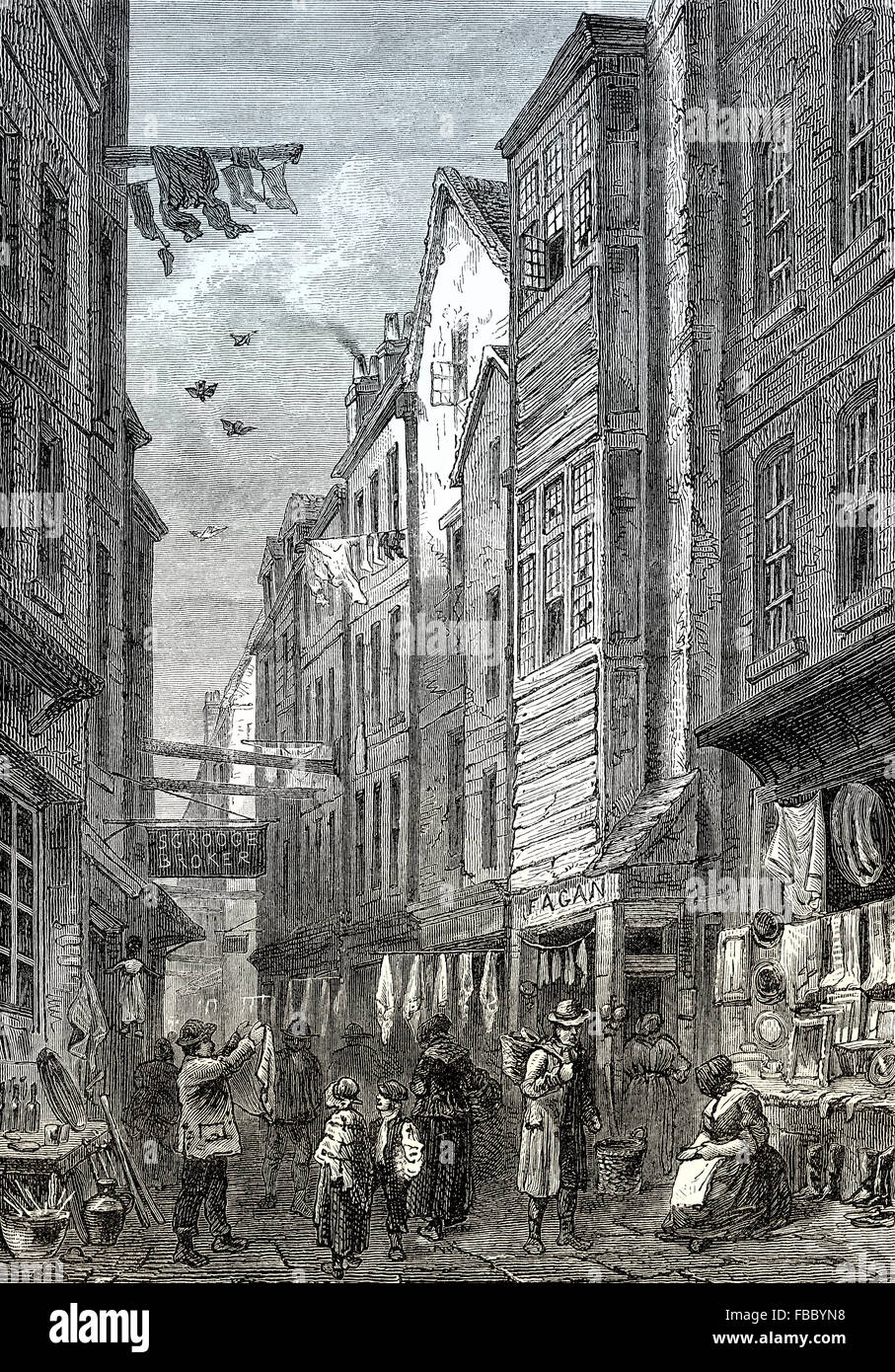 Field lane, London, England, 1840 Stock Photohttps://www.alamy.com/image-license-details/?v=1https://www.alamy.com/stock-photo-field-lane-london-england-1840-93076292.html
Field lane, London, England, 1840 Stock Photohttps://www.alamy.com/image-license-details/?v=1https://www.alamy.com/stock-photo-field-lane-london-england-1840-93076292.htmlRMFBBYN8–Field lane, London, England, 1840
 'A Rake's Progress - 6: The Gaming House', 1733. Artist: William Hogarth. Stock Photohttps://www.alamy.com/image-license-details/?v=1https://www.alamy.com/a-rakes-progress-6-the-gaming-house-1733-artist-william-hogarth-image262788648.html
'A Rake's Progress - 6: The Gaming House', 1733. Artist: William Hogarth. Stock Photohttps://www.alamy.com/image-license-details/?v=1https://www.alamy.com/a-rakes-progress-6-the-gaming-house-1733-artist-william-hogarth-image262788648.htmlRMW7F1GT–'A Rake's Progress - 6: The Gaming House', 1733. Artist: William Hogarth.
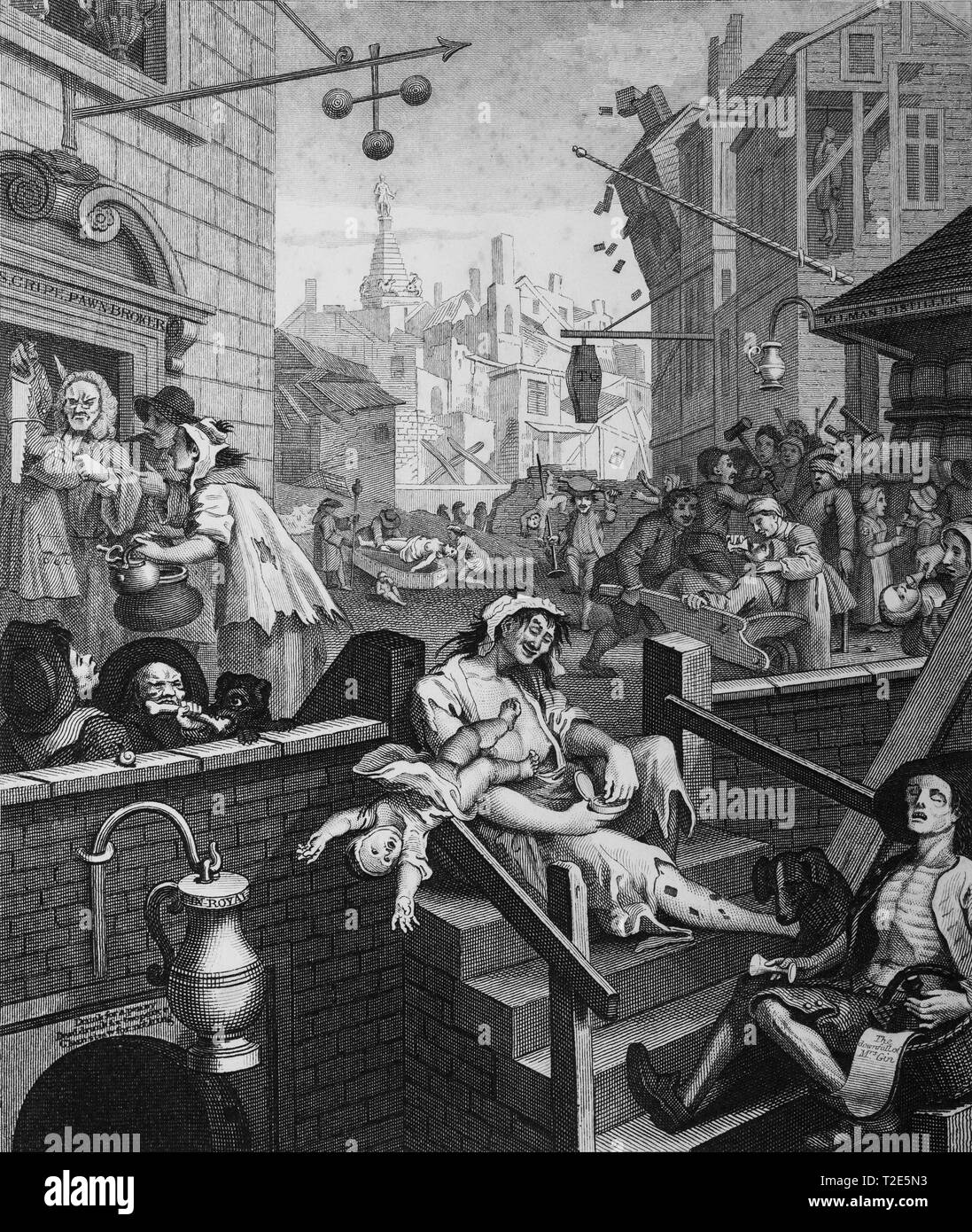 William Hogarth print engraving Beer Street and Gin Lane Gin Lane Stock Photohttps://www.alamy.com/image-license-details/?v=1https://www.alamy.com/william-hogarth-print-engraving-beer-street-and-gin-lane-gin-lane-image242486303.html
William Hogarth print engraving Beer Street and Gin Lane Gin Lane Stock Photohttps://www.alamy.com/image-license-details/?v=1https://www.alamy.com/william-hogarth-print-engraving-beer-street-and-gin-lane-gin-lane-image242486303.htmlRMT2E5N3–William Hogarth print engraving Beer Street and Gin Lane Gin Lane
 'A Rake's Progress', 1735; plate IV of VIII. Artist: William Hogarth Stock Photohttps://www.alamy.com/image-license-details/?v=1https://www.alamy.com/a-rakes-progress-1735-plate-iv-of-viii-artist-william-hogarth-image60075819.html
'A Rake's Progress', 1735; plate IV of VIII. Artist: William Hogarth Stock Photohttps://www.alamy.com/image-license-details/?v=1https://www.alamy.com/a-rakes-progress-1735-plate-iv-of-viii-artist-william-hogarth-image60075819.htmlRMDDMK8Y–'A Rake's Progress', 1735; plate IV of VIII. Artist: William Hogarth
 FOUNDLING HOSPITAL, Lamb's Conduit Fields, Bloomsbury, London, in a 1753 engraving. Founded by Thomas Coram Stock Photohttps://www.alamy.com/image-license-details/?v=1https://www.alamy.com/foundling-hospital-lambs-conduit-fields-bloomsbury-london-in-a-1753-engraving-founded-by-thomas-coram-image351462673.html
FOUNDLING HOSPITAL, Lamb's Conduit Fields, Bloomsbury, London, in a 1753 engraving. Founded by Thomas Coram Stock Photohttps://www.alamy.com/image-license-details/?v=1https://www.alamy.com/foundling-hospital-lambs-conduit-fields-bloomsbury-london-in-a-1753-engraving-founded-by-thomas-coram-image351462673.htmlRM2BBPE69–FOUNDLING HOSPITAL, Lamb's Conduit Fields, Bloomsbury, London, in a 1753 engraving. Founded by Thomas Coram
 View of Horse Guards, Westminster, London, 1768. Artist: Edward Rooker Stock Photohttps://www.alamy.com/image-license-details/?v=1https://www.alamy.com/view-of-horse-guards-westminster-london-1768-artist-edward-rooker-image60220446.html
View of Horse Guards, Westminster, London, 1768. Artist: Edward Rooker Stock Photohttps://www.alamy.com/image-license-details/?v=1https://www.alamy.com/view-of-horse-guards-westminster-london-1768-artist-edward-rooker-image60220446.htmlRMDDY7P6–View of Horse Guards, Westminster, London, 1768. Artist: Edward Rooker
 18th century Child token, given to the Foundling Hospital in London. Mothers left tokens with their babies, so that, if circumstances improved for them, the mothers could reclaim their children. The Foundling Hospital in London, England, was founded in 1739 by the philanthropic sea captain Thomas Coram. It was a children's home established for the 'education and maintenance of exposed and deserted young children Stock Photohttps://www.alamy.com/image-license-details/?v=1https://www.alamy.com/18th-century-child-token-given-to-the-foundling-hospital-in-london-mothers-left-tokens-with-their-babies-so-that-if-circumstances-improved-for-them-the-mothers-could-reclaim-their-children-the-foundling-hospital-in-london-england-was-founded-in-1739-by-the-philanthropic-sea-captain-thomas-coram-it-was-a-childrens-home-established-for-the-education-and-maintenance-of-exposed-and-deserted-young-children-image328361710.html
18th century Child token, given to the Foundling Hospital in London. Mothers left tokens with their babies, so that, if circumstances improved for them, the mothers could reclaim their children. The Foundling Hospital in London, England, was founded in 1739 by the philanthropic sea captain Thomas Coram. It was a children's home established for the 'education and maintenance of exposed and deserted young children Stock Photohttps://www.alamy.com/image-license-details/?v=1https://www.alamy.com/18th-century-child-token-given-to-the-foundling-hospital-in-london-mothers-left-tokens-with-their-babies-so-that-if-circumstances-improved-for-them-the-mothers-could-reclaim-their-children-the-foundling-hospital-in-london-england-was-founded-in-1739-by-the-philanthropic-sea-captain-thomas-coram-it-was-a-childrens-home-established-for-the-education-and-maintenance-of-exposed-and-deserted-young-children-image328361710.htmlRM2A264KX–18th century Child token, given to the Foundling Hospital in London. Mothers left tokens with their babies, so that, if circumstances improved for them, the mothers could reclaim their children. The Foundling Hospital in London, England, was founded in 1739 by the philanthropic sea captain Thomas Coram. It was a children's home established for the 'education and maintenance of exposed and deserted young children
 Street entertainers, Cries of London, 1760. Artist: Paul Sandby Stock Photohttps://www.alamy.com/image-license-details/?v=1https://www.alamy.com/street-entertainers-cries-of-london-1760-artist-paul-sandby-image60088497.html
Street entertainers, Cries of London, 1760. Artist: Paul Sandby Stock Photohttps://www.alamy.com/image-license-details/?v=1https://www.alamy.com/street-entertainers-cries-of-london-1760-artist-paul-sandby-image60088497.htmlRMDDN7DN–Street entertainers, Cries of London, 1760. Artist: Paul Sandby
 18th century Child token, given to the Foundling Hospital in London. Mothers left tokens with their babies, so that, if circumstances improved for them, the mothers could reclaim their children. The Foundling Hospital in London, England, was founded in 1739 by the philanthropic sea captain Thomas Coram. It was a children's home established for the 'education and maintenance of exposed and deserted young children Stock Photohttps://www.alamy.com/image-license-details/?v=1https://www.alamy.com/18th-century-child-token-given-to-the-foundling-hospital-in-london-mothers-left-tokens-with-their-babies-so-that-if-circumstances-improved-for-them-the-mothers-could-reclaim-their-children-the-foundling-hospital-in-london-england-was-founded-in-1739-by-the-philanthropic-sea-captain-thomas-coram-it-was-a-childrens-home-established-for-the-education-and-maintenance-of-exposed-and-deserted-young-children-image328361718.html
18th century Child token, given to the Foundling Hospital in London. Mothers left tokens with their babies, so that, if circumstances improved for them, the mothers could reclaim their children. The Foundling Hospital in London, England, was founded in 1739 by the philanthropic sea captain Thomas Coram. It was a children's home established for the 'education and maintenance of exposed and deserted young children Stock Photohttps://www.alamy.com/image-license-details/?v=1https://www.alamy.com/18th-century-child-token-given-to-the-foundling-hospital-in-london-mothers-left-tokens-with-their-babies-so-that-if-circumstances-improved-for-them-the-mothers-could-reclaim-their-children-the-foundling-hospital-in-london-england-was-founded-in-1739-by-the-philanthropic-sea-captain-thomas-coram-it-was-a-childrens-home-established-for-the-education-and-maintenance-of-exposed-and-deserted-young-children-image328361718.htmlRM2A264M6–18th century Child token, given to the Foundling Hospital in London. Mothers left tokens with their babies, so that, if circumstances improved for them, the mothers could reclaim their children. The Foundling Hospital in London, England, was founded in 1739 by the philanthropic sea captain Thomas Coram. It was a children's home established for the 'education and maintenance of exposed and deserted young children
 Mock funeral procession in St Giles, London, 1751. Artist: Anon Stock Photohttps://www.alamy.com/image-license-details/?v=1https://www.alamy.com/mock-funeral-procession-in-st-giles-london-1751-artist-anon-image60108791.html
Mock funeral procession in St Giles, London, 1751. Artist: Anon Stock Photohttps://www.alamy.com/image-license-details/?v=1https://www.alamy.com/mock-funeral-procession-in-st-giles-london-1751-artist-anon-image60108791.htmlRMDDP5AF–Mock funeral procession in St Giles, London, 1751. Artist: Anon
 The Hay Cart, 1779. Francis Wheatley (1747-1801). This painting shows a group of 18th century farm labourers harvesting hay. It is now housed at Lancaster House, London. Stock Photohttps://www.alamy.com/image-license-details/?v=1https://www.alamy.com/the-hay-cart-1779-francis-wheatley-1747-1801-this-painting-shows-a-group-of-18th-century-farm-labourers-harvesting-hay-it-is-now-housed-at-lancaster-house-london-image568855719.html
The Hay Cart, 1779. Francis Wheatley (1747-1801). This painting shows a group of 18th century farm labourers harvesting hay. It is now housed at Lancaster House, London. Stock Photohttps://www.alamy.com/image-license-details/?v=1https://www.alamy.com/the-hay-cart-1779-francis-wheatley-1747-1801-this-painting-shows-a-group-of-18th-century-farm-labourers-harvesting-hay-it-is-now-housed-at-lancaster-house-london-image568855719.htmlRM2T1DH7K–The Hay Cart, 1779. Francis Wheatley (1747-1801). This painting shows a group of 18th century farm labourers harvesting hay. It is now housed at Lancaster House, London.
 'Hot cross Bunns two a penny Bunns', plate VIII of Cries of London, 1799. Artist: H Merke Stock Photohttps://www.alamy.com/image-license-details/?v=1https://www.alamy.com/hot-cross-bunns-two-a-penny-bunns-plate-viii-of-cries-of-london-1799-image60089380.html
'Hot cross Bunns two a penny Bunns', plate VIII of Cries of London, 1799. Artist: H Merke Stock Photohttps://www.alamy.com/image-license-details/?v=1https://www.alamy.com/hot-cross-bunns-two-a-penny-bunns-plate-viii-of-cries-of-london-1799-image60089380.htmlRMDDN8H8–'Hot cross Bunns two a penny Bunns', plate VIII of Cries of London, 1799. Artist: H Merke
![Too Truthful - painted by A. Solomon, 1850. Painting '...from the Middle Room of the Royal Academy Exhibition [in London], [which] illustrates a by no means uncommon artistic difficulty - that of pleasing a sitter - whose full-blown vanity is equally prominent in the composition. It stands in the catalogue: 525. "Too Truthful. So very like a painter drew, That every eye the picture knew: He hit complexion, feature, air, So just, the life itself was there. He gave each muscle all its strength, The mouth, the chin, the nose's length; His honest pencil touch'd with truth, And marked the date Stock Photo Too Truthful - painted by A. Solomon, 1850. Painting '...from the Middle Room of the Royal Academy Exhibition [in London], [which] illustrates a by no means uncommon artistic difficulty - that of pleasing a sitter - whose full-blown vanity is equally prominent in the composition. It stands in the catalogue: 525. "Too Truthful. So very like a painter drew, That every eye the picture knew: He hit complexion, feature, air, So just, the life itself was there. He gave each muscle all its strength, The mouth, the chin, the nose's length; His honest pencil touch'd with truth, And marked the date Stock Photo](https://c8.alamy.com/comp/2HT6CX6/too-truthful-painted-by-a-solomon-1850-painting-from-the-middle-room-of-the-royal-academy-exhibition-in-london-which-illustrates-a-by-no-means-uncommon-artistic-difficulty-that-of-pleasing-a-sitter-whose-full-blown-vanity-is-equally-prominent-in-the-composition-it-stands-in-the-catalogue-525-quottoo-truthful-so-very-like-a-painter-drew-that-every-eye-the-picture-knew-he-hit-complexion-feature-air-so-just-the-life-itself-was-there-he-gave-each-muscle-all-its-strength-the-mouth-the-chin-the-noses-length-his-honest-pencil-touchd-with-truth-and-marked-the-date-2HT6CX6.jpg) Too Truthful - painted by A. Solomon, 1850. Painting '...from the Middle Room of the Royal Academy Exhibition [in London], [which] illustrates a by no means uncommon artistic difficulty - that of pleasing a sitter - whose full-blown vanity is equally prominent in the composition. It stands in the catalogue: 525. "Too Truthful. So very like a painter drew, That every eye the picture knew: He hit complexion, feature, air, So just, the life itself was there. He gave each muscle all its strength, The mouth, the chin, the nose's length; His honest pencil touch'd with truth, And marked the date Stock Photohttps://www.alamy.com/image-license-details/?v=1https://www.alamy.com/too-truthful-painted-by-a-solomon-1850-painting-from-the-middle-room-of-the-royal-academy-exhibition-in-london-which-illustrates-a-by-no-means-uncommon-artistic-difficulty-that-of-pleasing-a-sitter-whose-full-blown-vanity-is-equally-prominent-in-the-composition-it-stands-in-the-catalogue-525-quottoo-truthful-so-very-like-a-painter-drew-that-every-eye-the-picture-knew-he-hit-complexion-feature-air-so-just-the-life-itself-was-there-he-gave-each-muscle-all-its-strength-the-mouth-the-chin-the-noses-length-his-honest-pencil-touchd-with-truth-and-marked-the-date-image462363166.html
Too Truthful - painted by A. Solomon, 1850. Painting '...from the Middle Room of the Royal Academy Exhibition [in London], [which] illustrates a by no means uncommon artistic difficulty - that of pleasing a sitter - whose full-blown vanity is equally prominent in the composition. It stands in the catalogue: 525. "Too Truthful. So very like a painter drew, That every eye the picture knew: He hit complexion, feature, air, So just, the life itself was there. He gave each muscle all its strength, The mouth, the chin, the nose's length; His honest pencil touch'd with truth, And marked the date Stock Photohttps://www.alamy.com/image-license-details/?v=1https://www.alamy.com/too-truthful-painted-by-a-solomon-1850-painting-from-the-middle-room-of-the-royal-academy-exhibition-in-london-which-illustrates-a-by-no-means-uncommon-artistic-difficulty-that-of-pleasing-a-sitter-whose-full-blown-vanity-is-equally-prominent-in-the-composition-it-stands-in-the-catalogue-525-quottoo-truthful-so-very-like-a-painter-drew-that-every-eye-the-picture-knew-he-hit-complexion-feature-air-so-just-the-life-itself-was-there-he-gave-each-muscle-all-its-strength-the-mouth-the-chin-the-noses-length-his-honest-pencil-touchd-with-truth-and-marked-the-date-image462363166.htmlRM2HT6CX6–Too Truthful - painted by A. Solomon, 1850. Painting '...from the Middle Room of the Royal Academy Exhibition [in London], [which] illustrates a by no means uncommon artistic difficulty - that of pleasing a sitter - whose full-blown vanity is equally prominent in the composition. It stands in the catalogue: 525. "Too Truthful. So very like a painter drew, That every eye the picture knew: He hit complexion, feature, air, So just, the life itself was there. He gave each muscle all its strength, The mouth, the chin, the nose's length; His honest pencil touch'd with truth, And marked the date
 Itinerant billberry seller with basket of berries and cup. In cap with sprig of green, short jacket, tight trousers, boots. The fashion for the fruit started in the late 18th century, mostly from Hertfordshire. Billberries. Copperplate engraving drawn from life and engraved by John Thomas Smith from his own The Cries of London, or Vagabondiana 2, edited by Francis Douce, John Bowyer Nichols, London, 1839. Stock Photohttps://www.alamy.com/image-license-details/?v=1https://www.alamy.com/itinerant-billberry-seller-with-basket-of-berries-and-cup-in-cap-with-sprig-of-green-short-jacket-tight-trousers-boots-the-fashion-for-the-fruit-started-in-the-late-18th-century-mostly-from-hertfordshire-billberries-copperplate-engraving-drawn-from-life-and-engraved-by-john-thomas-smith-from-his-own-the-cries-of-london-or-vagabondiana-2-edited-by-francis-douce-john-bowyer-nichols-london-1839-image491956826.html
Itinerant billberry seller with basket of berries and cup. In cap with sprig of green, short jacket, tight trousers, boots. The fashion for the fruit started in the late 18th century, mostly from Hertfordshire. Billberries. Copperplate engraving drawn from life and engraved by John Thomas Smith from his own The Cries of London, or Vagabondiana 2, edited by Francis Douce, John Bowyer Nichols, London, 1839. Stock Photohttps://www.alamy.com/image-license-details/?v=1https://www.alamy.com/itinerant-billberry-seller-with-basket-of-berries-and-cup-in-cap-with-sprig-of-green-short-jacket-tight-trousers-boots-the-fashion-for-the-fruit-started-in-the-late-18th-century-mostly-from-hertfordshire-billberries-copperplate-engraving-drawn-from-life-and-engraved-by-john-thomas-smith-from-his-own-the-cries-of-london-or-vagabondiana-2-edited-by-francis-douce-john-bowyer-nichols-london-1839-image491956826.htmlRM2KGAFXJ–Itinerant billberry seller with basket of berries and cup. In cap with sprig of green, short jacket, tight trousers, boots. The fashion for the fruit started in the late 18th century, mostly from Hertfordshire. Billberries. Copperplate engraving drawn from life and engraved by John Thomas Smith from his own The Cries of London, or Vagabondiana 2, edited by Francis Douce, John Bowyer Nichols, London, 1839.
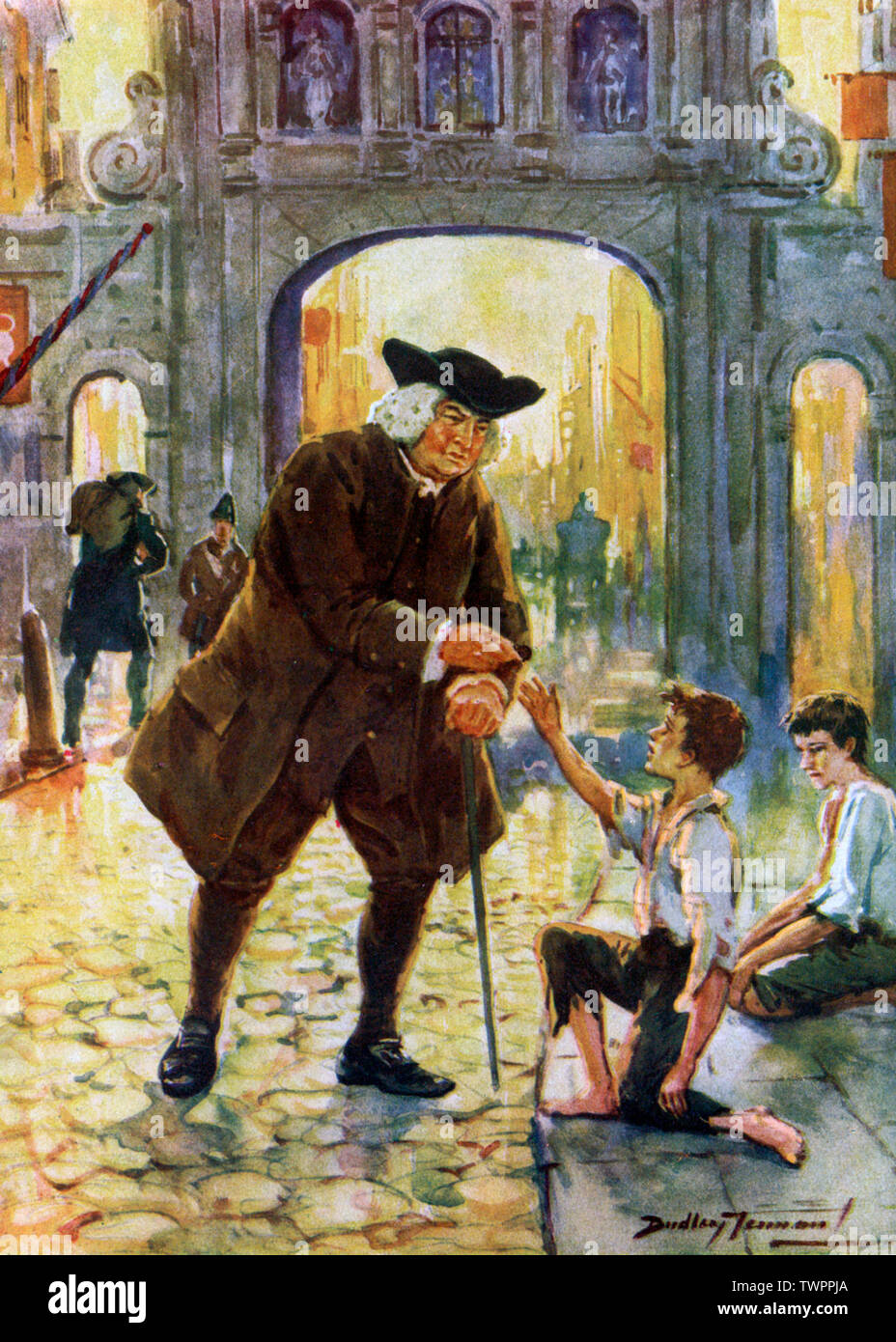 Dr Johnson giving money to impoverished children by Temple Bar Gate, London. By Dudley Tennant (1867-1952). Samuel Johnson (1709-1784), often referred to as Dr Johnson, was an English writer who made lasting contributions to English literature as a poet, playwright, essayist, moralist, literary critic, biographer, editor and lexicographer. Stock Photohttps://www.alamy.com/image-license-details/?v=1https://www.alamy.com/dr-johnson-giving-money-to-impoverished-children-by-temple-bar-gate-london-by-dudley-tennant-1867-1952-samuel-johnson-1709-1784-often-referred-to-as-dr-johnson-was-an-english-writer-who-made-lasting-contributions-to-english-literature-as-a-poet-playwright-essayist-moralist-literary-critic-biographer-editor-and-lexicographer-image256812258.html
Dr Johnson giving money to impoverished children by Temple Bar Gate, London. By Dudley Tennant (1867-1952). Samuel Johnson (1709-1784), often referred to as Dr Johnson, was an English writer who made lasting contributions to English literature as a poet, playwright, essayist, moralist, literary critic, biographer, editor and lexicographer. Stock Photohttps://www.alamy.com/image-license-details/?v=1https://www.alamy.com/dr-johnson-giving-money-to-impoverished-children-by-temple-bar-gate-london-by-dudley-tennant-1867-1952-samuel-johnson-1709-1784-often-referred-to-as-dr-johnson-was-an-english-writer-who-made-lasting-contributions-to-english-literature-as-a-poet-playwright-essayist-moralist-literary-critic-biographer-editor-and-lexicographer-image256812258.htmlRMTWPPJA–Dr Johnson giving money to impoverished children by Temple Bar Gate, London. By Dudley Tennant (1867-1952). Samuel Johnson (1709-1784), often referred to as Dr Johnson, was an English writer who made lasting contributions to English literature as a poet, playwright, essayist, moralist, literary critic, biographer, editor and lexicographer.
 Boy chimney sweep selling soot in front of the Foundling Hospital. The child sweep in black cap with brass plate indicating his employer, sack of soot, sold as manure. In front of the Foundling Hospital, a charity established in the 18th century for orphans. Handcoloured copperplate engraving by Edward Edwards after an illustration by William Marshall Craig from Description of the Plates Representing the Itinerant Traders of London, Richard Phillips, No. 71 St Paul’s Churchyard, London, 1805. Stock Photohttps://www.alamy.com/image-license-details/?v=1https://www.alamy.com/boy-chimney-sweep-selling-soot-in-front-of-the-foundling-hospital-the-child-sweep-in-black-cap-with-brass-plate-indicating-his-employer-sack-of-soot-sold-as-manure-in-front-of-the-foundling-hospital-a-charity-established-in-the-18th-century-for-orphans-handcoloured-copperplate-engraving-by-edward-edwards-after-an-illustration-by-william-marshall-craig-from-description-of-the-plates-representing-the-itinerant-traders-of-london-richard-phillips-no-71-st-pauls-churchyard-london-1805-image522705578.html
Boy chimney sweep selling soot in front of the Foundling Hospital. The child sweep in black cap with brass plate indicating his employer, sack of soot, sold as manure. In front of the Foundling Hospital, a charity established in the 18th century for orphans. Handcoloured copperplate engraving by Edward Edwards after an illustration by William Marshall Craig from Description of the Plates Representing the Itinerant Traders of London, Richard Phillips, No. 71 St Paul’s Churchyard, London, 1805. Stock Photohttps://www.alamy.com/image-license-details/?v=1https://www.alamy.com/boy-chimney-sweep-selling-soot-in-front-of-the-foundling-hospital-the-child-sweep-in-black-cap-with-brass-plate-indicating-his-employer-sack-of-soot-sold-as-manure-in-front-of-the-foundling-hospital-a-charity-established-in-the-18th-century-for-orphans-handcoloured-copperplate-engraving-by-edward-edwards-after-an-illustration-by-william-marshall-craig-from-description-of-the-plates-representing-the-itinerant-traders-of-london-richard-phillips-no-71-st-pauls-churchyard-london-1805-image522705578.htmlRM2NAB88A–Boy chimney sweep selling soot in front of the Foundling Hospital. The child sweep in black cap with brass plate indicating his employer, sack of soot, sold as manure. In front of the Foundling Hospital, a charity established in the 18th century for orphans. Handcoloured copperplate engraving by Edward Edwards after an illustration by William Marshall Craig from Description of the Plates Representing the Itinerant Traders of London, Richard Phillips, No. 71 St Paul’s Churchyard, London, 1805.
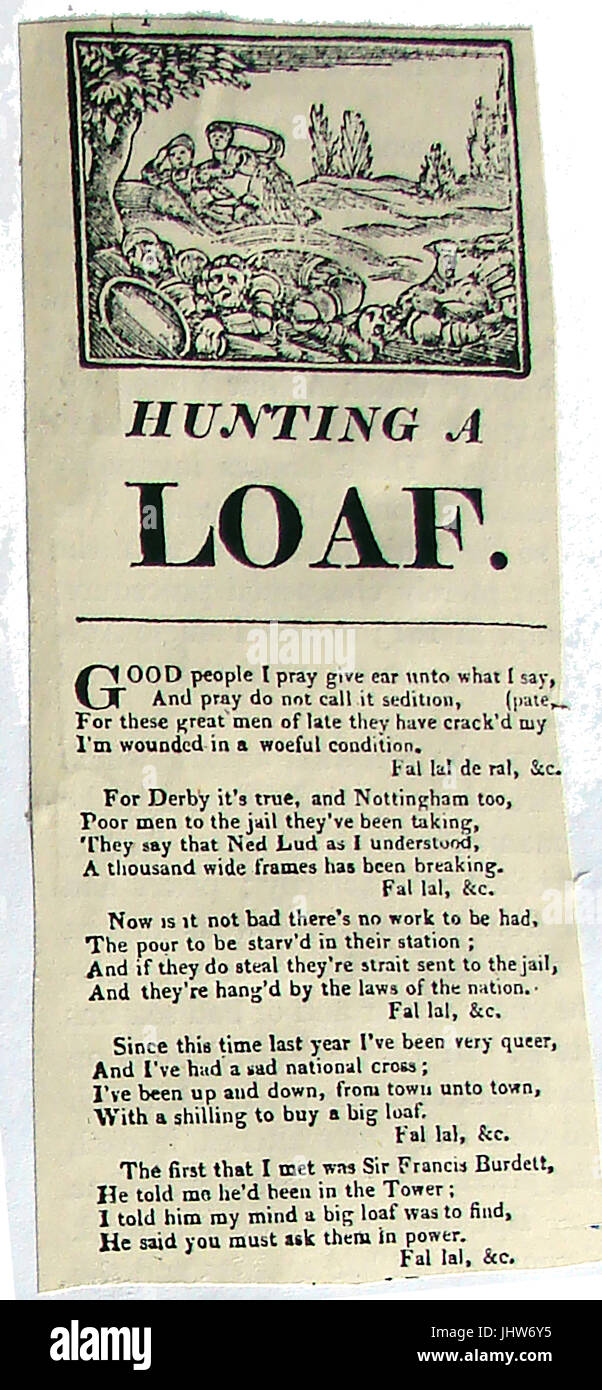 HUNTING A LOAF - 18th century poster poem -Luddites Stock Photohttps://www.alamy.com/image-license-details/?v=1https://www.alamy.com/stock-photo-hunting-a-loaf-18th-century-poster-poem-luddites-148686361.html
HUNTING A LOAF - 18th century poster poem -Luddites Stock Photohttps://www.alamy.com/image-license-details/?v=1https://www.alamy.com/stock-photo-hunting-a-loaf-18th-century-poster-poem-luddites-148686361.htmlRMJHW6Y5–HUNTING A LOAF - 18th century poster poem -Luddites
 Noon, plate two from The Four Times of Day. William Hogarth; English, 1697-1764. Date: 1738. Dimensions: 451 × 381 mm (image); 485 × 398 mm (plate/sheet). Etching and engraving in black on cream laid paper. Origin: England. Museum: The Chicago Art Institute. Stock Photohttps://www.alamy.com/image-license-details/?v=1https://www.alamy.com/noon-plate-two-from-the-four-times-of-day-william-hogarth-english-1697-1764-date-1738-dimensions-451-381-mm-image-485-398-mm-platesheet-etching-and-engraving-in-black-on-cream-laid-paper-origin-england-museum-the-chicago-art-institute-image239913115.html
Noon, plate two from The Four Times of Day. William Hogarth; English, 1697-1764. Date: 1738. Dimensions: 451 × 381 mm (image); 485 × 398 mm (plate/sheet). Etching and engraving in black on cream laid paper. Origin: England. Museum: The Chicago Art Institute. Stock Photohttps://www.alamy.com/image-license-details/?v=1https://www.alamy.com/noon-plate-two-from-the-four-times-of-day-william-hogarth-english-1697-1764-date-1738-dimensions-451-381-mm-image-485-398-mm-platesheet-etching-and-engraving-in-black-on-cream-laid-paper-origin-england-museum-the-chicago-art-institute-image239913115.htmlRMRX8YHF–Noon, plate two from The Four Times of Day. William Hogarth; English, 1697-1764. Date: 1738. Dimensions: 451 × 381 mm (image); 485 × 398 mm (plate/sheet). Etching and engraving in black on cream laid paper. Origin: England. Museum: The Chicago Art Institute.
 Workhouse, St. James Parish, London, December 1, 1809 An institution that was intended to provide work and shelter for poverty stricken people who had no means to support themselves. Artist: Thomas Rowlandson (1756-1827) an English artist and caricaturist of the Georgian Era. A social observer, he was a prolific artist and print maker. Credit: Thomas Rowlandson/Alamy Stock Photohttps://www.alamy.com/image-license-details/?v=1https://www.alamy.com/workhouse-st-james-parish-london-december-1-1809-an-institution-that-was-intended-to-provide-work-and-shelter-for-poverty-stricken-people-who-had-no-means-to-support-themselves-artist-thomas-rowlandson-1756-1827-an-english-artist-and-caricaturist-of-the-georgian-era-a-social-observer-he-was-a-prolific-artist-and-print-maker-credit-thomas-rowlandsonalamy-image474161109.html
Workhouse, St. James Parish, London, December 1, 1809 An institution that was intended to provide work and shelter for poverty stricken people who had no means to support themselves. Artist: Thomas Rowlandson (1756-1827) an English artist and caricaturist of the Georgian Era. A social observer, he was a prolific artist and print maker. Credit: Thomas Rowlandson/Alamy Stock Photohttps://www.alamy.com/image-license-details/?v=1https://www.alamy.com/workhouse-st-james-parish-london-december-1-1809-an-institution-that-was-intended-to-provide-work-and-shelter-for-poverty-stricken-people-who-had-no-means-to-support-themselves-artist-thomas-rowlandson-1756-1827-an-english-artist-and-caricaturist-of-the-georgian-era-a-social-observer-he-was-a-prolific-artist-and-print-maker-credit-thomas-rowlandsonalamy-image474161109.htmlRM2JFBW99–Workhouse, St. James Parish, London, December 1, 1809 An institution that was intended to provide work and shelter for poverty stricken people who had no means to support themselves. Artist: Thomas Rowlandson (1756-1827) an English artist and caricaturist of the Georgian Era. A social observer, he was a prolific artist and print maker. Credit: Thomas Rowlandson/Alamy
 'The South Sea Bubble, a Scene in 'Change Alley in 1720', 1847. By Edward Matthew Ward (1816-1879). Ward's famous oil painting of 1847 shows the speculation mania in early 18th century England which ended in the financial ruin of many of its investors. The South Sea Company was founded in 1711 with a view to restructuring government debt and restoring public credit. Stock Photohttps://www.alamy.com/image-license-details/?v=1https://www.alamy.com/the-south-sea-bubble-a-scene-in-change-alley-in-1720-1847-by-edward-matthew-ward-1816-1879-wards-famous-oil-painting-of-1847-shows-the-speculation-mania-in-early-18th-century-england-which-ended-in-the-financial-ruin-of-many-of-its-investors-the-south-sea-company-was-founded-in-1711-with-a-view-to-restructuring-government-debt-and-restoring-public-credit-image256810593.html
'The South Sea Bubble, a Scene in 'Change Alley in 1720', 1847. By Edward Matthew Ward (1816-1879). Ward's famous oil painting of 1847 shows the speculation mania in early 18th century England which ended in the financial ruin of many of its investors. The South Sea Company was founded in 1711 with a view to restructuring government debt and restoring public credit. Stock Photohttps://www.alamy.com/image-license-details/?v=1https://www.alamy.com/the-south-sea-bubble-a-scene-in-change-alley-in-1720-1847-by-edward-matthew-ward-1816-1879-wards-famous-oil-painting-of-1847-shows-the-speculation-mania-in-early-18th-century-england-which-ended-in-the-financial-ruin-of-many-of-its-investors-the-south-sea-company-was-founded-in-1711-with-a-view-to-restructuring-government-debt-and-restoring-public-credit-image256810593.htmlRMTWPMEW–'The South Sea Bubble, a Scene in 'Change Alley in 1720', 1847. By Edward Matthew Ward (1816-1879). Ward's famous oil painting of 1847 shows the speculation mania in early 18th century England which ended in the financial ruin of many of its investors. The South Sea Company was founded in 1711 with a view to restructuring government debt and restoring public credit.
 'A Rake's Progress', 1735; plate VII of VIII. Artist: William Hogarth Stock Photohttps://www.alamy.com/image-license-details/?v=1https://www.alamy.com/a-rakes-progress-1735-plate-vii-of-viii-artist-william-hogarth-image60075840.html
'A Rake's Progress', 1735; plate VII of VIII. Artist: William Hogarth Stock Photohttps://www.alamy.com/image-license-details/?v=1https://www.alamy.com/a-rakes-progress-1735-plate-vii-of-viii-artist-william-hogarth-image60075840.htmlRMDDMK9M–'A Rake's Progress', 1735; plate VII of VIII. Artist: William Hogarth
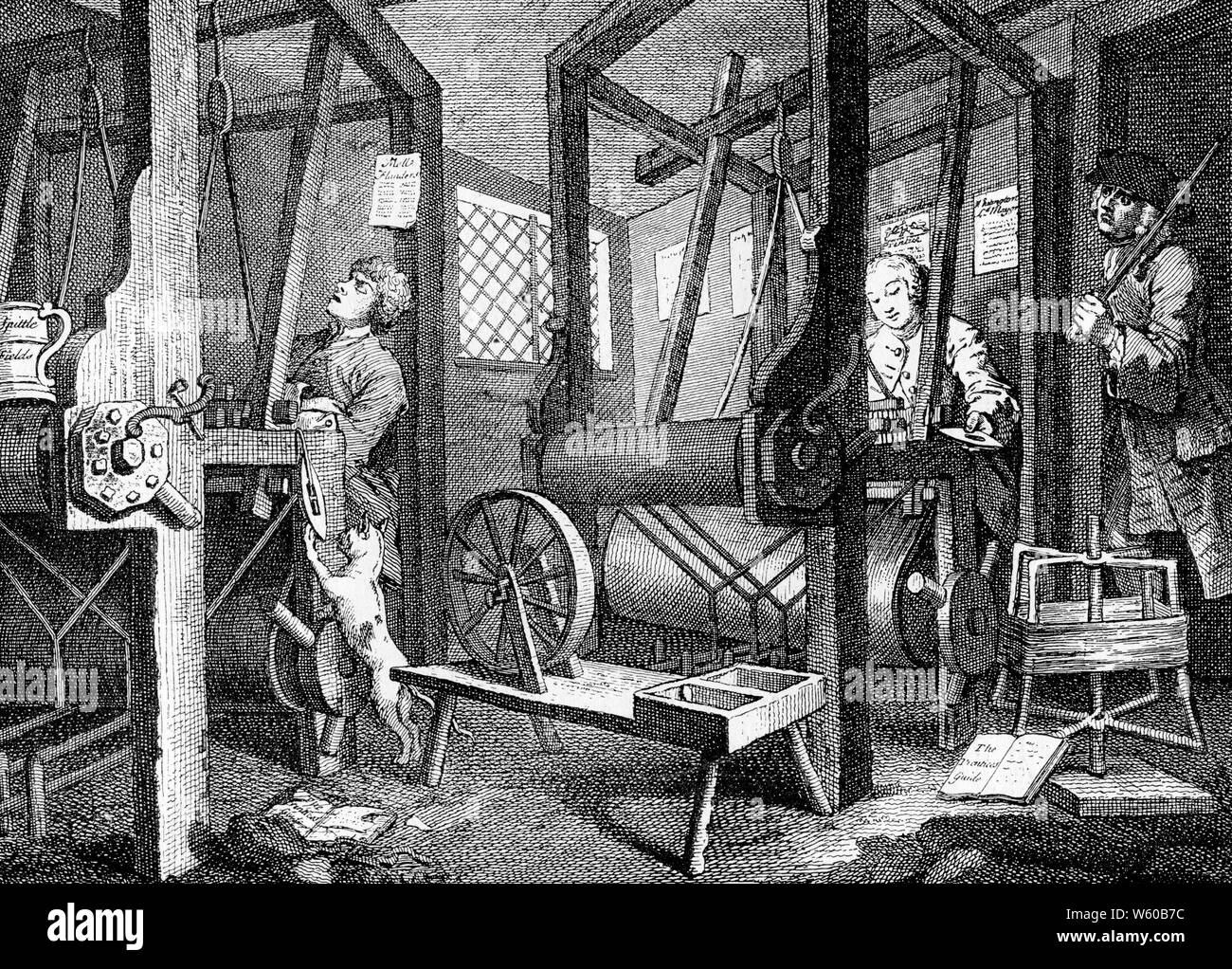 Plate I: The Fellow 'Prentices at their Looms', 1747. By William Hogarth (1697-1764). 'Industry and Idleness' is the title of a series of 12 engravings by William Hogarth, intending to illustrate to working children the possible rewards of hard work and diligence and the sure disasters attending a lack of both. Stock Photohttps://www.alamy.com/image-license-details/?v=1https://www.alamy.com/plate-i-the-fellow-prentices-at-their-looms-1747-by-william-hogarth-1697-1764-industry-and-idleness-is-the-title-of-a-series-of-12-engravings-by-william-hogarth-intending-to-illustrate-to-working-children-the-possible-rewards-of-hard-work-and-diligence-and-the-sure-disasters-attending-a-lack-of-both-image261852288.html
Plate I: The Fellow 'Prentices at their Looms', 1747. By William Hogarth (1697-1764). 'Industry and Idleness' is the title of a series of 12 engravings by William Hogarth, intending to illustrate to working children the possible rewards of hard work and diligence and the sure disasters attending a lack of both. Stock Photohttps://www.alamy.com/image-license-details/?v=1https://www.alamy.com/plate-i-the-fellow-prentices-at-their-looms-1747-by-william-hogarth-1697-1764-industry-and-idleness-is-the-title-of-a-series-of-12-engravings-by-william-hogarth-intending-to-illustrate-to-working-children-the-possible-rewards-of-hard-work-and-diligence-and-the-sure-disasters-attending-a-lack-of-both-image261852288.htmlRMW60B7C–Plate I: The Fellow 'Prentices at their Looms', 1747. By William Hogarth (1697-1764). 'Industry and Idleness' is the title of a series of 12 engravings by William Hogarth, intending to illustrate to working children the possible rewards of hard work and diligence and the sure disasters attending a lack of both.
 18th century Child token, given to the Foundling Hospital in London. Mothers left tokens with their babies, so that, if circumstances improved for them, the mothers could reclaim their children. The Foundling Hospital in London, England, was founded in 1739 by the philanthropic sea captain Thomas Coram. It was a children's home established for the 'education and maintenance of exposed and deserted young children Stock Photohttps://www.alamy.com/image-license-details/?v=1https://www.alamy.com/18th-century-child-token-given-to-the-foundling-hospital-in-london-mothers-left-tokens-with-their-babies-so-that-if-circumstances-improved-for-them-the-mothers-could-reclaim-their-children-the-foundling-hospital-in-london-england-was-founded-in-1739-by-the-philanthropic-sea-captain-thomas-coram-it-was-a-childrens-home-established-for-the-education-and-maintenance-of-exposed-and-deserted-young-children-image240279797.html
18th century Child token, given to the Foundling Hospital in London. Mothers left tokens with their babies, so that, if circumstances improved for them, the mothers could reclaim their children. The Foundling Hospital in London, England, was founded in 1739 by the philanthropic sea captain Thomas Coram. It was a children's home established for the 'education and maintenance of exposed and deserted young children Stock Photohttps://www.alamy.com/image-license-details/?v=1https://www.alamy.com/18th-century-child-token-given-to-the-foundling-hospital-in-london-mothers-left-tokens-with-their-babies-so-that-if-circumstances-improved-for-them-the-mothers-could-reclaim-their-children-the-foundling-hospital-in-london-england-was-founded-in-1739-by-the-philanthropic-sea-captain-thomas-coram-it-was-a-childrens-home-established-for-the-education-and-maintenance-of-exposed-and-deserted-young-children-image240279797.htmlRMRXWK99–18th century Child token, given to the Foundling Hospital in London. Mothers left tokens with their babies, so that, if circumstances improved for them, the mothers could reclaim their children. The Foundling Hospital in London, England, was founded in 1739 by the philanthropic sea captain Thomas Coram. It was a children's home established for the 'education and maintenance of exposed and deserted young children
 A Rake's Progress, Plate 4, ca. 1800. Stock Photohttps://www.alamy.com/image-license-details/?v=1https://www.alamy.com/a-rakes-progress-plate-4-ca-1800-image386255593.html
A Rake's Progress, Plate 4, ca. 1800. Stock Photohttps://www.alamy.com/image-license-details/?v=1https://www.alamy.com/a-rakes-progress-plate-4-ca-1800-image386255593.htmlRM2DCBCXH–A Rake's Progress, Plate 4, ca. 1800.
 The Foundling Hospital, Guildford Street, London. Founded by Captain Coram in 1742, the hospital was supported by Handel and Hogarth, among others. Stock Photohttps://www.alamy.com/image-license-details/?v=1https://www.alamy.com/the-foundling-hospital-guildford-street-london-founded-by-captain-coram-in-1742-the-hospital-was-supported-by-handel-and-hogarth-among-others-image628490628.html
The Foundling Hospital, Guildford Street, London. Founded by Captain Coram in 1742, the hospital was supported by Handel and Hogarth, among others. Stock Photohttps://www.alamy.com/image-license-details/?v=1https://www.alamy.com/the-foundling-hospital-guildford-street-london-founded-by-captain-coram-in-1742-the-hospital-was-supported-by-handel-and-hogarth-among-others-image628490628.htmlRM2YEE65T–The Foundling Hospital, Guildford Street, London. Founded by Captain Coram in 1742, the hospital was supported by Handel and Hogarth, among others.
 Visit of the Prince of Wales to Shoreditch, London, 18th October 1927. Artist: Anon Stock Photohttps://www.alamy.com/image-license-details/?v=1https://www.alamy.com/visit-of-the-prince-of-wales-to-shoreditch-london-18th-october-1927-image60087986.html
Visit of the Prince of Wales to Shoreditch, London, 18th October 1927. Artist: Anon Stock Photohttps://www.alamy.com/image-license-details/?v=1https://www.alamy.com/visit-of-the-prince-of-wales-to-shoreditch-london-18th-october-1927-image60087986.htmlRMDDN6RE–Visit of the Prince of Wales to Shoreditch, London, 18th October 1927. Artist: Anon
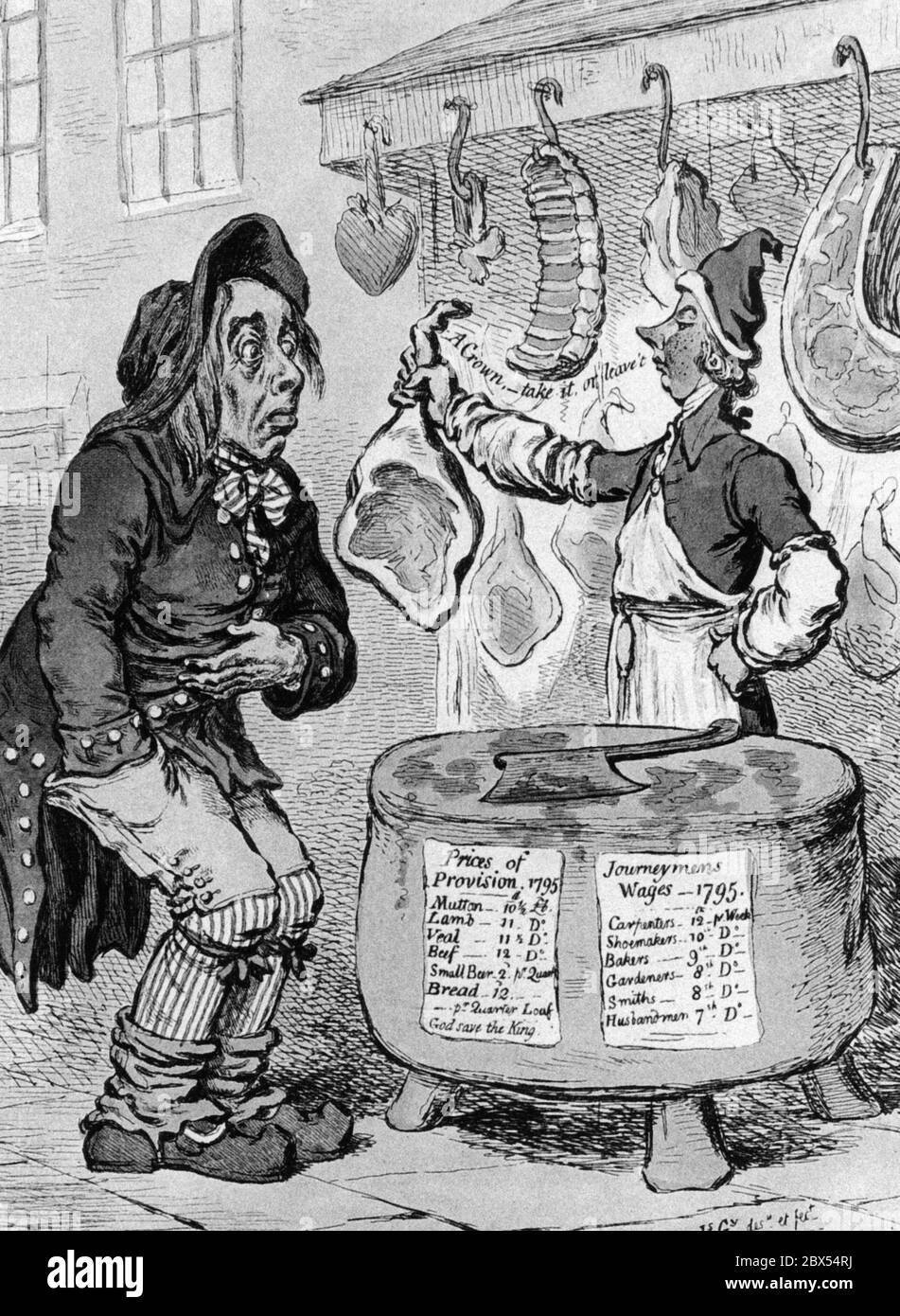 A severe crop failure led to a famine catastrophe in England. The Prime Minister William Pitt, who is portrayed as a butcher, remarked in a London newspaper that people should reduce the consumption of bread in favour of other foods. Gillray ridicules the absurd change from bread to meat, which is unaffordable for the population, by offering an oversized piece of meat to the starving John Bull. Stock Photohttps://www.alamy.com/image-license-details/?v=1https://www.alamy.com/a-severe-crop-failure-led-to-a-famine-catastrophe-in-england-the-prime-minister-william-pitt-who-is-portrayed-as-a-butcher-remarked-in-a-london-newspaper-that-people-should-reduce-the-consumption-of-bread-in-favour-of-other-foods-gillray-ridicules-the-absurd-change-from-bread-to-meat-which-is-unaffordable-for-the-population-by-offering-an-oversized-piece-of-meat-to-the-starving-john-bull-image360301974.html
A severe crop failure led to a famine catastrophe in England. The Prime Minister William Pitt, who is portrayed as a butcher, remarked in a London newspaper that people should reduce the consumption of bread in favour of other foods. Gillray ridicules the absurd change from bread to meat, which is unaffordable for the population, by offering an oversized piece of meat to the starving John Bull. Stock Photohttps://www.alamy.com/image-license-details/?v=1https://www.alamy.com/a-severe-crop-failure-led-to-a-famine-catastrophe-in-england-the-prime-minister-william-pitt-who-is-portrayed-as-a-butcher-remarked-in-a-london-newspaper-that-people-should-reduce-the-consumption-of-bread-in-favour-of-other-foods-gillray-ridicules-the-absurd-change-from-bread-to-meat-which-is-unaffordable-for-the-population-by-offering-an-oversized-piece-of-meat-to-the-starving-john-bull-image360301974.htmlRM2BX54RJ–A severe crop failure led to a famine catastrophe in England. The Prime Minister William Pitt, who is portrayed as a butcher, remarked in a London newspaper that people should reduce the consumption of bread in favour of other foods. Gillray ridicules the absurd change from bread to meat, which is unaffordable for the population, by offering an oversized piece of meat to the starving John Bull.
 18th century Child token, given to the Foundling Hospital in London. Mothers left tokens with their babies, so that, if circumstances improved for them, the mothers could reclaim their children. The Foundling Hospital in London, England, was founded in 1739 by the philanthropic sea captain Thomas Coram. It was a children's home established for the 'education and maintenance of exposed and deserted young children Stock Photohttps://www.alamy.com/image-license-details/?v=1https://www.alamy.com/18th-century-child-token-given-to-the-foundling-hospital-in-london-mothers-left-tokens-with-their-babies-so-that-if-circumstances-improved-for-them-the-mothers-could-reclaim-their-children-the-foundling-hospital-in-london-england-was-founded-in-1739-by-the-philanthropic-sea-captain-thomas-coram-it-was-a-childrens-home-established-for-the-education-and-maintenance-of-exposed-and-deserted-young-children-image328361721.html
18th century Child token, given to the Foundling Hospital in London. Mothers left tokens with their babies, so that, if circumstances improved for them, the mothers could reclaim their children. The Foundling Hospital in London, England, was founded in 1739 by the philanthropic sea captain Thomas Coram. It was a children's home established for the 'education and maintenance of exposed and deserted young children Stock Photohttps://www.alamy.com/image-license-details/?v=1https://www.alamy.com/18th-century-child-token-given-to-the-foundling-hospital-in-london-mothers-left-tokens-with-their-babies-so-that-if-circumstances-improved-for-them-the-mothers-could-reclaim-their-children-the-foundling-hospital-in-london-england-was-founded-in-1739-by-the-philanthropic-sea-captain-thomas-coram-it-was-a-childrens-home-established-for-the-education-and-maintenance-of-exposed-and-deserted-young-children-image328361721.htmlRM2A264M9–18th century Child token, given to the Foundling Hospital in London. Mothers left tokens with their babies, so that, if circumstances improved for them, the mothers could reclaim their children. The Foundling Hospital in London, England, was founded in 1739 by the philanthropic sea captain Thomas Coram. It was a children's home established for the 'education and maintenance of exposed and deserted young children
 Colfe's Almshouses in Lewisham, London, c1795. Artist: Anon Stock Photohttps://www.alamy.com/image-license-details/?v=1https://www.alamy.com/colfes-almshouses-in-lewisham-london-c1795-artist-anon-image60163170.html
Colfe's Almshouses in Lewisham, London, c1795. Artist: Anon Stock Photohttps://www.alamy.com/image-license-details/?v=1https://www.alamy.com/colfes-almshouses-in-lewisham-london-c1795-artist-anon-image60163170.htmlRMDDTJMJ–Colfe's Almshouses in Lewisham, London, c1795. Artist: Anon
 18th century Child token, given to the Foundling Hospital in London. Mothers left tokens with their babies, so that, if circumstances improved for them, the mothers could reclaim their children. The Foundling Hospital in London, England, was founded in 1739 by the philanthropic sea captain Thomas Coram. It was a children's home established for the 'education and maintenance of exposed and deserted young children Stock Photohttps://www.alamy.com/image-license-details/?v=1https://www.alamy.com/18th-century-child-token-given-to-the-foundling-hospital-in-london-mothers-left-tokens-with-their-babies-so-that-if-circumstances-improved-for-them-the-mothers-could-reclaim-their-children-the-foundling-hospital-in-london-england-was-founded-in-1739-by-the-philanthropic-sea-captain-thomas-coram-it-was-a-childrens-home-established-for-the-education-and-maintenance-of-exposed-and-deserted-young-children-image328361712.html
18th century Child token, given to the Foundling Hospital in London. Mothers left tokens with their babies, so that, if circumstances improved for them, the mothers could reclaim their children. The Foundling Hospital in London, England, was founded in 1739 by the philanthropic sea captain Thomas Coram. It was a children's home established for the 'education and maintenance of exposed and deserted young children Stock Photohttps://www.alamy.com/image-license-details/?v=1https://www.alamy.com/18th-century-child-token-given-to-the-foundling-hospital-in-london-mothers-left-tokens-with-their-babies-so-that-if-circumstances-improved-for-them-the-mothers-could-reclaim-their-children-the-foundling-hospital-in-london-england-was-founded-in-1739-by-the-philanthropic-sea-captain-thomas-coram-it-was-a-childrens-home-established-for-the-education-and-maintenance-of-exposed-and-deserted-young-children-image328361712.htmlRM2A264M0–18th century Child token, given to the Foundling Hospital in London. Mothers left tokens with their babies, so that, if circumstances improved for them, the mothers could reclaim their children. The Foundling Hospital in London, England, was founded in 1739 by the philanthropic sea captain Thomas Coram. It was a children's home established for the 'education and maintenance of exposed and deserted young children
 Dilapidated door, East End, London, England, UK Stock Photohttps://www.alamy.com/image-license-details/?v=1https://www.alamy.com/dilapidated-door-east-end-london-england-uk-image638309501.html
Dilapidated door, East End, London, England, UK Stock Photohttps://www.alamy.com/image-license-details/?v=1https://www.alamy.com/dilapidated-door-east-end-london-england-uk-image638309501.htmlRM2S2DE7W–Dilapidated door, East End, London, England, UK
 18th century Child token, given to the Foundling Hospital in London. Mothers left tokens with their babies, so that, if circumstances improved for them, the mothers could reclaim their children. The Foundling Hospital in London, England, was founded in 1739 by the philanthropic sea captain Thomas Coram. It was a children's home established for the 'education and maintenance of exposed and deserted young children Stock Photohttps://www.alamy.com/image-license-details/?v=1https://www.alamy.com/18th-century-child-token-given-to-the-foundling-hospital-in-london-mothers-left-tokens-with-their-babies-so-that-if-circumstances-improved-for-them-the-mothers-could-reclaim-their-children-the-foundling-hospital-in-london-england-was-founded-in-1739-by-the-philanthropic-sea-captain-thomas-coram-it-was-a-childrens-home-established-for-the-education-and-maintenance-of-exposed-and-deserted-young-children-image328361719.html
18th century Child token, given to the Foundling Hospital in London. Mothers left tokens with their babies, so that, if circumstances improved for them, the mothers could reclaim their children. The Foundling Hospital in London, England, was founded in 1739 by the philanthropic sea captain Thomas Coram. It was a children's home established for the 'education and maintenance of exposed and deserted young children Stock Photohttps://www.alamy.com/image-license-details/?v=1https://www.alamy.com/18th-century-child-token-given-to-the-foundling-hospital-in-london-mothers-left-tokens-with-their-babies-so-that-if-circumstances-improved-for-them-the-mothers-could-reclaim-their-children-the-foundling-hospital-in-london-england-was-founded-in-1739-by-the-philanthropic-sea-captain-thomas-coram-it-was-a-childrens-home-established-for-the-education-and-maintenance-of-exposed-and-deserted-young-children-image328361719.htmlRM2A264M7–18th century Child token, given to the Foundling Hospital in London. Mothers left tokens with their babies, so that, if circumstances improved for them, the mothers could reclaim their children. The Foundling Hospital in London, England, was founded in 1739 by the philanthropic sea captain Thomas Coram. It was a children's home established for the 'education and maintenance of exposed and deserted young children
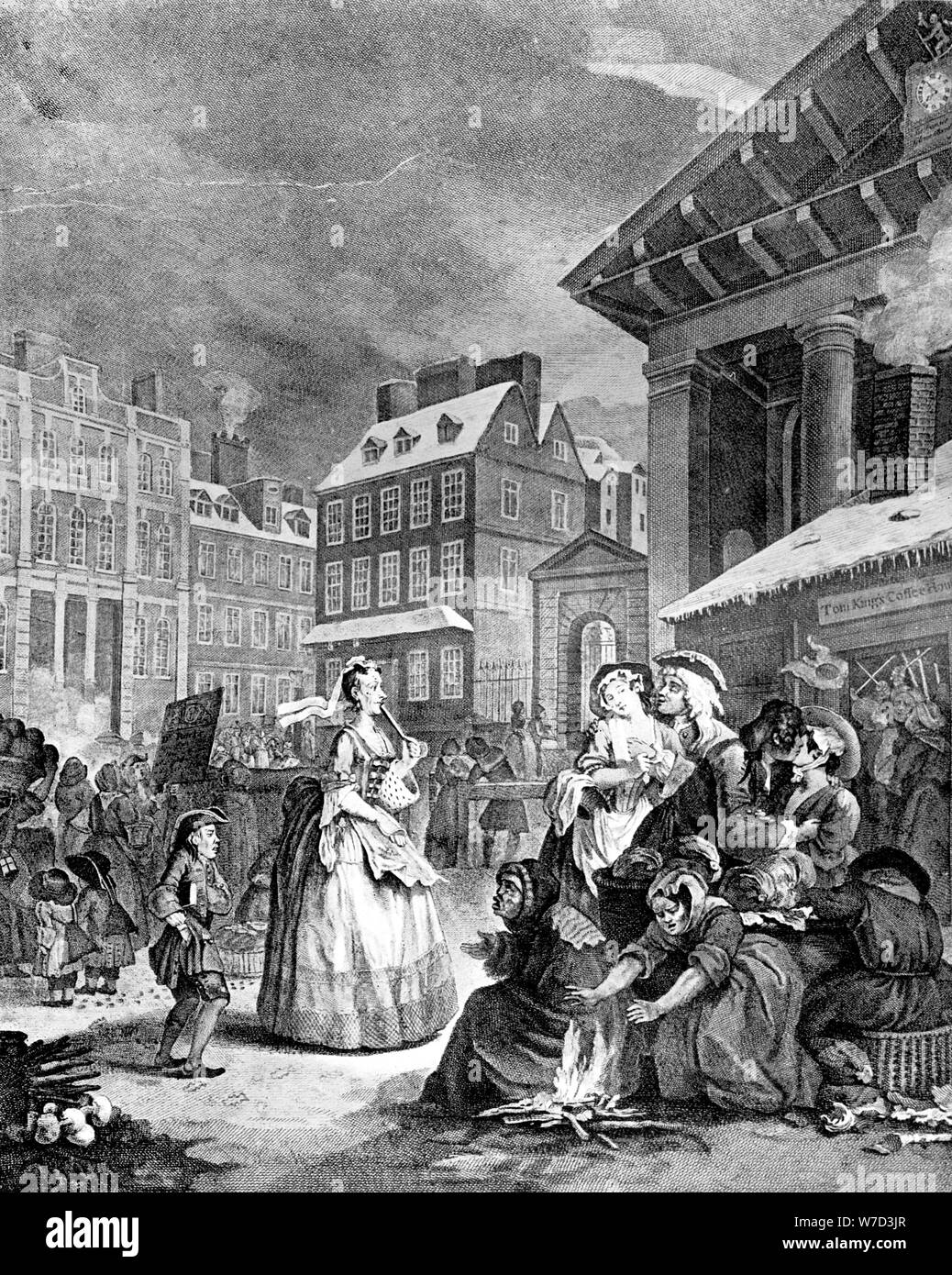 'Morning (Four Times of the Day)', 1738.Artist: William Hogarth Stock Photohttps://www.alamy.com/image-license-details/?v=1https://www.alamy.com/morning-four-times-of-the-day-1738artist-william-hogarth-image262746367.html
'Morning (Four Times of the Day)', 1738.Artist: William Hogarth Stock Photohttps://www.alamy.com/image-license-details/?v=1https://www.alamy.com/morning-four-times-of-the-day-1738artist-william-hogarth-image262746367.htmlRMW7D3JR–'Morning (Four Times of the Day)', 1738.Artist: William Hogarth
 18th century Child token, given to the Foundling Hospital in London. Mothers left tokens with their babies, so that, if circumstances improved for them, the mothers could reclaim their children. The Foundling Hospital in London, England, was founded in 1739 by the philanthropic sea captain Thomas Coram. It was a children's home established for the 'education and maintenance of exposed and deserted young children Stock Photohttps://www.alamy.com/image-license-details/?v=1https://www.alamy.com/18th-century-child-token-given-to-the-foundling-hospital-in-london-mothers-left-tokens-with-their-babies-so-that-if-circumstances-improved-for-them-the-mothers-could-reclaim-their-children-the-foundling-hospital-in-london-england-was-founded-in-1739-by-the-philanthropic-sea-captain-thomas-coram-it-was-a-childrens-home-established-for-the-education-and-maintenance-of-exposed-and-deserted-young-children-image328361714.html
18th century Child token, given to the Foundling Hospital in London. Mothers left tokens with their babies, so that, if circumstances improved for them, the mothers could reclaim their children. The Foundling Hospital in London, England, was founded in 1739 by the philanthropic sea captain Thomas Coram. It was a children's home established for the 'education and maintenance of exposed and deserted young children Stock Photohttps://www.alamy.com/image-license-details/?v=1https://www.alamy.com/18th-century-child-token-given-to-the-foundling-hospital-in-london-mothers-left-tokens-with-their-babies-so-that-if-circumstances-improved-for-them-the-mothers-could-reclaim-their-children-the-foundling-hospital-in-london-england-was-founded-in-1739-by-the-philanthropic-sea-captain-thomas-coram-it-was-a-childrens-home-established-for-the-education-and-maintenance-of-exposed-and-deserted-young-children-image328361714.htmlRM2A264M2–18th century Child token, given to the Foundling Hospital in London. Mothers left tokens with their babies, so that, if circumstances improved for them, the mothers could reclaim their children. The Foundling Hospital in London, England, was founded in 1739 by the philanthropic sea captain Thomas Coram. It was a children's home established for the 'education and maintenance of exposed and deserted young children
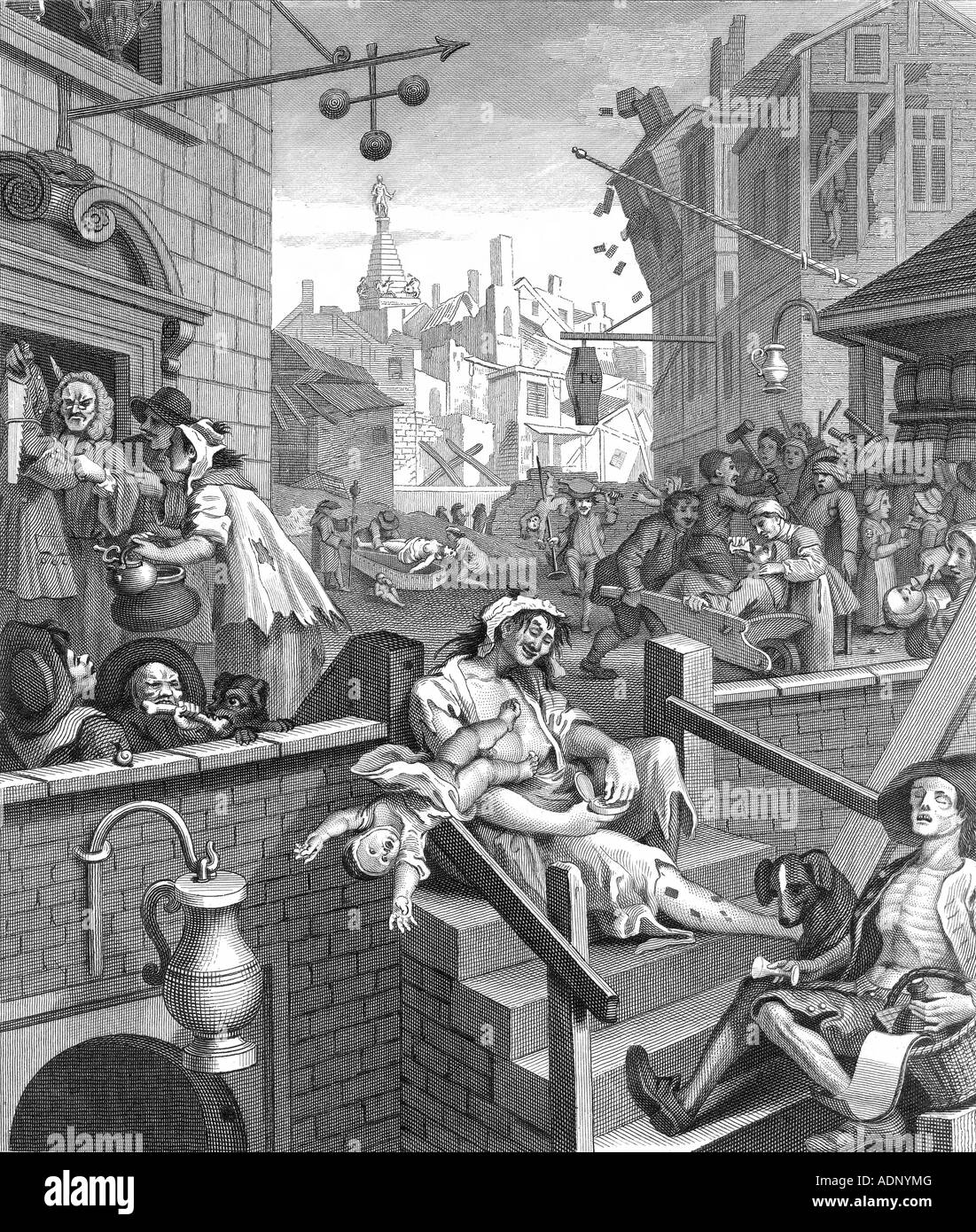 Gin Lane. Engraving after Hogarth. Stock Photohttps://www.alamy.com/image-license-details/?v=1https://www.alamy.com/stock-photo-gin-lane-engraving-after-hogarth-13465887.html
Gin Lane. Engraving after Hogarth. Stock Photohttps://www.alamy.com/image-license-details/?v=1https://www.alamy.com/stock-photo-gin-lane-engraving-after-hogarth-13465887.htmlRMADNYMG–Gin Lane. Engraving after Hogarth.
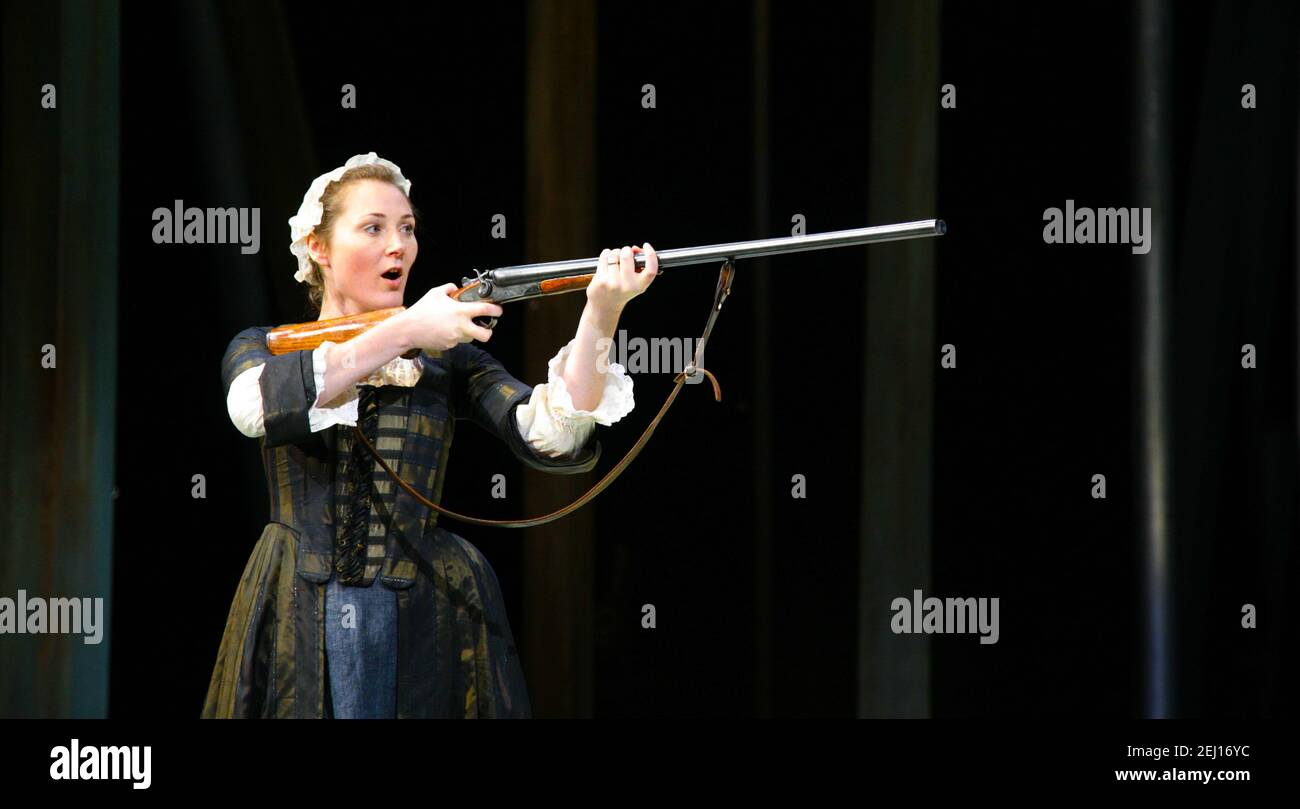 Ruth Gemmell (Mrs Lynch) in CORAM BOY by Helen Edmundson at the Olivier Theatre, National Theatre (NT), London SE1 07/12/2006 adapted from the novel by Jamila Gavin design: Ti Green & Melly Still lighting: Paule Constable director: Melly Still Stock Photohttps://www.alamy.com/image-license-details/?v=1https://www.alamy.com/ruth-gemmell-mrs-lynch-in-coram-boy-by-helen-edmundson-at-the-olivier-theatre-national-theatre-nt-london-se1-07122006-adapted-from-the-novel-by-jamila-gavin-design-ti-green-melly-still-lighting-paule-constable-director-melly-still-image406929696.html
Ruth Gemmell (Mrs Lynch) in CORAM BOY by Helen Edmundson at the Olivier Theatre, National Theatre (NT), London SE1 07/12/2006 adapted from the novel by Jamila Gavin design: Ti Green & Melly Still lighting: Paule Constable director: Melly Still Stock Photohttps://www.alamy.com/image-license-details/?v=1https://www.alamy.com/ruth-gemmell-mrs-lynch-in-coram-boy-by-helen-edmundson-at-the-olivier-theatre-national-theatre-nt-london-se1-07122006-adapted-from-the-novel-by-jamila-gavin-design-ti-green-melly-still-lighting-paule-constable-director-melly-still-image406929696.htmlRM2EJ16YC–Ruth Gemmell (Mrs Lynch) in CORAM BOY by Helen Edmundson at the Olivier Theatre, National Theatre (NT), London SE1 07/12/2006 adapted from the novel by Jamila Gavin design: Ti Green & Melly Still lighting: Paule Constable director: Melly Still
 Noon. Dated: 1738. Medium: etching and engraving. Museum: National Gallery of Art, Washington DC. Author: William Hogarth. Stock Photohttps://www.alamy.com/image-license-details/?v=1https://www.alamy.com/noon-dated-1738-medium-etching-and-engraving-museum-national-gallery-of-art-washington-dc-author-william-hogarth-image225459730.html
Noon. Dated: 1738. Medium: etching and engraving. Museum: National Gallery of Art, Washington DC. Author: William Hogarth. Stock Photohttps://www.alamy.com/image-license-details/?v=1https://www.alamy.com/noon-dated-1738-medium-etching-and-engraving-museum-national-gallery-of-art-washington-dc-author-william-hogarth-image225459730.htmlRMR2PG56–Noon. Dated: 1738. Medium: etching and engraving. Museum: National Gallery of Art, Washington DC. Author: William Hogarth.
 Tim McMullan (Philip Gaddam) with Coram girls in CORAM BOY by Helen Edmundson at the Olivier Theatre, National Theatre (NT), London SE1 07/12/2006 adapted from the novel by Jamila Gavin design: Ti Green & Melly Still lighting: Paule Constable director: Melly Still Stock Photohttps://www.alamy.com/image-license-details/?v=1https://www.alamy.com/tim-mcmullan-philip-gaddam-with-coram-girls-in-coram-boy-by-helen-edmundson-at-the-olivier-theatre-national-theatre-nt-london-se1-07122006-adapted-from-the-novel-by-jamila-gavin-design-ti-green-melly-still-lighting-paule-constable-director-melly-still-image576429154.html
Tim McMullan (Philip Gaddam) with Coram girls in CORAM BOY by Helen Edmundson at the Olivier Theatre, National Theatre (NT), London SE1 07/12/2006 adapted from the novel by Jamila Gavin design: Ti Green & Melly Still lighting: Paule Constable director: Melly Still Stock Photohttps://www.alamy.com/image-license-details/?v=1https://www.alamy.com/tim-mcmullan-philip-gaddam-with-coram-girls-in-coram-boy-by-helen-edmundson-at-the-olivier-theatre-national-theatre-nt-london-se1-07122006-adapted-from-the-novel-by-jamila-gavin-design-ti-green-melly-still-lighting-paule-constable-director-melly-still-image576429154.htmlRM2TDPH7E–Tim McMullan (Philip Gaddam) with Coram girls in CORAM BOY by Helen Edmundson at the Olivier Theatre, National Theatre (NT), London SE1 07/12/2006 adapted from the novel by Jamila Gavin design: Ti Green & Melly Still lighting: Paule Constable director: Melly Still
 Connoisseurs examining a collection of George Morland's James Gillray engraving print Stock Photohttps://www.alamy.com/image-license-details/?v=1https://www.alamy.com/connoisseurs-examining-a-collection-of-george-morlands-james-gillray-engraving-print-image365183350.html
Connoisseurs examining a collection of George Morland's James Gillray engraving print Stock Photohttps://www.alamy.com/image-license-details/?v=1https://www.alamy.com/connoisseurs-examining-a-collection-of-george-morlands-james-gillray-engraving-print-image365183350.htmlRM2C63F2E–Connoisseurs examining a collection of George Morland's James Gillray engraving print
 'The Stage-Coach of the Last Century', 1855. Artist: Unknown Stock Photohttps://www.alamy.com/image-license-details/?v=1https://www.alamy.com/stock-photo-the-stage-coach-of-the-last-century-1855-artist-unknown-17637800.html
'The Stage-Coach of the Last Century', 1855. Artist: Unknown Stock Photohttps://www.alamy.com/image-license-details/?v=1https://www.alamy.com/stock-photo-the-stage-coach-of-the-last-century-1855-artist-unknown-17637800.htmlRMB0KD5C–'The Stage-Coach of the Last Century', 1855. Artist: Unknown
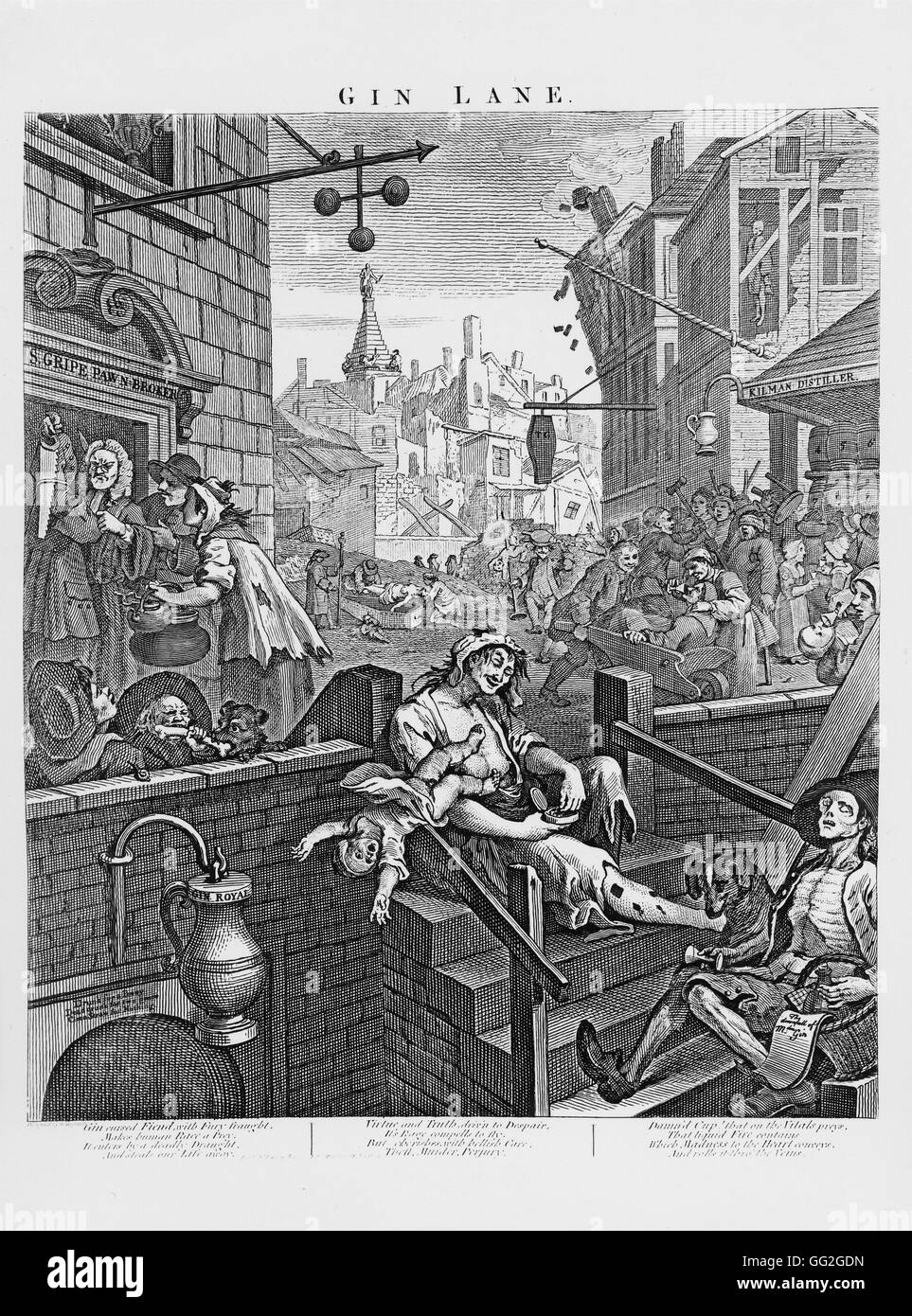 William Hogarth English school 'Gin Lane'. Scene that depict the evils of the consumption of gin as a contrast to the merits of drinking beer. 1751 Private collection Stock Photohttps://www.alamy.com/image-license-details/?v=1https://www.alamy.com/stock-photo-william-hogarth-english-school-gin-lane-scene-that-depict-the-evils-113153537.html
William Hogarth English school 'Gin Lane'. Scene that depict the evils of the consumption of gin as a contrast to the merits of drinking beer. 1751 Private collection Stock Photohttps://www.alamy.com/image-license-details/?v=1https://www.alamy.com/stock-photo-william-hogarth-english-school-gin-lane-scene-that-depict-the-evils-113153537.htmlRMGG2GDN–William Hogarth English school 'Gin Lane'. Scene that depict the evils of the consumption of gin as a contrast to the merits of drinking beer. 1751 Private collection
 18th century Child token, given to the Foundling Hospital in London. Mothers left tokens with their babies, so that, if circumstances improved for them, the mothers could reclaim their children. The Foundling Hospital in London, England, was founded in 1739 by the philanthropic sea captain Thomas Coram. It was a children's home established for the 'education and maintenance of exposed and deserted young children Stock Photohttps://www.alamy.com/image-license-details/?v=1https://www.alamy.com/18th-century-child-token-given-to-the-foundling-hospital-in-london-mothers-left-tokens-with-their-babies-so-that-if-circumstances-improved-for-them-the-mothers-could-reclaim-their-children-the-foundling-hospital-in-london-england-was-founded-in-1739-by-the-philanthropic-sea-captain-thomas-coram-it-was-a-childrens-home-established-for-the-education-and-maintenance-of-exposed-and-deserted-young-children-image240279824.html
18th century Child token, given to the Foundling Hospital in London. Mothers left tokens with their babies, so that, if circumstances improved for them, the mothers could reclaim their children. The Foundling Hospital in London, England, was founded in 1739 by the philanthropic sea captain Thomas Coram. It was a children's home established for the 'education and maintenance of exposed and deserted young children Stock Photohttps://www.alamy.com/image-license-details/?v=1https://www.alamy.com/18th-century-child-token-given-to-the-foundling-hospital-in-london-mothers-left-tokens-with-their-babies-so-that-if-circumstances-improved-for-them-the-mothers-could-reclaim-their-children-the-foundling-hospital-in-london-england-was-founded-in-1739-by-the-philanthropic-sea-captain-thomas-coram-it-was-a-childrens-home-established-for-the-education-and-maintenance-of-exposed-and-deserted-young-children-image240279824.htmlRMRXWKA8–18th century Child token, given to the Foundling Hospital in London. Mothers left tokens with their babies, so that, if circumstances improved for them, the mothers could reclaim their children. The Foundling Hospital in London, England, was founded in 1739 by the philanthropic sea captain Thomas Coram. It was a children's home established for the 'education and maintenance of exposed and deserted young children
 'Distressed sailors'. Sailors who have been disabled and have lost limbs, begging for money. Rowlandson's characteristic Sketches of the Lower Orders, intended as a companion to the New Picture of London: consisting of fifty-four plates ... coloured. London, 1820. Source: C.58.cc.1.(2). Author: ROWLANDSON, THOMAS. Stock Photohttps://www.alamy.com/image-license-details/?v=1https://www.alamy.com/distressed-sailors-sailors-who-have-been-disabled-and-have-lost-limbs-begging-for-money-rowlandsons-characteristic-sketches-of-the-lower-orders-intended-as-a-companion-to-the-new-picture-of-london-consisting-of-fifty-four-plates-coloured-london-1820-source-c58cc12-author-rowlandson-thomas-image227045025.html
'Distressed sailors'. Sailors who have been disabled and have lost limbs, begging for money. Rowlandson's characteristic Sketches of the Lower Orders, intended as a companion to the New Picture of London: consisting of fifty-four plates ... coloured. London, 1820. Source: C.58.cc.1.(2). Author: ROWLANDSON, THOMAS. Stock Photohttps://www.alamy.com/image-license-details/?v=1https://www.alamy.com/distressed-sailors-sailors-who-have-been-disabled-and-have-lost-limbs-begging-for-money-rowlandsons-characteristic-sketches-of-the-lower-orders-intended-as-a-companion-to-the-new-picture-of-london-consisting-of-fifty-four-plates-coloured-london-1820-source-c58cc12-author-rowlandson-thomas-image227045025.htmlRMR5AP6W–'Distressed sailors'. Sailors who have been disabled and have lost limbs, begging for money. Rowlandson's characteristic Sketches of the Lower Orders, intended as a companion to the New Picture of London: consisting of fifty-four plates ... coloured. London, 1820. Source: C.58.cc.1.(2). Author: ROWLANDSON, THOMAS.
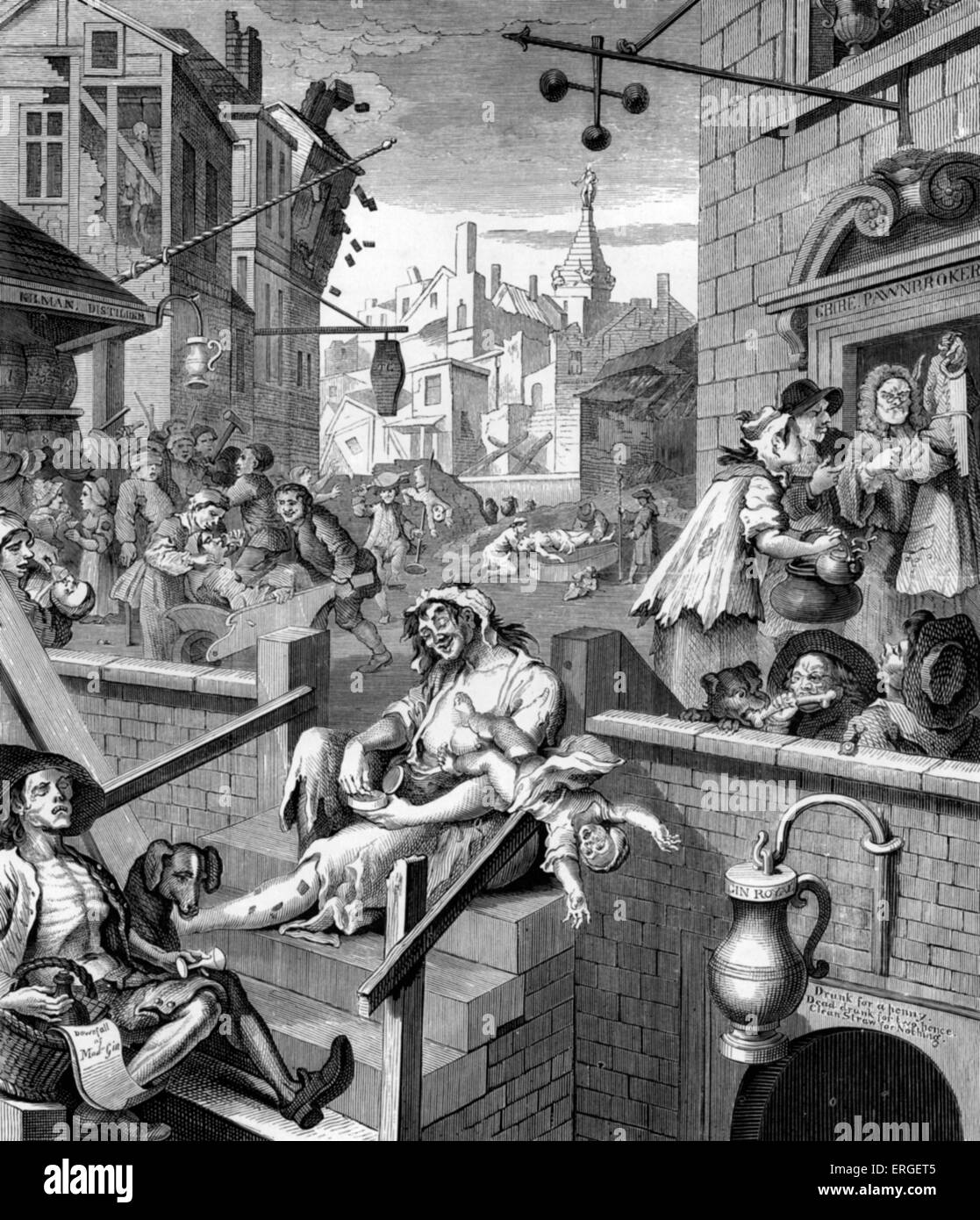 Gin Lane - caricature by William Hogarth, circa 1750. WH: English painter and artist, 10 November 1697 -October 1764. Stock Photohttps://www.alamy.com/image-license-details/?v=1https://www.alamy.com/stock-photo-gin-lane-caricature-by-william-hogarth-circa-1750-wh-english-painter-83341445.html
Gin Lane - caricature by William Hogarth, circa 1750. WH: English painter and artist, 10 November 1697 -October 1764. Stock Photohttps://www.alamy.com/image-license-details/?v=1https://www.alamy.com/stock-photo-gin-lane-caricature-by-william-hogarth-circa-1750-wh-english-painter-83341445.htmlRMERGET5–Gin Lane - caricature by William Hogarth, circa 1750. WH: English painter and artist, 10 November 1697 -October 1764.
 A WELL CONDUCTED BRITISH DAME SCHOOL Stock Photohttps://www.alamy.com/image-license-details/?v=1https://www.alamy.com/stock-photo-a-well-conducted-british-dame-school-148676666.html
A WELL CONDUCTED BRITISH DAME SCHOOL Stock Photohttps://www.alamy.com/image-license-details/?v=1https://www.alamy.com/stock-photo-a-well-conducted-british-dame-school-148676666.htmlRMJHTPGX–A WELL CONDUCTED BRITISH DAME SCHOOL
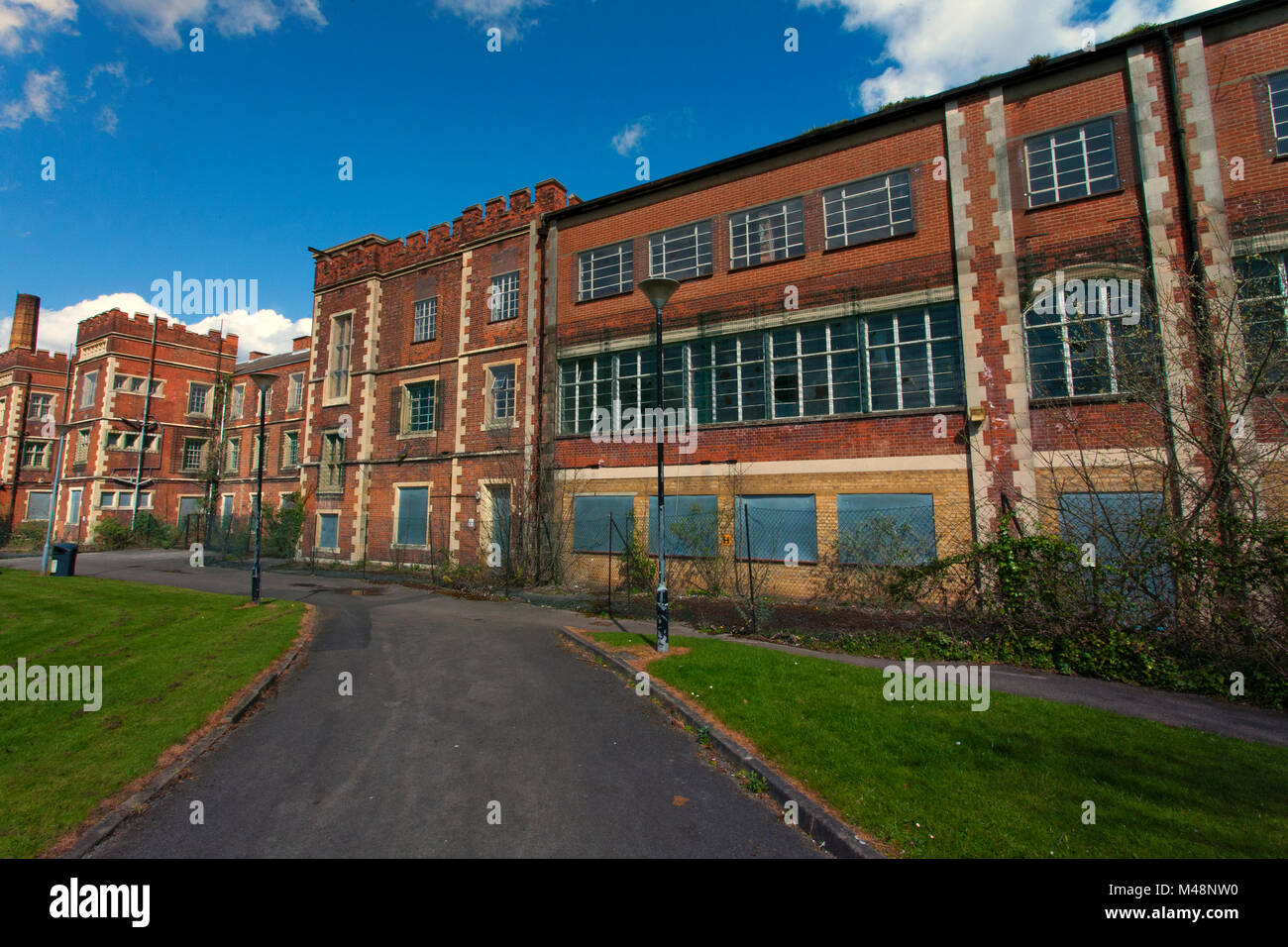 Springfield Psychiatric Hospital, Tooting, London, England, UK. Credit: London Snapper Stock Photohttps://www.alamy.com/image-license-details/?v=1https://www.alamy.com/stock-photo-springfield-psychiatric-hospital-tooting-london-england-uk-credit-174755084.html
Springfield Psychiatric Hospital, Tooting, London, England, UK. Credit: London Snapper Stock Photohttps://www.alamy.com/image-license-details/?v=1https://www.alamy.com/stock-photo-springfield-psychiatric-hospital-tooting-london-england-uk-credit-174755084.htmlRFM48NW0–Springfield Psychiatric Hospital, Tooting, London, England, UK. Credit: London Snapper
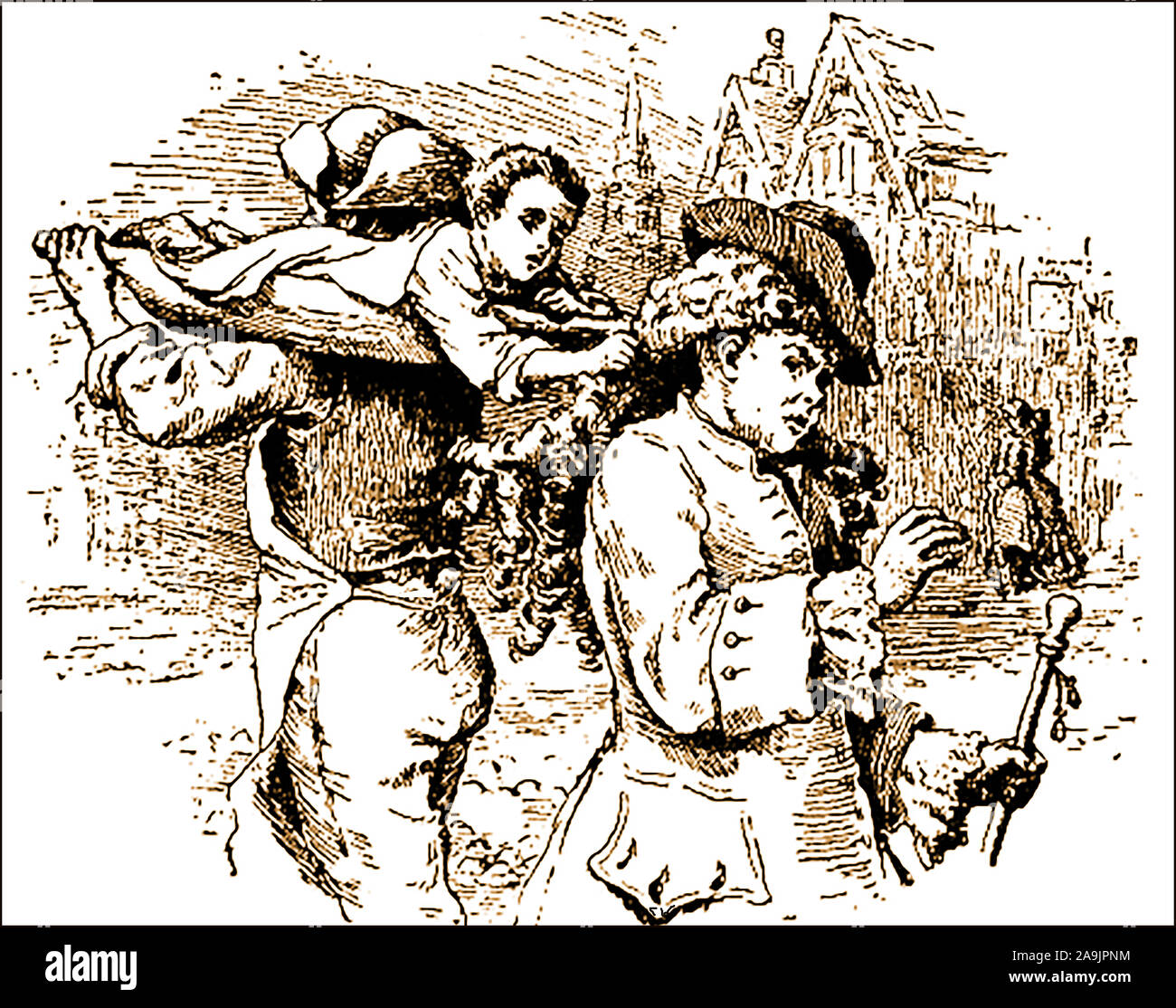 Wigs of long ago - The stealing of wigs was once a common occurrence in cities throughout Europe Stock Photohttps://www.alamy.com/image-license-details/?v=1https://www.alamy.com/wigs-of-long-ago-the-stealing-of-wigs-was-once-a-common-occurrence-in-cities-throughout-europe-image332941888.html
Wigs of long ago - The stealing of wigs was once a common occurrence in cities throughout Europe Stock Photohttps://www.alamy.com/image-license-details/?v=1https://www.alamy.com/wigs-of-long-ago-the-stealing-of-wigs-was-once-a-common-occurrence-in-cities-throughout-europe-image332941888.htmlRM2A9JPNM–Wigs of long ago - The stealing of wigs was once a common occurrence in cities throughout Europe
 The Lambarde Almshouses, Greenwich Park, London, c1790. Artist: Anon Stock Photohttps://www.alamy.com/image-license-details/?v=1https://www.alamy.com/the-lambarde-almshouses-greenwich-park-london-c1790-artist-anon-image60163475.html
The Lambarde Almshouses, Greenwich Park, London, c1790. Artist: Anon Stock Photohttps://www.alamy.com/image-license-details/?v=1https://www.alamy.com/the-lambarde-almshouses-greenwich-park-london-c1790-artist-anon-image60163475.htmlRMDDTK3F–The Lambarde Almshouses, Greenwich Park, London, c1790. Artist: Anon
 THE FOUR TIMES OF DAY NIGHT by William Hogarth 1697 1764 from Upton House Photographed in 1994 Stock Photohttps://www.alamy.com/image-license-details/?v=1https://www.alamy.com/stock-photo-the-four-times-of-day-night-by-william-hogarth-1697-1764-from-upton-22741974.html
THE FOUR TIMES OF DAY NIGHT by William Hogarth 1697 1764 from Upton House Photographed in 1994 Stock Photohttps://www.alamy.com/image-license-details/?v=1https://www.alamy.com/stock-photo-the-four-times-of-day-night-by-william-hogarth-1697-1764-from-upton-22741974.htmlRMB8YYHA–THE FOUR TIMES OF DAY NIGHT by William Hogarth 1697 1764 from Upton House Photographed in 1994
!["The Splendid Shilling", from "Poets' Wit and Humour", 1860. 'Altogether, the range of this selection is very extended, and the taste and humour which have guided it are everywhere apparent. The illustrations are in perfect keeping with the intention of the book. They are all admirably conceived and as admirably executed...[Shown here is] a sketch illustrating the passage in John Philip's poem of "The Splendid Shilling," which runs thus: "But I, whom griping penury surrounds, And hunger, sure attendant upon want, With scanty offals and small acid tiff (Wretch Stock Photo "The Splendid Shilling", from "Poets' Wit and Humour", 1860. 'Altogether, the range of this selection is very extended, and the taste and humour which have guided it are everywhere apparent. The illustrations are in perfect keeping with the intention of the book. They are all admirably conceived and as admirably executed...[Shown here is] a sketch illustrating the passage in John Philip's poem of "The Splendid Shilling," which runs thus: "But I, whom griping penury surrounds, And hunger, sure attendant upon want, With scanty offals and small acid tiff (Wretch Stock Photo](https://c8.alamy.com/comp/2T6GET8/quotthe-splendid-shillingquot-from-quotpoets-wit-and-humourquot-1860-altogether-the-range-of-this-selection-is-very-extended-and-the-taste-and-humour-which-have-guided-it-are-everywhere-apparent-the-illustrations-are-in-perfect-keeping-with-the-intention-of-the-book-they-are-all-admirably-conceived-and-as-admirably-executed-shown-here-is-a-sketch-illustrating-the-passage-in-john-philips-poem-of-quotthe-splendid-shillingquot-which-runs-thus-quotbut-i-whom-griping-penury-surrounds-and-hunger-sure-attendant-upon-want-with-scanty-offals-and-small-acid-tiff-wretch-2T6GET8.jpg) "The Splendid Shilling", from "Poets' Wit and Humour", 1860. 'Altogether, the range of this selection is very extended, and the taste and humour which have guided it are everywhere apparent. The illustrations are in perfect keeping with the intention of the book. They are all admirably conceived and as admirably executed...[Shown here is] a sketch illustrating the passage in John Philip's poem of "The Splendid Shilling," which runs thus: "But I, whom griping penury surrounds, And hunger, sure attendant upon want, With scanty offals and small acid tiff (Wretch Stock Photohttps://www.alamy.com/image-license-details/?v=1https://www.alamy.com/quotthe-splendid-shillingquot-from-quotpoets-wit-and-humourquot-1860-altogether-the-range-of-this-selection-is-very-extended-and-the-taste-and-humour-which-have-guided-it-are-everywhere-apparent-the-illustrations-are-in-perfect-keeping-with-the-intention-of-the-book-they-are-all-admirably-conceived-and-as-admirably-executed-shown-here-is-a-sketch-illustrating-the-passage-in-john-philips-poem-of-quotthe-splendid-shillingquot-which-runs-thus-quotbut-i-whom-griping-penury-surrounds-and-hunger-sure-attendant-upon-want-with-scanty-offals-and-small-acid-tiff-wretch-image571992968.html
"The Splendid Shilling", from "Poets' Wit and Humour", 1860. 'Altogether, the range of this selection is very extended, and the taste and humour which have guided it are everywhere apparent. The illustrations are in perfect keeping with the intention of the book. They are all admirably conceived and as admirably executed...[Shown here is] a sketch illustrating the passage in John Philip's poem of "The Splendid Shilling," which runs thus: "But I, whom griping penury surrounds, And hunger, sure attendant upon want, With scanty offals and small acid tiff (Wretch Stock Photohttps://www.alamy.com/image-license-details/?v=1https://www.alamy.com/quotthe-splendid-shillingquot-from-quotpoets-wit-and-humourquot-1860-altogether-the-range-of-this-selection-is-very-extended-and-the-taste-and-humour-which-have-guided-it-are-everywhere-apparent-the-illustrations-are-in-perfect-keeping-with-the-intention-of-the-book-they-are-all-admirably-conceived-and-as-admirably-executed-shown-here-is-a-sketch-illustrating-the-passage-in-john-philips-poem-of-quotthe-splendid-shillingquot-which-runs-thus-quotbut-i-whom-griping-penury-surrounds-and-hunger-sure-attendant-upon-want-with-scanty-offals-and-small-acid-tiff-wretch-image571992968.htmlRM2T6GET8–"The Splendid Shilling", from "Poets' Wit and Humour", 1860. 'Altogether, the range of this selection is very extended, and the taste and humour which have guided it are everywhere apparent. The illustrations are in perfect keeping with the intention of the book. They are all admirably conceived and as admirably executed...[Shown here is] a sketch illustrating the passage in John Philip's poem of "The Splendid Shilling," which runs thus: "But I, whom griping penury surrounds, And hunger, sure attendant upon want, With scanty offals and small acid tiff (Wretch
 18th century Child token, given to the Foundling Hospital in London. Mothers left tokens with their babies, so that, if circumstances improved for them, the mothers could reclaim their children. The Foundling Hospital in London, England, was founded in 1739 by the philanthropic sea captain Thomas Coram. It was a children's home established for the 'education and maintenance of exposed and deserted young children Stock Photohttps://www.alamy.com/image-license-details/?v=1https://www.alamy.com/18th-century-child-token-given-to-the-foundling-hospital-in-london-mothers-left-tokens-with-their-babies-so-that-if-circumstances-improved-for-them-the-mothers-could-reclaim-their-children-the-foundling-hospital-in-london-england-was-founded-in-1739-by-the-philanthropic-sea-captain-thomas-coram-it-was-a-childrens-home-established-for-the-education-and-maintenance-of-exposed-and-deserted-young-children-image328361717.html
18th century Child token, given to the Foundling Hospital in London. Mothers left tokens with their babies, so that, if circumstances improved for them, the mothers could reclaim their children. The Foundling Hospital in London, England, was founded in 1739 by the philanthropic sea captain Thomas Coram. It was a children's home established for the 'education and maintenance of exposed and deserted young children Stock Photohttps://www.alamy.com/image-license-details/?v=1https://www.alamy.com/18th-century-child-token-given-to-the-foundling-hospital-in-london-mothers-left-tokens-with-their-babies-so-that-if-circumstances-improved-for-them-the-mothers-could-reclaim-their-children-the-foundling-hospital-in-london-england-was-founded-in-1739-by-the-philanthropic-sea-captain-thomas-coram-it-was-a-childrens-home-established-for-the-education-and-maintenance-of-exposed-and-deserted-young-children-image328361717.htmlRM2A264M5–18th century Child token, given to the Foundling Hospital in London. Mothers left tokens with their babies, so that, if circumstances improved for them, the mothers could reclaim their children. The Foundling Hospital in London, England, was founded in 1739 by the philanthropic sea captain Thomas Coram. It was a children's home established for the 'education and maintenance of exposed and deserted young children
 18th century Child token, given to the Foundling Hospital in London. Mothers left tokens with their babies, so that, if circumstances improved for them, the mothers could reclaim their children. The Foundling Hospital in London, England, was founded in 1739 by the philanthropic sea captain Thomas Coram. It was a children's home established for the 'education and maintenance of exposed and deserted young children Stock Photohttps://www.alamy.com/image-license-details/?v=1https://www.alamy.com/18th-century-child-token-given-to-the-foundling-hospital-in-london-mothers-left-tokens-with-their-babies-so-that-if-circumstances-improved-for-them-the-mothers-could-reclaim-their-children-the-foundling-hospital-in-london-england-was-founded-in-1739-by-the-philanthropic-sea-captain-thomas-coram-it-was-a-childrens-home-established-for-the-education-and-maintenance-of-exposed-and-deserted-young-children-image328361715.html
18th century Child token, given to the Foundling Hospital in London. Mothers left tokens with their babies, so that, if circumstances improved for them, the mothers could reclaim their children. The Foundling Hospital in London, England, was founded in 1739 by the philanthropic sea captain Thomas Coram. It was a children's home established for the 'education and maintenance of exposed and deserted young children Stock Photohttps://www.alamy.com/image-license-details/?v=1https://www.alamy.com/18th-century-child-token-given-to-the-foundling-hospital-in-london-mothers-left-tokens-with-their-babies-so-that-if-circumstances-improved-for-them-the-mothers-could-reclaim-their-children-the-foundling-hospital-in-london-england-was-founded-in-1739-by-the-philanthropic-sea-captain-thomas-coram-it-was-a-childrens-home-established-for-the-education-and-maintenance-of-exposed-and-deserted-young-children-image328361715.htmlRM2A264M3–18th century Child token, given to the Foundling Hospital in London. Mothers left tokens with their babies, so that, if circumstances improved for them, the mothers could reclaim their children. The Foundling Hospital in London, England, was founded in 1739 by the philanthropic sea captain Thomas Coram. It was a children's home established for the 'education and maintenance of exposed and deserted young children
 Morning, plate one from The Four Times of the Day. William Hogarth; English, 1697-1764. Date: 1738. Dimensions: 455 × 376 mm (image); 488 × 395 mm (plate); 660 × 495 mm (sheet). Etching and engraving in black on ivory laid paper. Origin: England. Museum: The Chicago Art Institute. Stock Photohttps://www.alamy.com/image-license-details/?v=1https://www.alamy.com/morning-plate-one-from-the-four-times-of-the-day-william-hogarth-english-1697-1764-date-1738-dimensions-455-376-mm-image-488-395-mm-plate-660-495-mm-sheet-etching-and-engraving-in-black-on-ivory-laid-paper-origin-england-museum-the-chicago-art-institute-image239977157.html
Morning, plate one from The Four Times of the Day. William Hogarth; English, 1697-1764. Date: 1738. Dimensions: 455 × 376 mm (image); 488 × 395 mm (plate); 660 × 495 mm (sheet). Etching and engraving in black on ivory laid paper. Origin: England. Museum: The Chicago Art Institute. Stock Photohttps://www.alamy.com/image-license-details/?v=1https://www.alamy.com/morning-plate-one-from-the-four-times-of-the-day-william-hogarth-english-1697-1764-date-1738-dimensions-455-376-mm-image-488-395-mm-plate-660-495-mm-sheet-etching-and-engraving-in-black-on-ivory-laid-paper-origin-england-museum-the-chicago-art-institute-image239977157.htmlRMRXBW8N–Morning, plate one from The Four Times of the Day. William Hogarth; English, 1697-1764. Date: 1738. Dimensions: 455 × 376 mm (image); 488 × 395 mm (plate); 660 × 495 mm (sheet). Etching and engraving in black on ivory laid paper. Origin: England. Museum: The Chicago Art Institute.
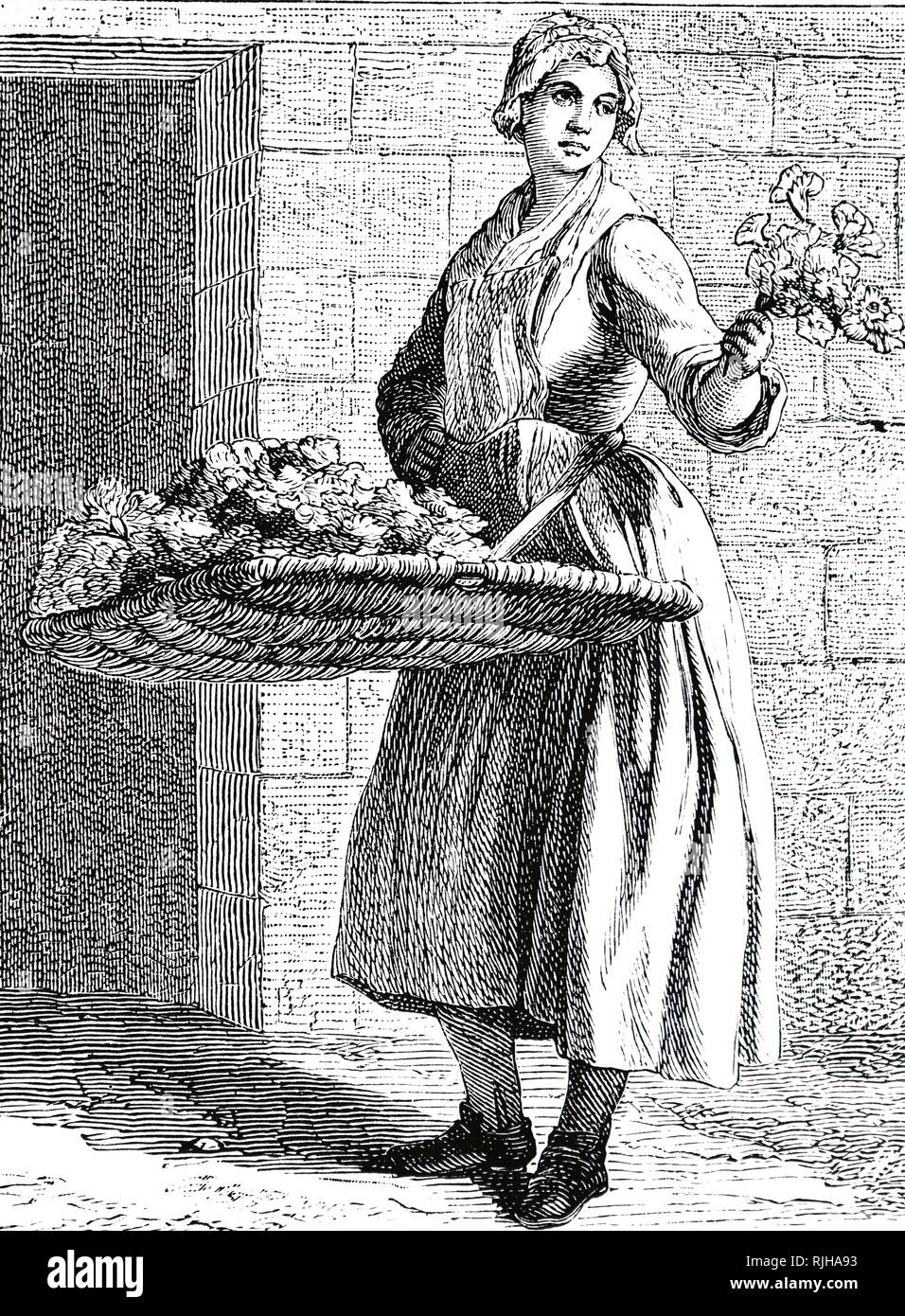 A woodcut engraving depicting a London street seller. Dated 19th century Stock Photohttps://www.alamy.com/image-license-details/?v=1https://www.alamy.com/a-woodcut-engraving-depicting-a-london-street-seller-dated-19th-century-image235179871.html
A woodcut engraving depicting a London street seller. Dated 19th century Stock Photohttps://www.alamy.com/image-license-details/?v=1https://www.alamy.com/a-woodcut-engraving-depicting-a-london-street-seller-dated-19th-century-image235179871.htmlRMRJHA93–A woodcut engraving depicting a London street seller. Dated 19th century
 right: Tim McMullan (Philip Gaddam) with Coram girls in CORAM BOY by Helen Edmundson at the Olivier Theatre, National Theatre (NT), London SE1 07/12/2006 adapted from the novel by Jamila Gavin design: Ti Green & Melly Still lighting: Paule Constable director: Melly Still Stock Photohttps://www.alamy.com/image-license-details/?v=1https://www.alamy.com/right-tim-mcmullan-philip-gaddam-with-coram-girls-in-coram-boy-by-helen-edmundson-at-the-olivier-theatre-national-theatre-nt-london-se1-07122006-adapted-from-the-novel-by-jamila-gavin-design-ti-green-melly-still-lighting-paule-constable-director-melly-still-image576429153.html
right: Tim McMullan (Philip Gaddam) with Coram girls in CORAM BOY by Helen Edmundson at the Olivier Theatre, National Theatre (NT), London SE1 07/12/2006 adapted from the novel by Jamila Gavin design: Ti Green & Melly Still lighting: Paule Constable director: Melly Still Stock Photohttps://www.alamy.com/image-license-details/?v=1https://www.alamy.com/right-tim-mcmullan-philip-gaddam-with-coram-girls-in-coram-boy-by-helen-edmundson-at-the-olivier-theatre-national-theatre-nt-london-se1-07122006-adapted-from-the-novel-by-jamila-gavin-design-ti-green-melly-still-lighting-paule-constable-director-melly-still-image576429153.htmlRM2TDPH7D–right: Tim McMullan (Philip Gaddam) with Coram girls in CORAM BOY by Helen Edmundson at the Olivier Theatre, National Theatre (NT), London SE1 07/12/2006 adapted from the novel by Jamila Gavin design: Ti Green & Melly Still lighting: Paule Constable director: Melly Still
 Engraving depicting a young boy giving money to a homeless mother. Dated 18th century Stock Photohttps://www.alamy.com/image-license-details/?v=1https://www.alamy.com/engraving-depicting-a-young-boy-giving-money-to-a-homeless-mother-dated-18th-century-image186347223.html
Engraving depicting a young boy giving money to a homeless mother. Dated 18th century Stock Photohttps://www.alamy.com/image-license-details/?v=1https://www.alamy.com/engraving-depicting-a-young-boy-giving-money-to-a-homeless-mother-dated-18th-century-image186347223.htmlRMMR4RNY–Engraving depicting a young boy giving money to a homeless mother. Dated 18th century
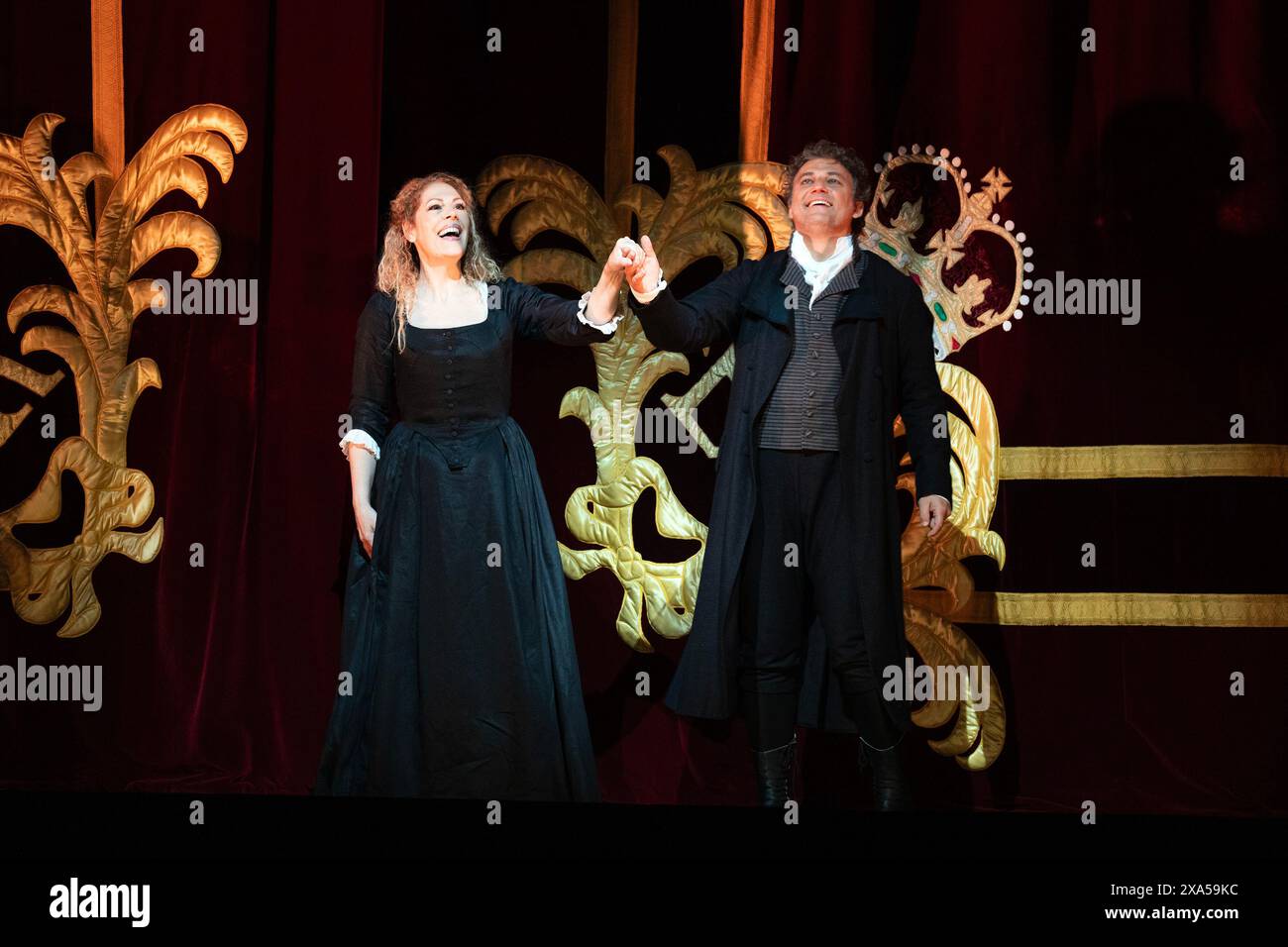 Sondra Radvanovsky (Maddalena di Coigny) and Jonas Kaufmann (Andrea Chenier) at the curtain call for the dress rehearsal of ANDREA CHENIER by Umberto Giordano at The Royal Opera, Covent Garden, London WC2 on 28/05/2024. Stock Photohttps://www.alamy.com/image-license-details/?v=1https://www.alamy.com/sondra-radvanovsky-maddalena-di-coigny-and-jonas-kaufmann-andrea-chenier-at-the-curtain-call-for-the-dress-rehearsal-of-andrea-chenier-by-umberto-giordano-at-the-royal-opera-covent-garden-london-wc2-on-28052024-image608626800.html
Sondra Radvanovsky (Maddalena di Coigny) and Jonas Kaufmann (Andrea Chenier) at the curtain call for the dress rehearsal of ANDREA CHENIER by Umberto Giordano at The Royal Opera, Covent Garden, London WC2 on 28/05/2024. Stock Photohttps://www.alamy.com/image-license-details/?v=1https://www.alamy.com/sondra-radvanovsky-maddalena-di-coigny-and-jonas-kaufmann-andrea-chenier-at-the-curtain-call-for-the-dress-rehearsal-of-andrea-chenier-by-umberto-giordano-at-the-royal-opera-covent-garden-london-wc2-on-28052024-image608626800.htmlRM2XA59KC–Sondra Radvanovsky (Maddalena di Coigny) and Jonas Kaufmann (Andrea Chenier) at the curtain call for the dress rehearsal of ANDREA CHENIER by Umberto Giordano at The Royal Opera, Covent Garden, London WC2 on 28/05/2024.
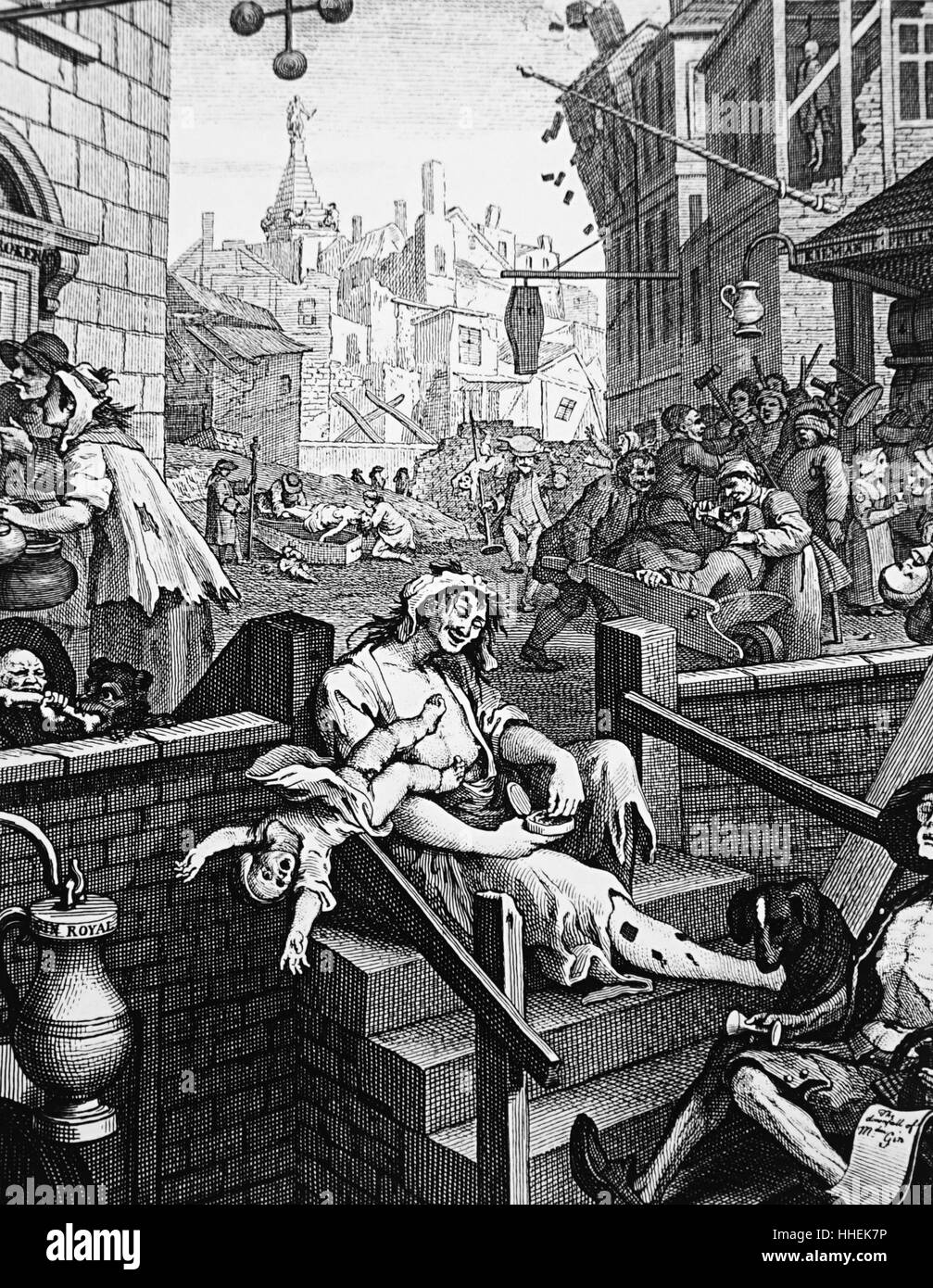 Engraving titled 'Gin Lane' by William Hogarth (1697-1764) depicting the evils of unbridled drinking of spirits. Dated 18th Century Stock Photohttps://www.alamy.com/image-license-details/?v=1https://www.alamy.com/stock-photo-engraving-titled-gin-lane-by-william-hogarth-1697-1764-depicting-the-131244170.html
Engraving titled 'Gin Lane' by William Hogarth (1697-1764) depicting the evils of unbridled drinking of spirits. Dated 18th Century Stock Photohttps://www.alamy.com/image-license-details/?v=1https://www.alamy.com/stock-photo-engraving-titled-gin-lane-by-william-hogarth-1697-1764-depicting-the-131244170.htmlRMHHEK7P–Engraving titled 'Gin Lane' by William Hogarth (1697-1764) depicting the evils of unbridled drinking of spirits. Dated 18th Century
 18th century Child token, given to the Foundling Hospital in London. Mothers left tokens with their babies, so that, if circumstances improved for them, the mothers could reclaim their children. The Foundling Hospital in London, England, was founded in 1739 by the philanthropic sea captain Thomas Coram. It was a children's home established for the 'education and maintenance of exposed and deserted young children Stock Photohttps://www.alamy.com/image-license-details/?v=1https://www.alamy.com/18th-century-child-token-given-to-the-foundling-hospital-in-london-mothers-left-tokens-with-their-babies-so-that-if-circumstances-improved-for-them-the-mothers-could-reclaim-their-children-the-foundling-hospital-in-london-england-was-founded-in-1739-by-the-philanthropic-sea-captain-thomas-coram-it-was-a-childrens-home-established-for-the-education-and-maintenance-of-exposed-and-deserted-young-children-image240279831.html
18th century Child token, given to the Foundling Hospital in London. Mothers left tokens with their babies, so that, if circumstances improved for them, the mothers could reclaim their children. The Foundling Hospital in London, England, was founded in 1739 by the philanthropic sea captain Thomas Coram. It was a children's home established for the 'education and maintenance of exposed and deserted young children Stock Photohttps://www.alamy.com/image-license-details/?v=1https://www.alamy.com/18th-century-child-token-given-to-the-foundling-hospital-in-london-mothers-left-tokens-with-their-babies-so-that-if-circumstances-improved-for-them-the-mothers-could-reclaim-their-children-the-foundling-hospital-in-london-england-was-founded-in-1739-by-the-philanthropic-sea-captain-thomas-coram-it-was-a-childrens-home-established-for-the-education-and-maintenance-of-exposed-and-deserted-young-children-image240279831.htmlRMRXWKAF–18th century Child token, given to the Foundling Hospital in London. Mothers left tokens with their babies, so that, if circumstances improved for them, the mothers could reclaim their children. The Foundling Hospital in London, England, was founded in 1739 by the philanthropic sea captain Thomas Coram. It was a children's home established for the 'education and maintenance of exposed and deserted young children
 Beer Street - caricature by William Hogarth. WH: English painter and artist, 10 November 1697 -October 1764. Stock Photohttps://www.alamy.com/image-license-details/?v=1https://www.alamy.com/stock-photo-beer-street-caricature-by-william-hogarth-wh-english-painter-and-artist-83341447.html
Beer Street - caricature by William Hogarth. WH: English painter and artist, 10 November 1697 -October 1764. Stock Photohttps://www.alamy.com/image-license-details/?v=1https://www.alamy.com/stock-photo-beer-street-caricature-by-william-hogarth-wh-english-painter-and-artist-83341447.htmlRMERGET7–Beer Street - caricature by William Hogarth. WH: English painter and artist, 10 November 1697 -October 1764.
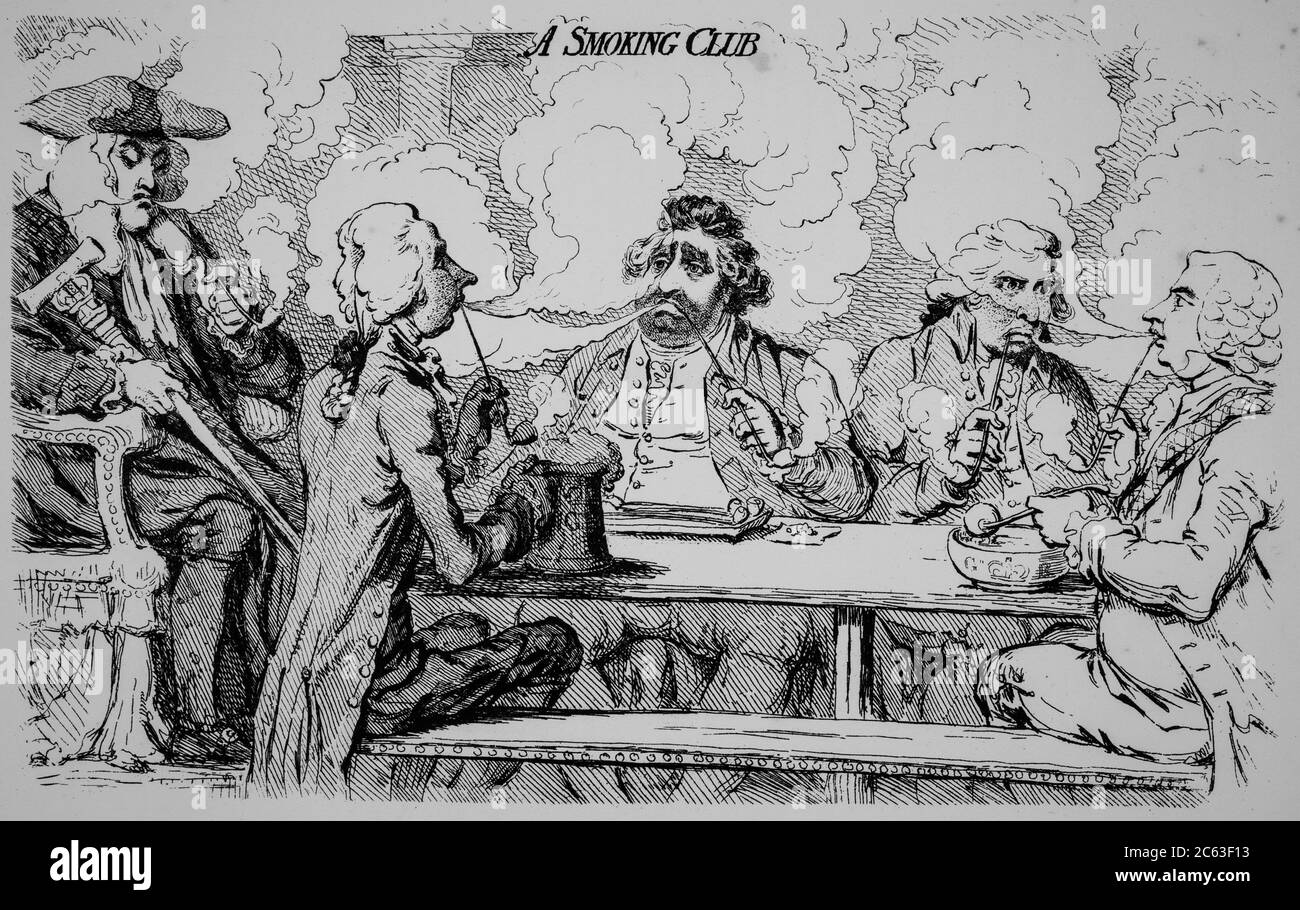 A Smoking Club James Gillray engraving print Stock Photohttps://www.alamy.com/image-license-details/?v=1https://www.alamy.com/a-smoking-club-james-gillray-engraving-print-image365183311.html
A Smoking Club James Gillray engraving print Stock Photohttps://www.alamy.com/image-license-details/?v=1https://www.alamy.com/a-smoking-club-james-gillray-engraving-print-image365183311.htmlRM2C63F13–A Smoking Club James Gillray engraving print
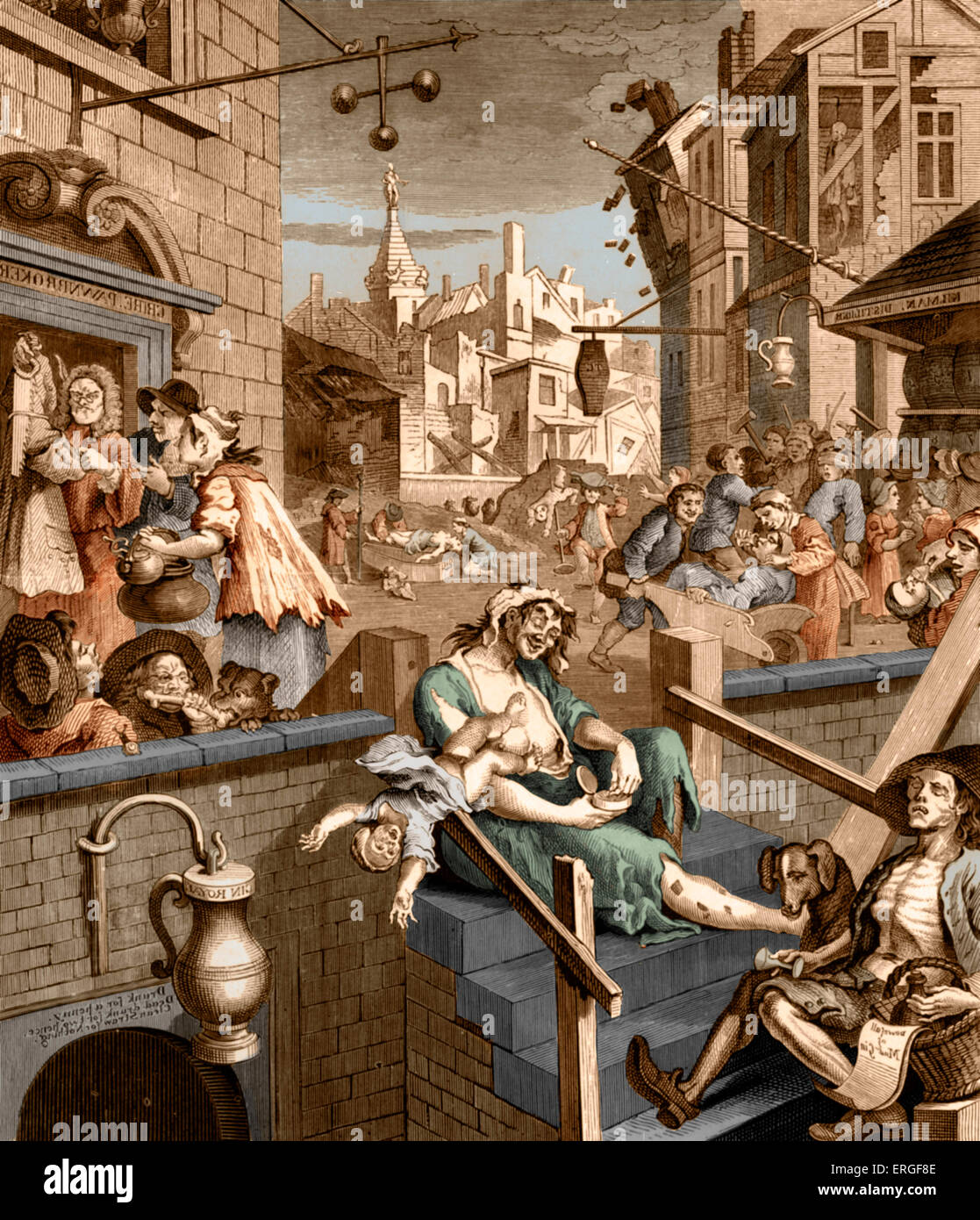 Gin Lane - caricature by William Hogarth, circa 1750. WH: English painter and artist, 10 November 1697 -October 1764. Stock Photohttps://www.alamy.com/image-license-details/?v=1https://www.alamy.com/stock-photo-gin-lane-caricature-by-william-hogarth-circa-1750-wh-english-painter-83341790.html
Gin Lane - caricature by William Hogarth, circa 1750. WH: English painter and artist, 10 November 1697 -October 1764. Stock Photohttps://www.alamy.com/image-license-details/?v=1https://www.alamy.com/stock-photo-gin-lane-caricature-by-william-hogarth-circa-1750-wh-english-painter-83341790.htmlRMERGF8E–Gin Lane - caricature by William Hogarth, circa 1750. WH: English painter and artist, 10 November 1697 -October 1764.
 Thomas Coram outside the Foundling Hospital, London, (c1750?). Artist: Unknown Stock Photohttps://www.alamy.com/image-license-details/?v=1https://www.alamy.com/thomas-coram-outside-the-foundling-hospital-london-c1750-artist-unknown-image60061838.html
Thomas Coram outside the Foundling Hospital, London, (c1750?). Artist: Unknown Stock Photohttps://www.alamy.com/image-license-details/?v=1https://www.alamy.com/thomas-coram-outside-the-foundling-hospital-london-c1750-artist-unknown-image60061838.htmlRMDDM1DJ–Thomas Coram outside the Foundling Hospital, London, (c1750?). Artist: Unknown
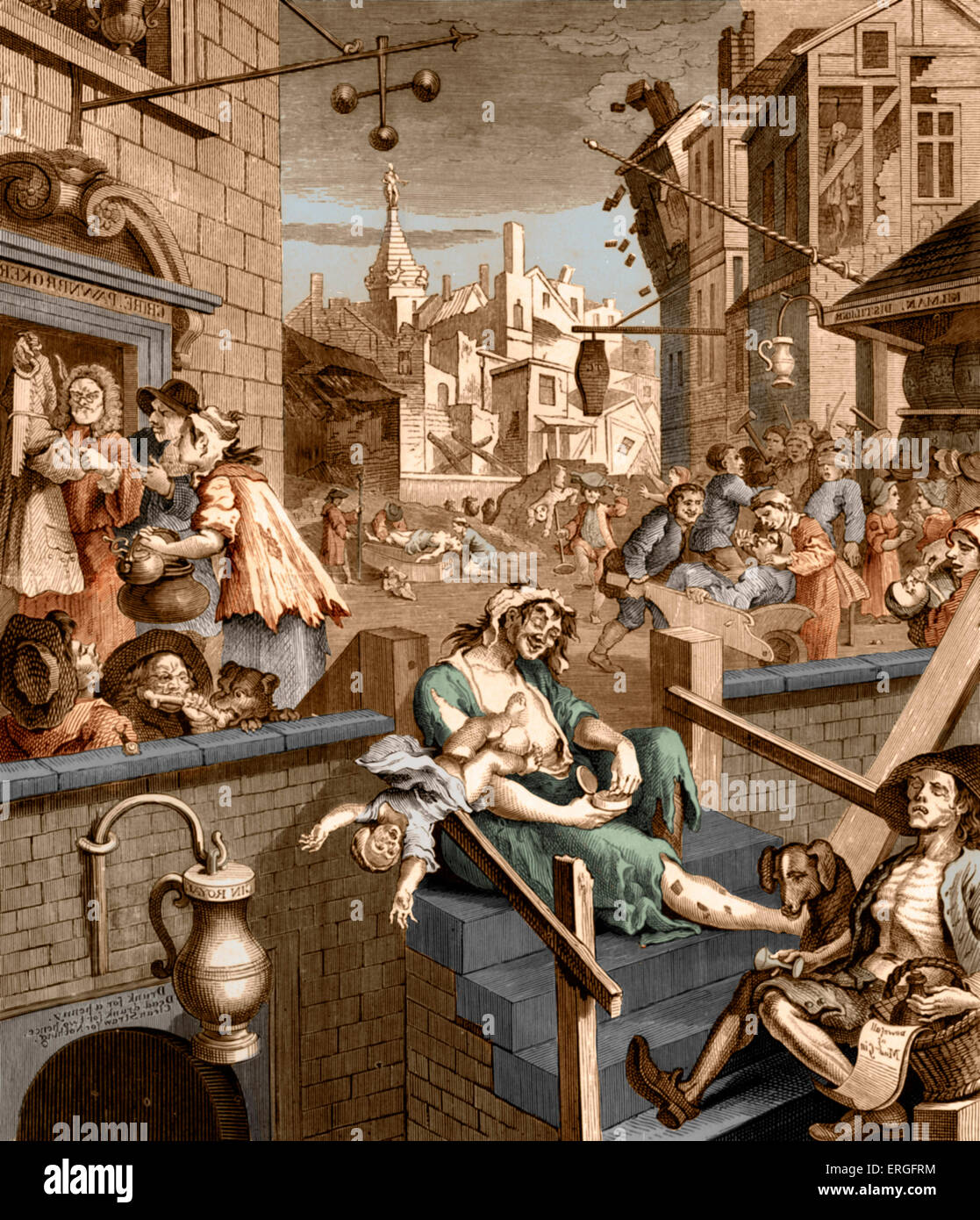 Gin Lane - caricature by William Hogarth, circa 1750. WH: English painter and artist, 10 November 1697 -October 1764. Stock Photohttps://www.alamy.com/image-license-details/?v=1https://www.alamy.com/stock-photo-gin-lane-caricature-by-william-hogarth-circa-1750-wh-english-painter-83342216.html
Gin Lane - caricature by William Hogarth, circa 1750. WH: English painter and artist, 10 November 1697 -October 1764. Stock Photohttps://www.alamy.com/image-license-details/?v=1https://www.alamy.com/stock-photo-gin-lane-caricature-by-william-hogarth-circa-1750-wh-english-painter-83342216.htmlRMERGFRM–Gin Lane - caricature by William Hogarth, circa 1750. WH: English painter and artist, 10 November 1697 -October 1764.
 A crowded coach travelling between Greenwich and Charing Cross, London, 1783. Artist: Anon Stock Photohttps://www.alamy.com/image-license-details/?v=1https://www.alamy.com/a-crowded-coach-travelling-between-greenwich-and-charing-cross-london-image60090219.html
A crowded coach travelling between Greenwich and Charing Cross, London, 1783. Artist: Anon Stock Photohttps://www.alamy.com/image-license-details/?v=1https://www.alamy.com/a-crowded-coach-travelling-between-greenwich-and-charing-cross-london-image60090219.htmlRMDDN9K7–A crowded coach travelling between Greenwich and Charing Cross, London, 1783. Artist: Anon
 Fishmongers' Almshouses at St Peter's Hospital, Newington Butts, Southwark, London, c1750. Artist: Anon Stock Photohttps://www.alamy.com/image-license-details/?v=1https://www.alamy.com/fishmongers-almshouses-at-st-peters-hospital-newington-butts-southwark-image60162969.html
Fishmongers' Almshouses at St Peter's Hospital, Newington Butts, Southwark, London, c1750. Artist: Anon Stock Photohttps://www.alamy.com/image-license-details/?v=1https://www.alamy.com/fishmongers-almshouses-at-st-peters-hospital-newington-butts-southwark-image60162969.htmlRMDDTJDD–Fishmongers' Almshouses at St Peter's Hospital, Newington Butts, Southwark, London, c1750. Artist: Anon
 Noon, plate two from The Four Times of the Day. William Hogarth; English, 1697-1764. Date: 1738. Dimensions: 450 × 380 mm (image); 488 × 402 mm (plate); 660 × 497 mm (sheet). Etching and engraving in black on ivory laid paper. Origin: England. Museum: The Chicago Art Institute. Stock Photohttps://www.alamy.com/image-license-details/?v=1https://www.alamy.com/noon-plate-two-from-the-four-times-of-the-day-william-hogarth-english-1697-1764-date-1738-dimensions-450-380-mm-image-488-402-mm-plate-660-497-mm-sheet-etching-and-engraving-in-black-on-ivory-laid-paper-origin-england-museum-the-chicago-art-institute-image239975806.html
Noon, plate two from The Four Times of the Day. William Hogarth; English, 1697-1764. Date: 1738. Dimensions: 450 × 380 mm (image); 488 × 402 mm (plate); 660 × 497 mm (sheet). Etching and engraving in black on ivory laid paper. Origin: England. Museum: The Chicago Art Institute. Stock Photohttps://www.alamy.com/image-license-details/?v=1https://www.alamy.com/noon-plate-two-from-the-four-times-of-the-day-william-hogarth-english-1697-1764-date-1738-dimensions-450-380-mm-image-488-402-mm-plate-660-497-mm-sheet-etching-and-engraving-in-black-on-ivory-laid-paper-origin-england-museum-the-chicago-art-institute-image239975806.htmlRMRXBRGE–Noon, plate two from The Four Times of the Day. William Hogarth; English, 1697-1764. Date: 1738. Dimensions: 450 × 380 mm (image); 488 × 402 mm (plate); 660 × 497 mm (sheet). Etching and engraving in black on ivory laid paper. Origin: England. Museum: The Chicago Art Institute.
 l-r: Amartuvshin Enkhbat (Carlo Gerard), Sondra Radvanovsky (Maddalena di Coigny), Jonas Kaufmann (Andrea Chenier), Antonio Pappano (conductor), Katia Ledoux (Bersi), Elena Zilio (Madelon) at the curtain call for the dress rehearsal of ANDREA CHENIER by Umberto Giordano at The Royal Opera, Covent Garden, London WC2 on 28/05/2024. Stock Photohttps://www.alamy.com/image-license-details/?v=1https://www.alamy.com/l-r-amartuvshin-enkhbat-carlo-gerard-sondra-radvanovsky-maddalena-di-coigny-jonas-kaufmann-andrea-chenier-antonio-pappano-conductor-katia-ledoux-bersi-elena-zilio-madelon-at-the-curtain-call-for-the-dress-rehearsal-of-andrea-chenier-by-umberto-giordano-at-the-royal-opera-covent-garden-london-wc2-on-28052024-image608626802.html
l-r: Amartuvshin Enkhbat (Carlo Gerard), Sondra Radvanovsky (Maddalena di Coigny), Jonas Kaufmann (Andrea Chenier), Antonio Pappano (conductor), Katia Ledoux (Bersi), Elena Zilio (Madelon) at the curtain call for the dress rehearsal of ANDREA CHENIER by Umberto Giordano at The Royal Opera, Covent Garden, London WC2 on 28/05/2024. Stock Photohttps://www.alamy.com/image-license-details/?v=1https://www.alamy.com/l-r-amartuvshin-enkhbat-carlo-gerard-sondra-radvanovsky-maddalena-di-coigny-jonas-kaufmann-andrea-chenier-antonio-pappano-conductor-katia-ledoux-bersi-elena-zilio-madelon-at-the-curtain-call-for-the-dress-rehearsal-of-andrea-chenier-by-umberto-giordano-at-the-royal-opera-covent-garden-london-wc2-on-28052024-image608626802.htmlRM2XA59KE–l-r: Amartuvshin Enkhbat (Carlo Gerard), Sondra Radvanovsky (Maddalena di Coigny), Jonas Kaufmann (Andrea Chenier), Antonio Pappano (conductor), Katia Ledoux (Bersi), Elena Zilio (Madelon) at the curtain call for the dress rehearsal of ANDREA CHENIER by Umberto Giordano at The Royal Opera, Covent Garden, London WC2 on 28/05/2024.
 Engraving titled 'Beer Street' by William Hogarth (1697-1764) depicting the evils of unbridled drinking of spirits. Dated 18th Century Stock Photohttps://www.alamy.com/image-license-details/?v=1https://www.alamy.com/stock-photo-engraving-titled-beer-street-by-william-hogarth-1697-1764-depicting-131244171.html
Engraving titled 'Beer Street' by William Hogarth (1697-1764) depicting the evils of unbridled drinking of spirits. Dated 18th Century Stock Photohttps://www.alamy.com/image-license-details/?v=1https://www.alamy.com/stock-photo-engraving-titled-beer-street-by-william-hogarth-1697-1764-depicting-131244171.htmlRMHHEK7R–Engraving titled 'Beer Street' by William Hogarth (1697-1764) depicting the evils of unbridled drinking of spirits. Dated 18th Century
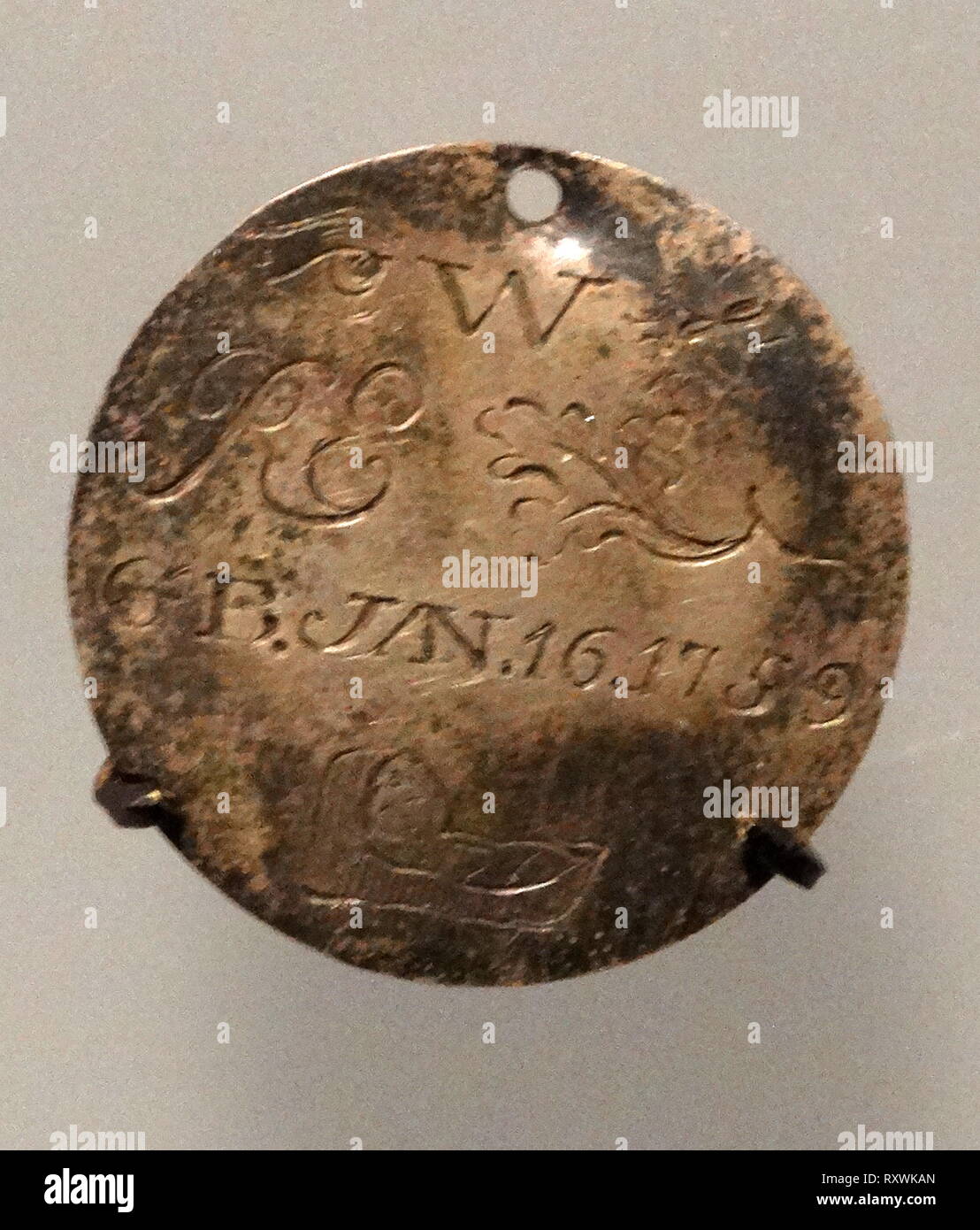 18th century Child token, given to the Foundling Hospital in London. Mothers left tokens with their babies, so that, if circumstances improved for them, the mothers could reclaim their children. The Foundling Hospital in London, England, was founded in 1739 by the philanthropic sea captain Thomas Coram. It was a children's home established for the 'education and maintenance of exposed and deserted young children Stock Photohttps://www.alamy.com/image-license-details/?v=1https://www.alamy.com/18th-century-child-token-given-to-the-foundling-hospital-in-london-mothers-left-tokens-with-their-babies-so-that-if-circumstances-improved-for-them-the-mothers-could-reclaim-their-children-the-foundling-hospital-in-london-england-was-founded-in-1739-by-the-philanthropic-sea-captain-thomas-coram-it-was-a-childrens-home-established-for-the-education-and-maintenance-of-exposed-and-deserted-young-children-image240279837.html
18th century Child token, given to the Foundling Hospital in London. Mothers left tokens with their babies, so that, if circumstances improved for them, the mothers could reclaim their children. The Foundling Hospital in London, England, was founded in 1739 by the philanthropic sea captain Thomas Coram. It was a children's home established for the 'education and maintenance of exposed and deserted young children Stock Photohttps://www.alamy.com/image-license-details/?v=1https://www.alamy.com/18th-century-child-token-given-to-the-foundling-hospital-in-london-mothers-left-tokens-with-their-babies-so-that-if-circumstances-improved-for-them-the-mothers-could-reclaim-their-children-the-foundling-hospital-in-london-england-was-founded-in-1739-by-the-philanthropic-sea-captain-thomas-coram-it-was-a-childrens-home-established-for-the-education-and-maintenance-of-exposed-and-deserted-young-children-image240279837.htmlRMRXWKAN–18th century Child token, given to the Foundling Hospital in London. Mothers left tokens with their babies, so that, if circumstances improved for them, the mothers could reclaim their children. The Foundling Hospital in London, England, was founded in 1739 by the philanthropic sea captain Thomas Coram. It was a children's home established for the 'education and maintenance of exposed and deserted young children
 Westminster Abbey and St Margaret's Church, London, c1755. Artist: Anon Stock Photohttps://www.alamy.com/image-license-details/?v=1https://www.alamy.com/westminster-abbey-and-st-margarets-church-london-c1755-artist-anon-image60163525.html
Westminster Abbey and St Margaret's Church, London, c1755. Artist: Anon Stock Photohttps://www.alamy.com/image-license-details/?v=1https://www.alamy.com/westminster-abbey-and-st-margarets-church-london-c1755-artist-anon-image60163525.htmlRMDDTK59–Westminster Abbey and St Margaret's Church, London, c1755. Artist: Anon
 View of Dulwich College in Surrey. Established in 1619 as College of God's Gift, the charity school for the poor was in decline in the late 18th century. College to the left, an old man with walking sticks, man riding a horse, and two figures on the lawn. Copperplate engraving after John Oliphant from William Thorntons New, Complete and Universal History of the City of London, Alexander Hogg, King's Arms, No. 16 Paternoster Row, London, 1784. Stock Photohttps://www.alamy.com/image-license-details/?v=1https://www.alamy.com/view-of-dulwich-college-in-surrey-established-in-1619-as-college-of-gods-gift-the-charity-school-for-the-poor-was-in-decline-in-the-late-18th-century-college-to-the-left-an-old-man-with-walking-sticks-man-riding-a-horse-and-two-figures-on-the-lawn-copperplate-engraving-after-john-oliphant-from-william-thorntons-new-complete-and-universal-history-of-the-city-of-london-alexander-hogg-kings-arms-no-16-paternoster-row-london-1784-image571824237.html
View of Dulwich College in Surrey. Established in 1619 as College of God's Gift, the charity school for the poor was in decline in the late 18th century. College to the left, an old man with walking sticks, man riding a horse, and two figures on the lawn. Copperplate engraving after John Oliphant from William Thorntons New, Complete and Universal History of the City of London, Alexander Hogg, King's Arms, No. 16 Paternoster Row, London, 1784. Stock Photohttps://www.alamy.com/image-license-details/?v=1https://www.alamy.com/view-of-dulwich-college-in-surrey-established-in-1619-as-college-of-gods-gift-the-charity-school-for-the-poor-was-in-decline-in-the-late-18th-century-college-to-the-left-an-old-man-with-walking-sticks-man-riding-a-horse-and-two-figures-on-the-lawn-copperplate-engraving-after-john-oliphant-from-william-thorntons-new-complete-and-universal-history-of-the-city-of-london-alexander-hogg-kings-arms-no-16-paternoster-row-london-1784-image571824237.htmlRM2T68RJ5–View of Dulwich College in Surrey. Established in 1619 as College of God's Gift, the charity school for the poor was in decline in the late 18th century. College to the left, an old man with walking sticks, man riding a horse, and two figures on the lawn. Copperplate engraving after John Oliphant from William Thorntons New, Complete and Universal History of the City of London, Alexander Hogg, King's Arms, No. 16 Paternoster Row, London, 1784.
 James Cleverton (Mathieu) in ANDREA CHENIER at the The Royal Opera, Covent Garden, London WC2 30/05/2024 music: Umberto Giordano libretto: Luigi Illica conductor: Antonio Pappano design: Robert Jones costumes: Jenny Tiramani lighting: Adam Silverman original choreography & movement: Andrew George revival choreographer: Agurtzane Arrien original director: David McVicar revival director: Thomas Guthrie Stock Photohttps://www.alamy.com/image-license-details/?v=1https://www.alamy.com/james-cleverton-mathieu-in-andrea-chenier-at-the-the-royal-opera-covent-garden-london-wc2-30052024-music-umberto-giordano-libretto-luigi-illica-conductor-antonio-pappano-design-robert-jones-costumes-jenny-tiramani-lighting-adam-silverman-original-choreography-movement-andrew-george-revival-choreographer-agurtzane-arrien-original-director-david-mcvicar-revival-director-thomas-guthrie-image609366004.html
James Cleverton (Mathieu) in ANDREA CHENIER at the The Royal Opera, Covent Garden, London WC2 30/05/2024 music: Umberto Giordano libretto: Luigi Illica conductor: Antonio Pappano design: Robert Jones costumes: Jenny Tiramani lighting: Adam Silverman original choreography & movement: Andrew George revival choreographer: Agurtzane Arrien original director: David McVicar revival director: Thomas Guthrie Stock Photohttps://www.alamy.com/image-license-details/?v=1https://www.alamy.com/james-cleverton-mathieu-in-andrea-chenier-at-the-the-royal-opera-covent-garden-london-wc2-30052024-music-umberto-giordano-libretto-luigi-illica-conductor-antonio-pappano-design-robert-jones-costumes-jenny-tiramani-lighting-adam-silverman-original-choreography-movement-andrew-george-revival-choreographer-agurtzane-arrien-original-director-david-mcvicar-revival-director-thomas-guthrie-image609366004.htmlRM2XBB0FG–James Cleverton (Mathieu) in ANDREA CHENIER at the The Royal Opera, Covent Garden, London WC2 30/05/2024 music: Umberto Giordano libretto: Luigi Illica conductor: Antonio Pappano design: Robert Jones costumes: Jenny Tiramani lighting: Adam Silverman original choreography & movement: Andrew George revival choreographer: Agurtzane Arrien original director: David McVicar revival director: Thomas Guthrie
 18th century Child token, given to the Foundling Hospital in London. Mothers left tokens with their babies, so that, if circumstances improved for them, the mothers could reclaim their children. The Foundling Hospital in London, England, was founded in 1739 by the philanthropic sea captain Thomas Coram. It was a children's home established for the 'education and maintenance of exposed and deserted young children Stock Photohttps://www.alamy.com/image-license-details/?v=1https://www.alamy.com/18th-century-child-token-given-to-the-foundling-hospital-in-london-mothers-left-tokens-with-their-babies-so-that-if-circumstances-improved-for-them-the-mothers-could-reclaim-their-children-the-foundling-hospital-in-london-england-was-founded-in-1739-by-the-philanthropic-sea-captain-thomas-coram-it-was-a-childrens-home-established-for-the-education-and-maintenance-of-exposed-and-deserted-young-children-image240279822.html
18th century Child token, given to the Foundling Hospital in London. Mothers left tokens with their babies, so that, if circumstances improved for them, the mothers could reclaim their children. The Foundling Hospital in London, England, was founded in 1739 by the philanthropic sea captain Thomas Coram. It was a children's home established for the 'education and maintenance of exposed and deserted young children Stock Photohttps://www.alamy.com/image-license-details/?v=1https://www.alamy.com/18th-century-child-token-given-to-the-foundling-hospital-in-london-mothers-left-tokens-with-their-babies-so-that-if-circumstances-improved-for-them-the-mothers-could-reclaim-their-children-the-foundling-hospital-in-london-england-was-founded-in-1739-by-the-philanthropic-sea-captain-thomas-coram-it-was-a-childrens-home-established-for-the-education-and-maintenance-of-exposed-and-deserted-young-children-image240279822.htmlRMRXWKA6–18th century Child token, given to the Foundling Hospital in London. Mothers left tokens with their babies, so that, if circumstances improved for them, the mothers could reclaim their children. The Foundling Hospital in London, England, was founded in 1739 by the philanthropic sea captain Thomas Coram. It was a children's home established for the 'education and maintenance of exposed and deserted young children
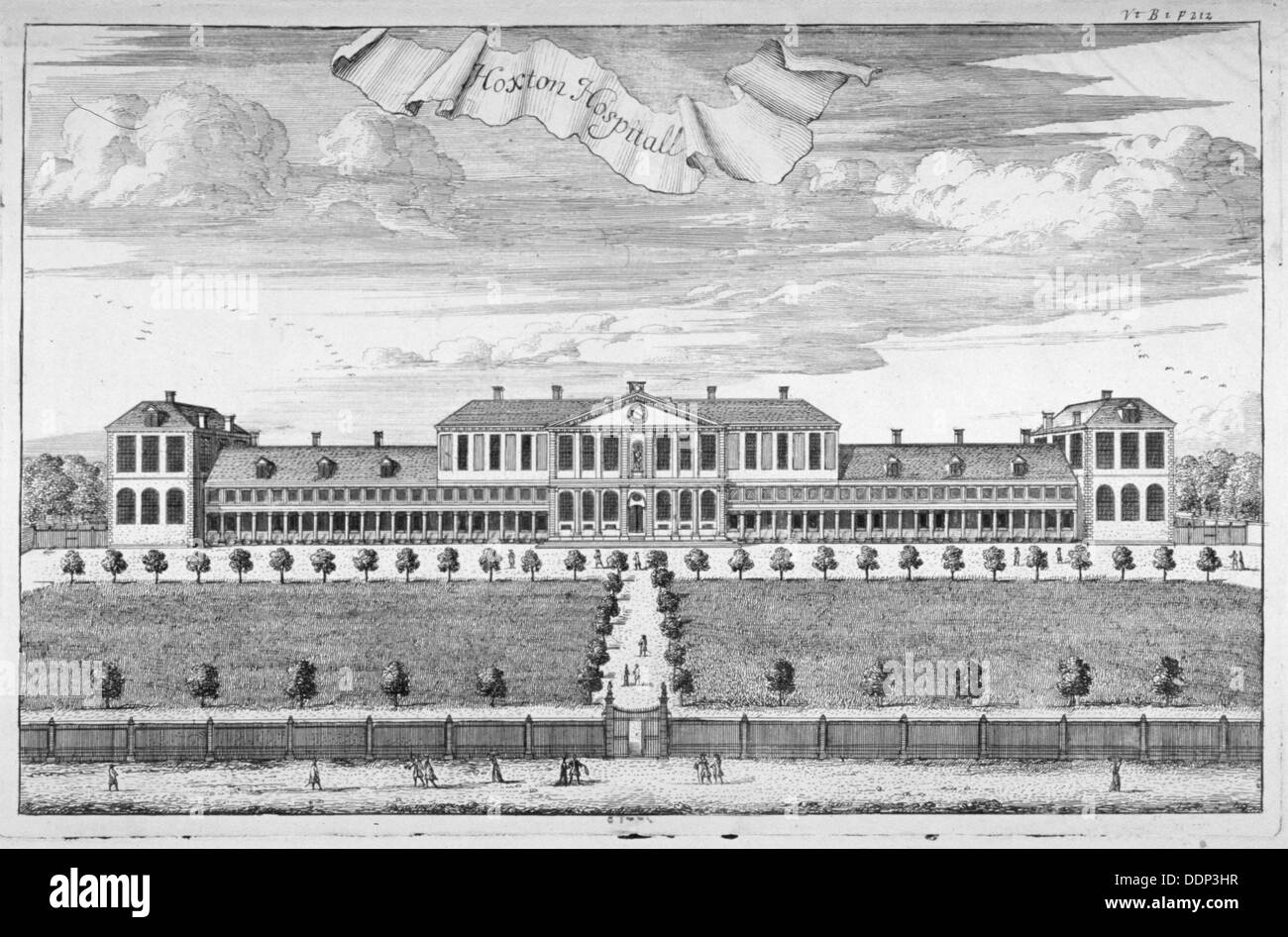 Almshouses in Pitfield Street, Shoreditch, London, c1720. Artist: Johannes Kip Stock Photohttps://www.alamy.com/image-license-details/?v=1https://www.alamy.com/almshouses-in-pitfield-street-shoreditch-london-c1720-artist-johannes-image60107427.html
Almshouses in Pitfield Street, Shoreditch, London, c1720. Artist: Johannes Kip Stock Photohttps://www.alamy.com/image-license-details/?v=1https://www.alamy.com/almshouses-in-pitfield-street-shoreditch-london-c1720-artist-johannes-image60107427.htmlRMDDP3HR–Almshouses in Pitfield Street, Shoreditch, London, c1720. Artist: Johannes Kip
 Boy chimney sweep selling soot in front of the Foundling Hospital. The child sweep in black cap with brass plate indicating his employer, sack of soot, sold as manure. In front of the Foundling Hospital, a charity established in the 18th century for orphans. Handcoloured copperplate engraving by Edward Edwards after an illustration by William Marshall Craig from Description of the Plates Representing the Itinerant Traders of London, Richard Phillips, No. 71 St Pauls Churchyard, London, 1805. Stock Photohttps://www.alamy.com/image-license-details/?v=1https://www.alamy.com/boy-chimney-sweep-selling-soot-in-front-of-the-foundling-hospital-the-child-sweep-in-black-cap-with-brass-plate-indicating-his-employer-sack-of-soot-sold-as-manure-in-front-of-the-foundling-hospital-a-charity-established-in-the-18th-century-for-orphans-handcoloured-copperplate-engraving-by-edward-edwards-after-an-illustration-by-william-marshall-craig-from-description-of-the-plates-representing-the-itinerant-traders-of-london-richard-phillips-no-71-st-pauls-churchyard-london-1805-image571833316.html
Boy chimney sweep selling soot in front of the Foundling Hospital. The child sweep in black cap with brass plate indicating his employer, sack of soot, sold as manure. In front of the Foundling Hospital, a charity established in the 18th century for orphans. Handcoloured copperplate engraving by Edward Edwards after an illustration by William Marshall Craig from Description of the Plates Representing the Itinerant Traders of London, Richard Phillips, No. 71 St Pauls Churchyard, London, 1805. Stock Photohttps://www.alamy.com/image-license-details/?v=1https://www.alamy.com/boy-chimney-sweep-selling-soot-in-front-of-the-foundling-hospital-the-child-sweep-in-black-cap-with-brass-plate-indicating-his-employer-sack-of-soot-sold-as-manure-in-front-of-the-foundling-hospital-a-charity-established-in-the-18th-century-for-orphans-handcoloured-copperplate-engraving-by-edward-edwards-after-an-illustration-by-william-marshall-craig-from-description-of-the-plates-representing-the-itinerant-traders-of-london-richard-phillips-no-71-st-pauls-churchyard-london-1805-image571833316.htmlRM2T6976C–Boy chimney sweep selling soot in front of the Foundling Hospital. The child sweep in black cap with brass plate indicating his employer, sack of soot, sold as manure. In front of the Foundling Hospital, a charity established in the 18th century for orphans. Handcoloured copperplate engraving by Edward Edwards after an illustration by William Marshall Craig from Description of the Plates Representing the Itinerant Traders of London, Richard Phillips, No. 71 St Pauls Churchyard, London, 1805.
 Katia Ledoux (Bersi) in ANDREA CHENIER at the The Royal Opera, Covent Garden, London WC2 30/05/2024 music: Umberto Giordano libretto: Luigi Illica conductor: Antonio Pappano design: Robert Jones costumes: Jenny Tiramani lighting: Adam Silverman original choreography & movement: Andrew George revival choreographer: Agurtzane Arrien original director: David McVicar revival director: Thomas Guthrie Stock Photohttps://www.alamy.com/image-license-details/?v=1https://www.alamy.com/katia-ledoux-bersi-in-andrea-chenier-at-the-the-royal-opera-covent-garden-london-wc2-30052024-music-umberto-giordano-libretto-luigi-illica-conductor-antonio-pappano-design-robert-jones-costumes-jenny-tiramani-lighting-adam-silverman-original-choreography-movement-andrew-george-revival-choreographer-agurtzane-arrien-original-director-david-mcvicar-revival-director-thomas-guthrie-image608323091.html
Katia Ledoux (Bersi) in ANDREA CHENIER at the The Royal Opera, Covent Garden, London WC2 30/05/2024 music: Umberto Giordano libretto: Luigi Illica conductor: Antonio Pappano design: Robert Jones costumes: Jenny Tiramani lighting: Adam Silverman original choreography & movement: Andrew George revival choreographer: Agurtzane Arrien original director: David McVicar revival director: Thomas Guthrie Stock Photohttps://www.alamy.com/image-license-details/?v=1https://www.alamy.com/katia-ledoux-bersi-in-andrea-chenier-at-the-the-royal-opera-covent-garden-london-wc2-30052024-music-umberto-giordano-libretto-luigi-illica-conductor-antonio-pappano-design-robert-jones-costumes-jenny-tiramani-lighting-adam-silverman-original-choreography-movement-andrew-george-revival-choreographer-agurtzane-arrien-original-director-david-mcvicar-revival-director-thomas-guthrie-image608323091.htmlRM2X9KE8K–Katia Ledoux (Bersi) in ANDREA CHENIER at the The Royal Opera, Covent Garden, London WC2 30/05/2024 music: Umberto Giordano libretto: Luigi Illica conductor: Antonio Pappano design: Robert Jones costumes: Jenny Tiramani lighting: Adam Silverman original choreography & movement: Andrew George revival choreographer: Agurtzane Arrien original director: David McVicar revival director: Thomas Guthrie
 18th century Child token, given to the Foundling Hospital in London. Mothers left tokens with their babies, so that, if circumstances improved for them, the mothers could reclaim their children. The Foundling Hospital in London, England, was founded in 1739 by the philanthropic sea captain Thomas Coram. It was a children's home established for the 'education and maintenance of exposed and deserted young children Stock Photohttps://www.alamy.com/image-license-details/?v=1https://www.alamy.com/18th-century-child-token-given-to-the-foundling-hospital-in-london-mothers-left-tokens-with-their-babies-so-that-if-circumstances-improved-for-them-the-mothers-could-reclaim-their-children-the-foundling-hospital-in-london-england-was-founded-in-1739-by-the-philanthropic-sea-captain-thomas-coram-it-was-a-childrens-home-established-for-the-education-and-maintenance-of-exposed-and-deserted-young-children-image240279817.html
18th century Child token, given to the Foundling Hospital in London. Mothers left tokens with their babies, so that, if circumstances improved for them, the mothers could reclaim their children. The Foundling Hospital in London, England, was founded in 1739 by the philanthropic sea captain Thomas Coram. It was a children's home established for the 'education and maintenance of exposed and deserted young children Stock Photohttps://www.alamy.com/image-license-details/?v=1https://www.alamy.com/18th-century-child-token-given-to-the-foundling-hospital-in-london-mothers-left-tokens-with-their-babies-so-that-if-circumstances-improved-for-them-the-mothers-could-reclaim-their-children-the-foundling-hospital-in-london-england-was-founded-in-1739-by-the-philanthropic-sea-captain-thomas-coram-it-was-a-childrens-home-established-for-the-education-and-maintenance-of-exposed-and-deserted-young-children-image240279817.htmlRMRXWKA1–18th century Child token, given to the Foundling Hospital in London. Mothers left tokens with their babies, so that, if circumstances improved for them, the mothers could reclaim their children. The Foundling Hospital in London, England, was founded in 1739 by the philanthropic sea captain Thomas Coram. It was a children's home established for the 'education and maintenance of exposed and deserted young children
 Men demolishing St Peter's Hospital, Southwark, London, 1851. Artist: James Findlay Stock Photohttps://www.alamy.com/image-license-details/?v=1https://www.alamy.com/men-demolishing-st-peters-hospital-southwark-london-1851-artist-james-image60163035.html
Men demolishing St Peter's Hospital, Southwark, London, 1851. Artist: James Findlay Stock Photohttps://www.alamy.com/image-license-details/?v=1https://www.alamy.com/men-demolishing-st-peters-hospital-southwark-london-1851-artist-james-image60163035.htmlRMDDTJFR–Men demolishing St Peter's Hospital, Southwark, London, 1851. Artist: James Findlay
 Mackerel seller, Cries of London, 1760. Artist: Paul Sandby Stock Photohttps://www.alamy.com/image-license-details/?v=1https://www.alamy.com/mackerel-seller-cries-of-london-1760-artist-paul-sandby-image60088491.html
Mackerel seller, Cries of London, 1760. Artist: Paul Sandby Stock Photohttps://www.alamy.com/image-license-details/?v=1https://www.alamy.com/mackerel-seller-cries-of-london-1760-artist-paul-sandby-image60088491.htmlRMDDN7DF–Mackerel seller, Cries of London, 1760. Artist: Paul Sandby
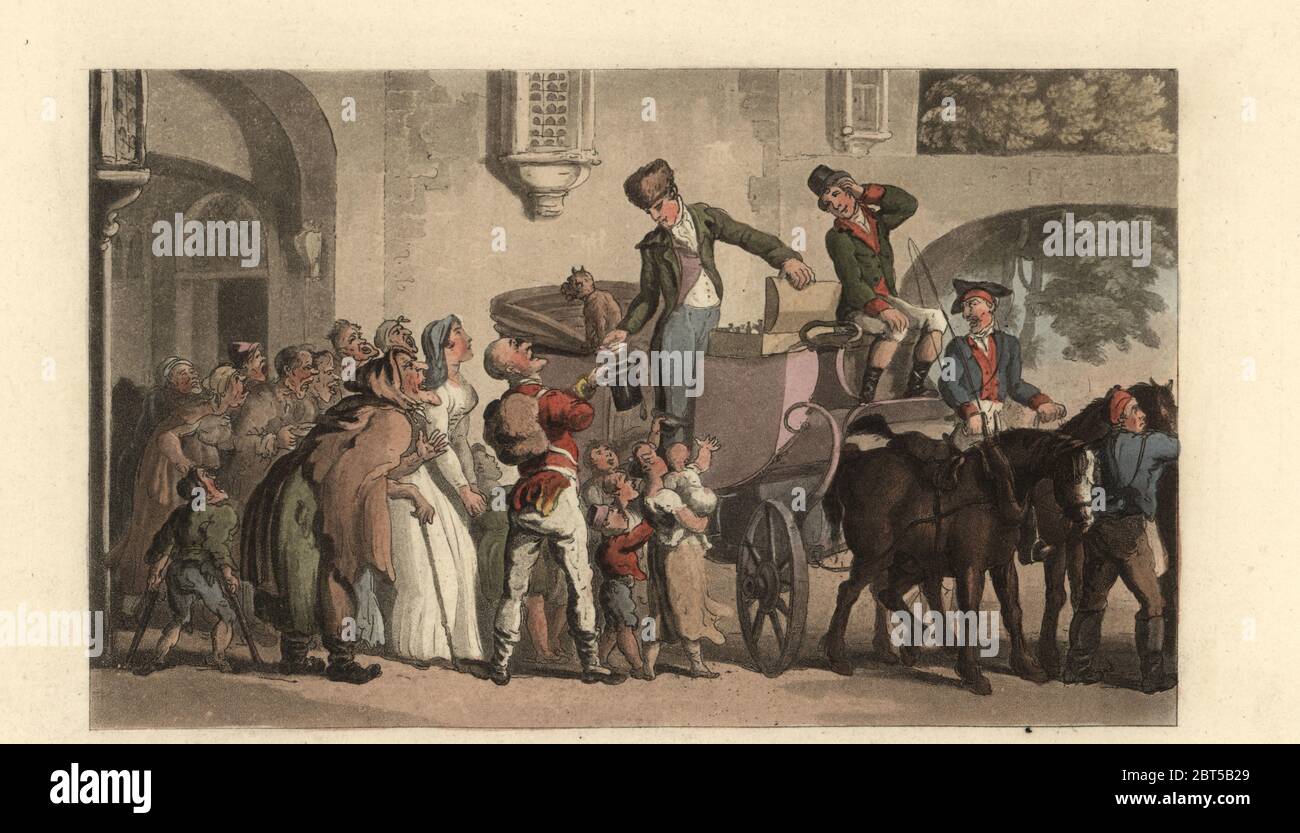 English gentleman dispensing his medicine cabinet to beggars at Ivry-sur Seine, 18th century. He gives aerated salts to a one-armed soldier, Bruchsal elixir to an old woman, and magnetic drops, Glauber salts and dry biscuit. Liberality to infirm beggars on leaving Yvri. Handcoloured copperplate engraving after an illustration by Thomas Rowlandson from Journal of Sentimental Travels in the Southern Provinces of France, translated and abridged from Moritz August von Thummels Reise in die mittäglichen Provinzen van Frankreich im Jahre 17851786, Rudolph Ackermann, London, 1821. Stock Photohttps://www.alamy.com/image-license-details/?v=1https://www.alamy.com/english-gentleman-dispensing-his-medicine-cabinet-to-beggars-at-ivry-sur-seine-18th-century-he-gives-aerated-salts-to-a-one-armed-soldier-bruchsal-elixir-to-an-old-woman-and-magnetic-drops-glauber-salts-and-dry-biscuit-liberality-to-infirm-beggars-on-leaving-yvri-handcoloured-copperplate-engraving-after-an-illustration-by-thomas-rowlandson-from-journal-of-sentimental-travels-in-the-southern-provinces-of-france-translated-and-abridged-from-moritz-august-von-thummels-reise-in-die-mittglichen-provinzen-van-frankreich-im-jahre-17851786-rudolph-ackermann-london-1821-image359077553.html
English gentleman dispensing his medicine cabinet to beggars at Ivry-sur Seine, 18th century. He gives aerated salts to a one-armed soldier, Bruchsal elixir to an old woman, and magnetic drops, Glauber salts and dry biscuit. Liberality to infirm beggars on leaving Yvri. Handcoloured copperplate engraving after an illustration by Thomas Rowlandson from Journal of Sentimental Travels in the Southern Provinces of France, translated and abridged from Moritz August von Thummels Reise in die mittäglichen Provinzen van Frankreich im Jahre 17851786, Rudolph Ackermann, London, 1821. Stock Photohttps://www.alamy.com/image-license-details/?v=1https://www.alamy.com/english-gentleman-dispensing-his-medicine-cabinet-to-beggars-at-ivry-sur-seine-18th-century-he-gives-aerated-salts-to-a-one-armed-soldier-bruchsal-elixir-to-an-old-woman-and-magnetic-drops-glauber-salts-and-dry-biscuit-liberality-to-infirm-beggars-on-leaving-yvri-handcoloured-copperplate-engraving-after-an-illustration-by-thomas-rowlandson-from-journal-of-sentimental-travels-in-the-southern-provinces-of-france-translated-and-abridged-from-moritz-august-von-thummels-reise-in-die-mittglichen-provinzen-van-frankreich-im-jahre-17851786-rudolph-ackermann-london-1821-image359077553.htmlRM2BT5B29–English gentleman dispensing his medicine cabinet to beggars at Ivry-sur Seine, 18th century. He gives aerated salts to a one-armed soldier, Bruchsal elixir to an old woman, and magnetic drops, Glauber salts and dry biscuit. Liberality to infirm beggars on leaving Yvri. Handcoloured copperplate engraving after an illustration by Thomas Rowlandson from Journal of Sentimental Travels in the Southern Provinces of France, translated and abridged from Moritz August von Thummels Reise in die mittäglichen Provinzen van Frankreich im Jahre 17851786, Rudolph Ackermann, London, 1821.
 Jonas Kaufmann (Andrea Chenier) in ANDREA CHENIER at the The Royal Opera, Covent Garden, London WC2 30/05/2024 music: Umberto Giordano libretto: Luigi Illica conductor: Antonio Pappano design: Robert Jones costumes: Jenny Tiramani lighting: Adam Silverman original choreography & movement: Andrew George revival choreographer: Agurtzane Arrien original director: David McVicar revival director: Thomas Guthrie Stock Photohttps://www.alamy.com/image-license-details/?v=1https://www.alamy.com/jonas-kaufmann-andrea-chenier-in-andrea-chenier-at-the-the-royal-opera-covent-garden-london-wc2-30052024-music-umberto-giordano-libretto-luigi-illica-conductor-antonio-pappano-design-robert-jones-costumes-jenny-tiramani-lighting-adam-silverman-original-choreography-movement-andrew-george-revival-choreographer-agurtzane-arrien-original-director-david-mcvicar-revival-director-thomas-guthrie-image608626796.html
Jonas Kaufmann (Andrea Chenier) in ANDREA CHENIER at the The Royal Opera, Covent Garden, London WC2 30/05/2024 music: Umberto Giordano libretto: Luigi Illica conductor: Antonio Pappano design: Robert Jones costumes: Jenny Tiramani lighting: Adam Silverman original choreography & movement: Andrew George revival choreographer: Agurtzane Arrien original director: David McVicar revival director: Thomas Guthrie Stock Photohttps://www.alamy.com/image-license-details/?v=1https://www.alamy.com/jonas-kaufmann-andrea-chenier-in-andrea-chenier-at-the-the-royal-opera-covent-garden-london-wc2-30052024-music-umberto-giordano-libretto-luigi-illica-conductor-antonio-pappano-design-robert-jones-costumes-jenny-tiramani-lighting-adam-silverman-original-choreography-movement-andrew-george-revival-choreographer-agurtzane-arrien-original-director-david-mcvicar-revival-director-thomas-guthrie-image608626796.htmlRM2XA59K8–Jonas Kaufmann (Andrea Chenier) in ANDREA CHENIER at the The Royal Opera, Covent Garden, London WC2 30/05/2024 music: Umberto Giordano libretto: Luigi Illica conductor: Antonio Pappano design: Robert Jones costumes: Jenny Tiramani lighting: Adam Silverman original choreography & movement: Andrew George revival choreographer: Agurtzane Arrien original director: David McVicar revival director: Thomas Guthrie
 18th century Child token, given to the Foundling Hospital in London. Mothers left tokens with their babies, so that, if circumstances improved for them, the mothers could reclaim their children. The Foundling Hospital in London, England, was founded in 1739 by the philanthropic sea captain Thomas Coram. It was a children's home established for the 'education and maintenance of exposed and deserted young children Stock Photohttps://www.alamy.com/image-license-details/?v=1https://www.alamy.com/18th-century-child-token-given-to-the-foundling-hospital-in-london-mothers-left-tokens-with-their-babies-so-that-if-circumstances-improved-for-them-the-mothers-could-reclaim-their-children-the-foundling-hospital-in-london-england-was-founded-in-1739-by-the-philanthropic-sea-captain-thomas-coram-it-was-a-childrens-home-established-for-the-education-and-maintenance-of-exposed-and-deserted-young-children-image240279826.html
18th century Child token, given to the Foundling Hospital in London. Mothers left tokens with their babies, so that, if circumstances improved for them, the mothers could reclaim their children. The Foundling Hospital in London, England, was founded in 1739 by the philanthropic sea captain Thomas Coram. It was a children's home established for the 'education and maintenance of exposed and deserted young children Stock Photohttps://www.alamy.com/image-license-details/?v=1https://www.alamy.com/18th-century-child-token-given-to-the-foundling-hospital-in-london-mothers-left-tokens-with-their-babies-so-that-if-circumstances-improved-for-them-the-mothers-could-reclaim-their-children-the-foundling-hospital-in-london-england-was-founded-in-1739-by-the-philanthropic-sea-captain-thomas-coram-it-was-a-childrens-home-established-for-the-education-and-maintenance-of-exposed-and-deserted-young-children-image240279826.htmlRMRXWKAA–18th century Child token, given to the Foundling Hospital in London. Mothers left tokens with their babies, so that, if circumstances improved for them, the mothers could reclaim their children. The Foundling Hospital in London, England, was founded in 1739 by the philanthropic sea captain Thomas Coram. It was a children's home established for the 'education and maintenance of exposed and deserted young children
 Stick seller, Cries of London, 1760. Artist: Paul Sandby Stock Photohttps://www.alamy.com/image-license-details/?v=1https://www.alamy.com/stick-seller-cries-of-london-1760-artist-paul-sandby-image60088482.html
Stick seller, Cries of London, 1760. Artist: Paul Sandby Stock Photohttps://www.alamy.com/image-license-details/?v=1https://www.alamy.com/stick-seller-cries-of-london-1760-artist-paul-sandby-image60088482.htmlRMDDN7D6–Stick seller, Cries of London, 1760. Artist: Paul Sandby
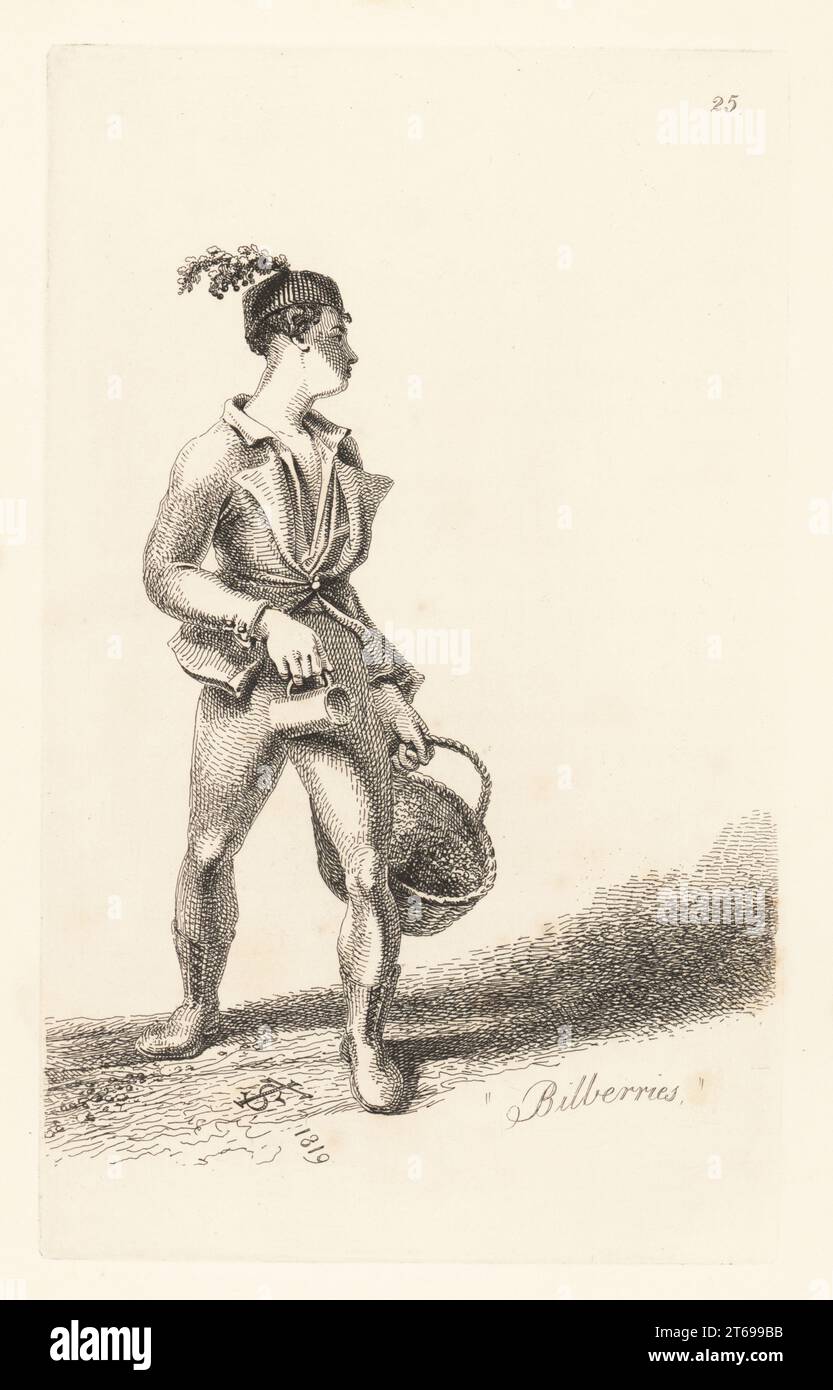 Itinerant billberry seller with basket of berries and cup. In cap with sprig of green, short jacket, tight trousers, boots. The fashion for the fruit started in the late 18th century, mostly from Hertfordshire. Billberries. Copperplate engraving drawn from life and engraved by John Thomas Smith from his own The Cries of London, or Vagabondiana 2, edited by Francis Douce, John Bowyer Nichols, London, 1839. Stock Photohttps://www.alamy.com/image-license-details/?v=1https://www.alamy.com/itinerant-billberry-seller-with-basket-of-berries-and-cup-in-cap-with-sprig-of-green-short-jacket-tight-trousers-boots-the-fashion-for-the-fruit-started-in-the-late-18th-century-mostly-from-hertfordshire-billberries-copperplate-engraving-drawn-from-life-and-engraved-by-john-thomas-smith-from-his-own-the-cries-of-london-or-vagabondiana-2-edited-by-francis-douce-john-bowyer-nichols-london-1839-image571835023.html
Itinerant billberry seller with basket of berries and cup. In cap with sprig of green, short jacket, tight trousers, boots. The fashion for the fruit started in the late 18th century, mostly from Hertfordshire. Billberries. Copperplate engraving drawn from life and engraved by John Thomas Smith from his own The Cries of London, or Vagabondiana 2, edited by Francis Douce, John Bowyer Nichols, London, 1839. Stock Photohttps://www.alamy.com/image-license-details/?v=1https://www.alamy.com/itinerant-billberry-seller-with-basket-of-berries-and-cup-in-cap-with-sprig-of-green-short-jacket-tight-trousers-boots-the-fashion-for-the-fruit-started-in-the-late-18th-century-mostly-from-hertfordshire-billberries-copperplate-engraving-drawn-from-life-and-engraved-by-john-thomas-smith-from-his-own-the-cries-of-london-or-vagabondiana-2-edited-by-francis-douce-john-bowyer-nichols-london-1839-image571835023.htmlRM2T699BB–Itinerant billberry seller with basket of berries and cup. In cap with sprig of green, short jacket, tight trousers, boots. The fashion for the fruit started in the late 18th century, mostly from Hertfordshire. Billberries. Copperplate engraving drawn from life and engraved by John Thomas Smith from his own The Cries of London, or Vagabondiana 2, edited by Francis Douce, John Bowyer Nichols, London, 1839.
 'Last dying speech and Confession', plate III of Cries of London, 1799. Artist: H Merke Stock Photohttps://www.alamy.com/image-license-details/?v=1https://www.alamy.com/last-dying-speech-and-confession-plate-iii-of-cries-of-london-1799-image60089371.html
'Last dying speech and Confession', plate III of Cries of London, 1799. Artist: H Merke Stock Photohttps://www.alamy.com/image-license-details/?v=1https://www.alamy.com/last-dying-speech-and-confession-plate-iii-of-cries-of-london-1799-image60089371.htmlRMDDN8GY–'Last dying speech and Confession', plate III of Cries of London, 1799. Artist: H Merke
 Ellis Davy's Almshouses, Croydon, Surrey, c1800. Artist: John Hassell Stock Photohttps://www.alamy.com/image-license-details/?v=1https://www.alamy.com/stock-photo-ellis-davys-almshouses-croydon-surrey-c1800-artist-john-hassell-28169007.html
Ellis Davy's Almshouses, Croydon, Surrey, c1800. Artist: John Hassell Stock Photohttps://www.alamy.com/image-license-details/?v=1https://www.alamy.com/stock-photo-ellis-davys-almshouses-croydon-surrey-c1800-artist-john-hassell-28169007.htmlRMBHR5RY–Ellis Davy's Almshouses, Croydon, Surrey, c1800. Artist: John Hassell
 centre: Aled Hall (The Abbe) in ANDREA CHENIER at the The Royal Opera, Covent Garden, London WC2 30/05/2024 music: Umberto Giordano libretto: Luigi Illica conductor: Antonio Pappano design: Robert Jones costumes: Jenny Tiramani lighting: Adam Silverman original choreography & movement: Andrew George revival choreographer: Agurtzane Arrien original director: David McVicar revival director: Thomas Guthrie Stock Photohttps://www.alamy.com/image-license-details/?v=1https://www.alamy.com/centre-aled-hall-the-abbe-in-andrea-chenier-at-the-the-royal-opera-covent-garden-london-wc2-30052024-music-umberto-giordano-libretto-luigi-illica-conductor-antonio-pappano-design-robert-jones-costumes-jenny-tiramani-lighting-adam-silverman-original-choreography-movement-andrew-george-revival-choreographer-agurtzane-arrien-original-director-david-mcvicar-revival-director-thomas-guthrie-image609366000.html
centre: Aled Hall (The Abbe) in ANDREA CHENIER at the The Royal Opera, Covent Garden, London WC2 30/05/2024 music: Umberto Giordano libretto: Luigi Illica conductor: Antonio Pappano design: Robert Jones costumes: Jenny Tiramani lighting: Adam Silverman original choreography & movement: Andrew George revival choreographer: Agurtzane Arrien original director: David McVicar revival director: Thomas Guthrie Stock Photohttps://www.alamy.com/image-license-details/?v=1https://www.alamy.com/centre-aled-hall-the-abbe-in-andrea-chenier-at-the-the-royal-opera-covent-garden-london-wc2-30052024-music-umberto-giordano-libretto-luigi-illica-conductor-antonio-pappano-design-robert-jones-costumes-jenny-tiramani-lighting-adam-silverman-original-choreography-movement-andrew-george-revival-choreographer-agurtzane-arrien-original-director-david-mcvicar-revival-director-thomas-guthrie-image609366000.htmlRM2XBB0FC–centre: Aled Hall (The Abbe) in ANDREA CHENIER at the The Royal Opera, Covent Garden, London WC2 30/05/2024 music: Umberto Giordano libretto: Luigi Illica conductor: Antonio Pappano design: Robert Jones costumes: Jenny Tiramani lighting: Adam Silverman original choreography & movement: Andrew George revival choreographer: Agurtzane Arrien original director: David McVicar revival director: Thomas Guthrie
 18th century Child token, given to the Foundling Hospital in London. Mothers left tokens with their babies, so that, if circumstances improved for them, the mothers could reclaim their children. The Foundling Hospital in London, England, was founded in 1739 by the philanthropic sea captain Thomas Coram. It was a children's home established for the 'education and maintenance of exposed and deserted young children Stock Photohttps://www.alamy.com/image-license-details/?v=1https://www.alamy.com/18th-century-child-token-given-to-the-foundling-hospital-in-london-mothers-left-tokens-with-their-babies-so-that-if-circumstances-improved-for-them-the-mothers-could-reclaim-their-children-the-foundling-hospital-in-london-england-was-founded-in-1739-by-the-philanthropic-sea-captain-thomas-coram-it-was-a-childrens-home-established-for-the-education-and-maintenance-of-exposed-and-deserted-young-children-image240279818.html
18th century Child token, given to the Foundling Hospital in London. Mothers left tokens with their babies, so that, if circumstances improved for them, the mothers could reclaim their children. The Foundling Hospital in London, England, was founded in 1739 by the philanthropic sea captain Thomas Coram. It was a children's home established for the 'education and maintenance of exposed and deserted young children Stock Photohttps://www.alamy.com/image-license-details/?v=1https://www.alamy.com/18th-century-child-token-given-to-the-foundling-hospital-in-london-mothers-left-tokens-with-their-babies-so-that-if-circumstances-improved-for-them-the-mothers-could-reclaim-their-children-the-foundling-hospital-in-london-england-was-founded-in-1739-by-the-philanthropic-sea-captain-thomas-coram-it-was-a-childrens-home-established-for-the-education-and-maintenance-of-exposed-and-deserted-young-children-image240279818.htmlRMRXWKA2–18th century Child token, given to the Foundling Hospital in London. Mothers left tokens with their babies, so that, if circumstances improved for them, the mothers could reclaim their children. The Foundling Hospital in London, England, was founded in 1739 by the philanthropic sea captain Thomas Coram. It was a children's home established for the 'education and maintenance of exposed and deserted young children
 Captain Thomas Coram. Artist: After William Hogarth (British, London 1697-1764 London). Engraver: William Nutter (British, 1754/59-1802). Publisher: Robert Cribb (British, 1755-1827). Sitter: Thomas Coram (British, Lyme Regis, Dorset 1668-1751 London). Date: December 1, 1796. Museum: Metropolitan Museum of Art, New York, USA. Stock Photohttps://www.alamy.com/image-license-details/?v=1https://www.alamy.com/captain-thomas-coram-artist-after-william-hogarth-british-london-1697-1764-london-engraver-william-nutter-british-175459-1802-publisher-robert-cribb-british-1755-1827-sitter-thomas-coram-british-lyme-regis-dorset-1668-1751-london-date-december-1-1796-museum-metropolitan-museum-of-art-new-york-usa-image220464358.html
Captain Thomas Coram. Artist: After William Hogarth (British, London 1697-1764 London). Engraver: William Nutter (British, 1754/59-1802). Publisher: Robert Cribb (British, 1755-1827). Sitter: Thomas Coram (British, Lyme Regis, Dorset 1668-1751 London). Date: December 1, 1796. Museum: Metropolitan Museum of Art, New York, USA. Stock Photohttps://www.alamy.com/image-license-details/?v=1https://www.alamy.com/captain-thomas-coram-artist-after-william-hogarth-british-london-1697-1764-london-engraver-william-nutter-british-175459-1802-publisher-robert-cribb-british-1755-1827-sitter-thomas-coram-british-lyme-regis-dorset-1668-1751-london-date-december-1-1796-museum-metropolitan-museum-of-art-new-york-usa-image220464358.htmlRMPPK0F2–Captain Thomas Coram. Artist: After William Hogarth (British, London 1697-1764 London). Engraver: William Nutter (British, 1754/59-1802). Publisher: Robert Cribb (British, 1755-1827). Sitter: Thomas Coram (British, Lyme Regis, Dorset 1668-1751 London). Date: December 1, 1796. Museum: Metropolitan Museum of Art, New York, USA.
 'Fable V, the beau and the beggar ...', c1770. Artist: I Smith Stock Photohttps://www.alamy.com/image-license-details/?v=1https://www.alamy.com/fable-v-the-beau-and-the-beggar-c1770-artist-i-smith-image60163735.html
'Fable V, the beau and the beggar ...', c1770. Artist: I Smith Stock Photohttps://www.alamy.com/image-license-details/?v=1https://www.alamy.com/fable-v-the-beau-and-the-beggar-c1770-artist-i-smith-image60163735.htmlRMDDTKCR–'Fable V, the beau and the beggar ...', c1770. Artist: I Smith
 Jonas Kaufmann (Andrea Chenier) in ANDREA CHENIER at the The Royal Opera, Covent Garden, London WC2 30/05/2024 music: Umberto Giordano libretto: Luigi Illica conductor: Antonio Pappano design: Robert Jones costumes: Jenny Tiramani lighting: Adam Silverman original choreography & movement: Andrew George revival choreographer: Agurtzane Arrien original director: David McVicar revival director: Thomas Guthrie Stock Photohttps://www.alamy.com/image-license-details/?v=1https://www.alamy.com/jonas-kaufmann-andrea-chenier-in-andrea-chenier-at-the-the-royal-opera-covent-garden-london-wc2-30052024-music-umberto-giordano-libretto-luigi-illica-conductor-antonio-pappano-design-robert-jones-costumes-jenny-tiramani-lighting-adam-silverman-original-choreography-movement-andrew-george-revival-choreographer-agurtzane-arrien-original-director-david-mcvicar-revival-director-thomas-guthrie-image608323108.html
Jonas Kaufmann (Andrea Chenier) in ANDREA CHENIER at the The Royal Opera, Covent Garden, London WC2 30/05/2024 music: Umberto Giordano libretto: Luigi Illica conductor: Antonio Pappano design: Robert Jones costumes: Jenny Tiramani lighting: Adam Silverman original choreography & movement: Andrew George revival choreographer: Agurtzane Arrien original director: David McVicar revival director: Thomas Guthrie Stock Photohttps://www.alamy.com/image-license-details/?v=1https://www.alamy.com/jonas-kaufmann-andrea-chenier-in-andrea-chenier-at-the-the-royal-opera-covent-garden-london-wc2-30052024-music-umberto-giordano-libretto-luigi-illica-conductor-antonio-pappano-design-robert-jones-costumes-jenny-tiramani-lighting-adam-silverman-original-choreography-movement-andrew-george-revival-choreographer-agurtzane-arrien-original-director-david-mcvicar-revival-director-thomas-guthrie-image608323108.htmlRM2X9KE98–Jonas Kaufmann (Andrea Chenier) in ANDREA CHENIER at the The Royal Opera, Covent Garden, London WC2 30/05/2024 music: Umberto Giordano libretto: Luigi Illica conductor: Antonio Pappano design: Robert Jones costumes: Jenny Tiramani lighting: Adam Silverman original choreography & movement: Andrew George revival choreographer: Agurtzane Arrien original director: David McVicar revival director: Thomas Guthrie
 'Morning', plate I from Times of Day, 1738. Artist: William Hogarth Stock Photohttps://www.alamy.com/image-license-details/?v=1https://www.alamy.com/morning-plate-i-from-times-of-day-1738-artist-william-hogarth-image60284102.html
'Morning', plate I from Times of Day, 1738. Artist: William Hogarth Stock Photohttps://www.alamy.com/image-license-details/?v=1https://www.alamy.com/morning-plate-i-from-times-of-day-1738-artist-william-hogarth-image60284102.htmlRMDE24YJ–'Morning', plate I from Times of Day, 1738. Artist: William Hogarth
 'A Rake's Progress', 1735; plate VI of VIII. Artist: William Hogarth Stock Photohttps://www.alamy.com/image-license-details/?v=1https://www.alamy.com/a-rakes-progress-1735-plate-vi-of-viii-artist-william-hogarth-image60075836.html
'A Rake's Progress', 1735; plate VI of VIII. Artist: William Hogarth Stock Photohttps://www.alamy.com/image-license-details/?v=1https://www.alamy.com/a-rakes-progress-1735-plate-vi-of-viii-artist-william-hogarth-image60075836.htmlRMDDMK9G–'A Rake's Progress', 1735; plate VI of VIII. Artist: William Hogarth
 'Noon', plate II from Times of Day, 1738. Artist: William Hogarth Stock Photohttps://www.alamy.com/image-license-details/?v=1https://www.alamy.com/noon-plate-ii-from-times-of-day-1738-artist-william-hogarth-image60075606.html
'Noon', plate II from Times of Day, 1738. Artist: William Hogarth Stock Photohttps://www.alamy.com/image-license-details/?v=1https://www.alamy.com/noon-plate-ii-from-times-of-day-1738-artist-william-hogarth-image60075606.htmlRMDDMK1A–'Noon', plate II from Times of Day, 1738. Artist: William Hogarth

